How to write a whole research paper in a week

Writing up a full research article in a single week? Maybe you think that’s impossible. Yet I have done it repeatedly, and so have students in my courses. This is an exceptionally joyful (even if demanding) experience: being so productive just feels great! You are not wasting any time, and a paper produced in one go is typically coherent and nice to read. Even if you are a slow writer, you can write a whole paper in a single week — if you follow my strategy. Read below about what you need to prepare and how to approach this project.
I wrote my first scientific research article in 7 days. It started as a desperate effort to stop my procrastination and “just do it”. But I was surprised what a positive experience it was: focused and efficient, I was making daily progress, feeling motivated and content. Finally, the fruits of my hard work were gaining shape — and they did it so quickly!
I realized it was highly effective to write up a paper like this: writing for the whole day, every day until the first draft was finished. My writing project was firmly present in my mind — I didn’t lose time catching up with what I have written in the last session. Since I was not doing anything else, my wandering mind settled in very fast, and I was getting into a routine. The daily progress was clearly visible and motivated me to continue. And the result was a coherent paper that was easy to revise.
Meanwhile, this paper-a-week approach is my favorite. That’s how I write my papers, and that’s what I teach to students. In on-site courses young scientists draft a whole paper in 5 days, writing one major section per day. At the beginning of the week, many participants have doubts. But at the end of the week, they are all excited to see how much they managed to write in just a single week.
If you would also like to try out this approach, then read on about the necessary preparations, the optimal setting, and a productive writing strategy.
If you would like to get support during the preparation, drafting and revising of your research article, check out my online course Write Up Your Paper .

Prepare well

- First, think about your audience and pick a suitable journal . This is an important step because the audience and journal determine the content & style of your paper. As a reference, pick two recent papers on a similar topic published in your target journal.
- Create a storyline for your paper. What is the main message you want to convey, and how are you going to present your results?
- Put together all the results that you need to present your story convincingly: collect the necessary data, finish analyses, and create figures and tables.
- Select and read the relevant background literature as well as studies you want to compare your work with. As you read, note down any point that comes to your mind as something to be mentioned in the Introduction or Discussion section.
- Draft a preliminary Abstract : it will help you keep the direction and not get distracted by secondary ideas as you write the individual sections.
Depending on how complete your results already are, you might need 2-4 weeks to finish all these preparations. To help you keep an overview, I created a checklist with detailed steps that you need to take before you attempt to write up your paper in a week. Subscribe to our Newsletter and get your copy of the checklist.
Reserve a whole week for writing
Now, writing a paper in a single week is a serious business. You can’t do it if you don’t focus solely on the writing and create good writing conditions. Therefore, I recommend the following settings:
- Find a place where you can write without distractions. I have written my first paper over the Easter holidays when there was nobody in the office. You might choose to write at home or in a library. Though if possible, the best is to go for a retreat: removing yourself from your everyday settings immensely helps focus on the writing.
- Cancel (all) social obligations for the week. While it’s crucial to relax in the evening, you want to avoid disturbances associated with social events. Anything that makes your thoughts drift away from your work because it requires planning, exchanging of messages with others, or simply because it’s too exciting is better left for some other week. On the other hand, a quiet meeting with a good friend over a glass of wine or beer might be just the perfect way to unwind and rest after a productive, yet exhausting day of writing.
- Get support from the partner, family or friends — if possible. It’s best when you don’t need to run errands, cook and clean during this week. If you live alone, you can probably easily arrange yourself for undisturbed work. If you live with other people, ask them for consideration and support.
What I described above are the *ideal* conditions for undisturbed writing. But don’t give up if you can’t create such conditions for yourself. Work with what is possible — maybe it will take you 7-8 instead of 5-6 days but that’s still a great result, right?
Do you need to revise & polish your manuscript or thesis but don’t know where to begin?
Get your Revision Checklist
Click here for an efficient step-by-step revision of your scientific texts.
Maybe you think that you can never ever draft a research article in a single week. Because you write so slowly, producing only few paragraphs per day. Well — I agree that if you don’t optimize your writing strategy, it would be hard to impossible to write up a whole paper in a week.
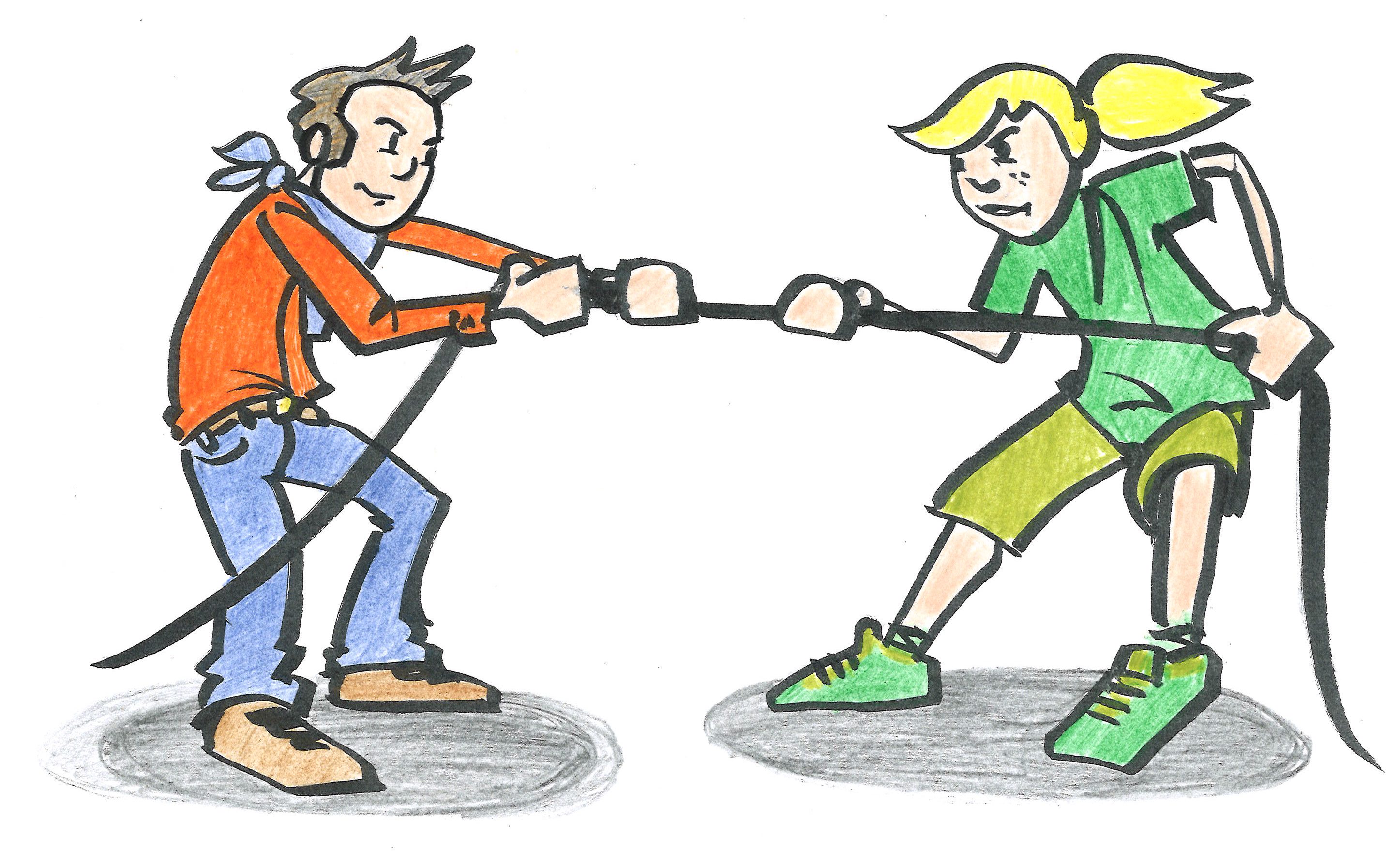
- Separate the processes of writing and revising. That’s the most important principle. Resist the urge to revise as you write the first draft. Moreover, don’t interrupt your writing to look up missing information. Work with placeholders instead. This allows you to get into the state of flow and proceed much faster than you can imagine.
- Start your writing day with 10 minutes of freewriting . Write without stopping about anything that comes to your mind. This helps you to warm up for writing, clear your head of any unrelated thoughts, and get into the mood of writing without editing.
- Take regular power breaks. I recommend to follow the Pomodoro technique : write for 25 minutes and then take a 5-minute break. After 3-4 such sessions take a longer break of 0.5-1 hour. During the breaks get up, walk a bit, stretch, look around, and breathe deeply. These breaks help you sustain high focus and productivity throughout the whole day.
- Eat and sleep well. What you are doing is similar to a professional athlete. So take care of your brain and body, and they will serve you well.
- Reward yourself. Every day celebrate the progress you have made. You have full right to be proud of you!
Write the individual sections in a reasonable order
If you have written a research paper before, you have probably realized that starting with the Introduction and finishing with the Discussion is not the ideal order in which to tackle the individual sections. Instead, I recommend the following procedure:

- Start with the Methods section. This is the easiest section to write, so it’s great as a warm-up, to get into writing without the need to think (and procrastinate ;)) too much. Look at your figures and tables: what methods did you use to create them? Then describe your methods, one after another.
- Results section: Writing the Methods section refreshes your memory about the research you have done. So writing the Results section next should not be too hard: Take one display object (figure or table) after another, and describe the results they contain. While you do so, you will come across points that need to be discussed in the Discussion section. Note them down so you don’t forget them.
- Introduction : When your results are fresh in your mind, you are in a great position to write the Introduction — because the Introduction should contain selected information that gives the reader context for your research project and allows them to understand your results and their implications.
- Discussion : When you have taken notes while writing the Results section, the Discussion section should be quite easy to draft. Don’t worry too early about the order in which you want to discuss the individual points. Write one paragraph for each point , and then see how you can logically arrange them.
- Abstract and title : On the last day, revise the preliminary Abstract or write a new one. You could also take a break of a few days before tackling the Abstract, to gain clarity and distance. Generate multiple titles (I recommend 6-10), so that you and your co-authors can choose the most appropriate one.
Just do it!

Once you have written the whole draft, let it sit for a week or two, and then revise it. Follow my tips for efficient revising and get your revision checklist that will guide you step-by-step through the whole process.
Now I am curious about your experience: Have you ever written up an academic article quickly? How did you do it? Please, share with us your tips & strategies!
Do you need to revise & polish your manuscript or thesis but don’t know where to begin? Is your text a mess and you don't know how to improve it?
Click here for an efficient step-by-step revision of your scientific texts. You will be guided through each step with concrete tips for execution.
7 thoughts on “ How to write a whole research paper in a week ”
Thank for your guide and suggestion. It gives to me very precious ways how to write a article. Now I am writing a article related to Buddhist studies. Thank you so much.
You are welcome!
excellent! it helped me a lot! wish you all best
Hi Parham, I’m happy to hear that!
I have never written any paper before. As I am from very old school.
But my writing skill is actually very good. Your help is definitely going to help me as this has inspired me alot. Will let you know, once done. I really like the outline that you have given. Basically you have made it so easy for me .
Hope fully will be in touch with you soon.
Thanks and ki d Regards, Shehla
Dear Shehla, that sounds great! I’m looking forward to hearing about your paper!
Comments are closed.
Diese Webseite verwendet Cookies, um Ihnen ein besseres Nutzererlebnis zu bieten. Wenn Sie die Seite weiternutzen, stimmen Sie der Cookie-Nutzung zu.
How to Write a Research Paper in a Day: Step-by-Step Guide
Julie Peterson
As all other students, you put a lot of effort into studying and writing homework assignments. You do your best to complete every single project on time. Unfortunately, that’s not always possible.
Research papers are long-term assignments. Your professors advise you to start early, and you try to do that. However, you have to think about tests and other assignments. Plus, you can’t stay in the library forever when you should also work on your social life.
Sooner or later, every student ends up in the same situation: the deadline is too close and the research paper is nowhere near finished. There are two usual reasons that lead to that scenario:
1) You forgot all about this project. You were too occupied with studying and classes. You didn’t set a reminder on your calendar, and your teacher just reminded you that the deadline is tomorrow .
2) You kept procrastinating. The topic seemed simple enough, so you thought you had enough time. The day before the deadline, you’re facing the harsh reality: a research paper is more complex than it seems.
1. First Thing’s First: Calm Down!
What’s the first thing you do when you realize you have very little time to complete a whole research paper? Panic! It’s the usual reaction. You start saying to yourself:
- “There’s no way I can do this!”
- “It’s just impossible.”
- “Oh my God, what am I gonna do?”
That’s the wrong approach to have. Panic will block you from achieving your full potential. The first thing you need to do is relax . You forgot about that paper. Now, you’re left with a tight deadline. That’s okay. You still have time and you can still do something about it.
Close your eyes. Take a deep breath. Then, repeat to yourself:
- “I can do this. I will research and write whole day. I’ll get it done by tomorrow.”
That positive self-talk will prepare your mind for the challenge that follows. Eat something nice, make yourself some coffee and get to work. If necessary, take a 20-minute power nap before you proceed with the following steps.
2. Use the Pomodoro Technique
When you have to stay focused on a challenging task, it’s important to have a system. The Pomodoro Technique is a pretty effective method that helps you do more work in less time. It’s based on a simple principle:
- You work for 25 minutes straight, with no distractions.
- After the work session, you take a 5-minute break.
It sounds pretty simple, but it works. Twenty five minutes doesn’t seem like a long time. Your mind can stay focused on the task at hand without much effort. After the short break, you’ll be able to get back to work.
If you start writing the paper without such system, the task will seem overwhelming. With the Pomodoro Technique, you’re giving yourself small steps towards the ultimate goal.
You can use a browser extension like Strict Workflow to keep track of your working and resting session. It’s great because it blocks your access to distracting websites during the working session. When you give yourself a break of 5 minutes, you can check what’s new on Twitter.
3. Start With Brainstorming
Before you get to work, you’ll need to get an idea. How do you want this paper to look like? Go through a brief brainstorming stage, so you’ll form an outline to guide you to the process of research and writing.
- Your teacher gave you a prompt for the research paper. Focus on it. What ideas do you get?
- Make a list of a few possible topics. The brainstorming stage doesn’t need much thinking. You just write whatever comes to your mind.
- Now, do a preliminary research on those topics. It shouldn’t take much time. Give 5 minutes to each idea you have. What topic gives you the greatest foundation for research? That’s what you should focus on.
- First, form your thesis statement. It’s something you will prove throughout the research paper. The preliminary research provided you with enough resources. Keep in mind that professors don’t like broad thesis statement. If, for example, the prompt was related to World War 2, you’ll have to narrow it down. You can opt for a specific event during the war, or even explore the Italian uniforms. Whatever it is, you need to make it very specific.
- Think of at least 3-4 subtopics. When you focus on the main topic, what questions do you have? You’ll want to answer those questions through the subtopics. That will be the body of your research paper.
- Finally, the outline should include a conclusion, which will sum up the claims and connect the loose ends.
4. Now, Onto the Research!
Here is an important piece of advice: don’t research as you write. When you’re working on a serious research paper, you need to explore many resources that will help you get ideas and form opinions. This should be a separate stage. Since you have only one day to write this paper, you can give yourself 2 hours for the research. Here are few tips to consider:
- Use Google Scholar instead of the usual Google search engine. It gives you access to high-quality scientific and academic sources. Only authoritative sources will make the paper look serious and well-researched.
- Keep track of all online sources you collect. You will need to reference them. Otherwise, you’ll be guilty of plagiarism. You can create a private Pinterest board, where you’ll collect all materials you plan to use. As for the referencing, you can use a free citation generator , which will save you a lot of time.
- Take notes! You can’t expect to remember everything you read and all ideas you get during this stage. If necessary, update the outline and make it more detailed.
5. Write It!
Finally, you’ve come down to the writing part. You might want to take a break before this stage. Have another cup of coffee and an energizing meal.
- Again: relax! You have an outline with good ideas. You have enough resources to work with. At this stage, you should just bring everything together, and that won’t take more than 4 hours.
- You don’t have to start with the introduction. Many students find it easier to write the thesis and develop the arguments first. Then, it’s easier to explain what the paper is about in the introductory part.
- Don’t think much about the style and grammar at first. This is your first draft, which will go through changes later on. Focus on expressing your ideas in a logical way.
- Support your arguments with quotes from the resources you have. They will add strength to the claims.
- Use simple, clear language. Don’t try to make a good impression by writing endless sentences and using words you just found in the dictionary. You don’t need complex style to show you know what you’re writing about.
- Don’t leave the references last. Cite the sources as you go!
- Keep up with the Pomodoro method while you write. If you feel exhausted and you need a longer break, take a power nap and you’ll continue later.
6. Don’t Forget the Editing
You’re almost done, but it’s not time to celebrate just yet. When you finish writing the research paper, it’s important to take a break. You must be hungry, so get something to eat. Try not to think about the paper for at least one hour. When you go back to it, the mistakes will be more obvious.
SEE: Top 6 Editing Tools for College Students
- Get rid of sentences and paragraphs that are not directly related to the thesis statement and subtopics.
- Add more information when you notice gaps in the logical flow.
- Pay attention to the citations. You have to format them in accordance with the required referencing style.
- Proofread! Once you’re done fixing the major aspects of the paper, you can do the last reading. At this point, focus on the grammar, spelling, and punctuation.
Now, you can congratulate yourself. You made it! You wrote an entire research paper in a single day. It’s not smart to procrastinate until the last day. However, it’s not impossible to write a paper in such a short timeframe. Now, have a good sleep. You deserve it.

FREE 6-month trial
Then, enjoy Amazon Prime at half the price – 50% off!
TUN AI – Your Education Assistant

I’m here to help you with scholarships, college search, online classes, financial aid, choosing majors, college admissions and study tips!
TUN Helps Students!
Resource content.
Resources for Students
School Search
Scholarships
Scholarship Search
Start a Scholarship
High School
Copyright, 2024 – TUN, Inc
Student Tools
Free Online Courses
Student Discounts
Back to School
Internships

Princeton Correspondents on Undergraduate Research
How to Write a Paper in Two Days: A Timeline
Last week, Yuem wrote about keeping track of his progress on his senior thesis —a project with distant deadlines. As an underclassman, I usually face shorter-term deadlines for class essays and problem sets, and these require a similar, but condensed approach.
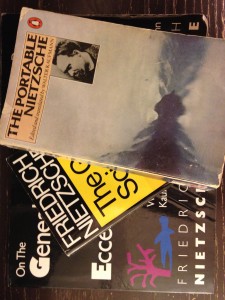
This post has real-life inspiration. Next Thursday, I have a paper due for my philosophy class on Nietzsche. Weekdays are busy with problem sets and assignments. I do not expect myself to start consolidating material for the paper till this weekend, which leaves me plenty of time to plan an effective essay.
Here’s the schedule I successfully used last time, when I was looking at parts of Nietzsche’s Thus Spoke Zarathustra and the Gay Science. Granted, the whole process I’m proposing is longer than just two days, but I promise if you use the pre-writing steps I suggest, you’ll be able to do the actual writing in a much shorter period of time!
5 Days before Due Date: Finish the core readings!
I spent about half of my weekend finishing the readings for the class that I had not been able to finish in time for lecture. Surprisingly few people realize how helpful this is. In a paper-based class, certain prompts will lend themselves to specific readings. You can write a decent paper–maybe even get a “good grade”– by reading only what is absolutely necessary for a paper, but it will fall far short of your potential. You are surrounded by world-class facilities and faculty–don’t waste your time on something sub-par. The best part about writing a paper is finding unexpected connections, after all.
4 Days before Due Date: Summarize the readings.
After I finished reading and highlighting parts of the books, I sat down with a notebook and wrote down the gist of each section using what I had previously marked in the books. I used to do this as I read, but found it to take a long time to finish the process. Now, I read in whatever small bursts of time I have, and revisit my books to quickly take notes in one go using what I have highlighted. Now, I had a short summary of the assigned works in front of me as a map of what to reference.
3 Days before Due Date: Finalize essay topic and write an outline.
I narrowed my essay topics down to two, and drafted points I had in mind for each one. I did some outside research as well, and chose the topic I felt better prepared with. I started to construct an outline by selecting relevant quotes (using my summary of notes) and finally had a blocked version of evidence for different points in the paper. At this point, I started to work around the pieces of evidence I had written down and formulate logical arguments and transitions.
2 Days before Due Date: Talk to my professor, revise outline, and start writing!
By this point, I realized what crucial questions I had for my professor. I ran through some of the main points I was going to make in the paper and discovered that a few of them were faulty. I adapted accordingly and started to write!
Writing an eight page paper in two days was surprisingly easy with a well-developed outline. Do yourself a favor and spend the bulk of your time in the “planning” stage of an essay: reading, summarizing, outlining, and discussing ideas with classmates and professors. The actual writing process will be a matter of a few hours spent at your computer transferring thoughts from outline to paper in a format that flows well. Have a friend or two help you edit your paper, and you will emerge feeling rewarded.
— Vidushi Sharma, Humanities Correspondent
Share this:
- Share on Tumblr


Peer Recognized
Make a name in academia
How to Write a Research Paper: the LEAP approach (+cheat sheet)
In this article I will show you how to write a research paper using the four LEAP writing steps. The LEAP academic writing approach is a step-by-step method for turning research results into a published paper .
The LEAP writing approach has been the cornerstone of the 70 + research papers that I have authored and the 3700+ citations these paper have accumulated within 9 years since the completion of my PhD. I hope the LEAP approach will help you just as much as it has helped me to make an real, tangible impact with my research.
What is the LEAP research paper writing approach?
I designed the LEAP writing approach not only for merely writing the papers. My goal with the writing system was to show young scientists how to first think about research results and then how to efficiently write each section of the research paper.
In other words, you will see how to write a research paper by first analyzing the results and then building a logical, persuasive arguments. In this way, instead of being afraid of writing research paper, you will be able to rely on the paper writing process to help you with what is the most demanding task in getting published – thinking.
The four research paper writing steps according to the LEAP approach:

I will show each of these steps in detail. And you will be able to download the LEAP cheat sheet for using with every paper you write.
But before I tell you how to efficiently write a research paper, I want to show you what is the problem with the way scientists typically write a research paper and why the LEAP approach is more efficient.
How scientists typically write a research paper (and why it isn’t efficient)
Writing a research paper can be tough, especially for a young scientist. Your reasoning needs to be persuasive and thorough enough to convince readers of your arguments. The description has to be derived from research evidence, from prior art, and from your own judgment. This is a tough feat to accomplish.
The figure below shows the sequence of the different parts of a typical research paper. Depending on the scientific journal, some sections might be merged or nonexistent, but the general outline of a research paper will remain very similar.

Here is the problem: Most people make the mistake of writing in this same sequence.
While the structure of scientific articles is designed to help the reader follow the research, it does little to help the scientist write the paper. This is because the layout of research articles starts with the broad (introduction) and narrows down to the specifics (results). See in the figure below how the research paper is structured in terms of the breath of information that each section entails.
How to write a research paper according to the LEAP approach
For a scientist, it is much easier to start writing a research paper with laying out the facts in the narrow sections (i.e. results), step back to describe them (i.e. write the discussion), and step back again to explain the broader picture in the introduction.
For example, it might feel intimidating to start writing a research paper by explaining your research’s global significance in the introduction, while it is easy to plot the figures in the results. When plotting the results, there is not much room for wiggle: the results are what they are.
Starting to write a research papers from the results is also more fun because you finally get to see and understand the complete picture of the research that you have worked on.
Most importantly, following the LEAP approach will help you first make sense of the results yourself and then clearly communicate them to the readers. That is because the sequence of writing allows you to slowly understand the meaning of the results and then develop arguments for presenting to your readers.
I have personally been able to write and submit a research article in three short days using this method.
Step 1: Lay Out the Facts

You have worked long hours on a research project that has produced results and are no doubt curious to determine what they exactly mean. There is no better way to do this than by preparing figures, graphics and tables. This is what the first LEAP step is focused on – diving into the results.
How to p repare charts and tables for a research paper
Your first task is to try out different ways of visually demonstrating the research results. In many fields, the central items of a journal paper will be charts that are based on the data generated during research. In other fields, these might be conceptual diagrams, microscopy images, schematics and a number of other types of scientific graphics which should visually communicate the research study and its results to the readers. If you have reasonably small number of data points, data tables might be useful as well.
Tips for preparing charts and tables
- Try multiple chart types but in the finished paper only use the one that best conveys the message you want to present to the readers
- Follow the eight chart design progressions for selecting and refining a data chart for your paper: https://peerrecognized.com/chart-progressions
- Prepare scientific graphics and visualizations for your paper using the scientific graphic design cheat sheet: https://peerrecognized.com/tools-for-creating-scientific-illustrations/
How to describe the results of your research
Now that you have your data charts, graphics and tables laid out in front of you – describe what you see in them. Seek to answer the question: What have I found? Your statements should progress in a logical sequence and be backed by the visual information. Since, at this point, you are simply explaining what everyone should be able to see for themselves, you can use a declarative tone: The figure X demonstrates that…
Tips for describing the research results :
- Answer the question: “ What have I found? “
- Use declarative tone since you are simply describing observations
Step 2: Explain the results

The core aspect of your research paper is not actually the results; it is the explanation of their meaning. In the second LEAP step, you will do some heavy lifting by guiding the readers through the results using logic backed by previous scientific research.
How to define the Message of a research paper
To define the central message of your research paper, imagine how you would explain your research to a colleague in 20 seconds . If you succeed in effectively communicating your paper’s message, a reader should be able to recount your findings in a similarly concise way even a year after reading it. This clarity will increase the chances that someone uses the knowledge you generated, which in turn raises the likelihood of citations to your research paper.
Tips for defining the paper’s central message :
- Write the paper’s core message in a single sentence or two bullet points
- Write the core message in the header of the research paper manuscript
How to write the Discussion section of a research paper
In the discussion section you have to demonstrate why your research paper is worthy of publishing. In other words, you must now answer the all-important So what? question . How well you do so will ultimately define the success of your research paper.
Here are three steps to get started with writing the discussion section:
- Write bullet points of the things that convey the central message of the research article (these may evolve into subheadings later on).
- Make a list with the arguments or observations that support each idea.
- Finally, expand on each point to make full sentences and paragraphs.
Tips for writing the discussion section:
- What is the meaning of the results?
- Was the hypothesis confirmed?
- Write bullet points that support the core message
- List logical arguments for each bullet point, group them into sections
- Instead of repeating research timeline, use a presentation sequence that best supports your logic
- Convert arguments to full paragraphs; be confident but do not overhype
- Refer to both supportive and contradicting research papers for maximum credibility
How to write the Conclusions of a research paper
Since some readers might just skim through your research paper and turn directly to the conclusions, it is a good idea to make conclusion a standalone piece. In the first few sentences of the conclusions, briefly summarize the methodology and try to avoid using abbreviations (if you do, explain what they mean).
After this introduction, summarize the findings from the discussion section. Either paragraph style or bullet-point style conclusions can be used. I prefer the bullet-point style because it clearly separates the different conclusions and provides an easy-to-digest overview for the casual browser. It also forces me to be more succinct.
Tips for writing the conclusion section :
- Summarize the key findings, starting with the most important one
- Make conclusions standalone (short summary, avoid abbreviations)
- Add an optional take-home message and suggest future research in the last paragraph
How to refine the Objective of a research paper
The objective is a short, clear statement defining the paper’s research goals. It can be included either in the final paragraph of the introduction, or as a separate subsection after the introduction. Avoid writing long paragraphs with in-depth reasoning, references, and explanation of methodology since these belong in other sections. The paper’s objective can often be written in a single crisp sentence.
Tips for writing the objective section :
- The objective should ask the question that is answered by the central message of the research paper
- The research objective should be clear long before writing a paper. At this point, you are simply refining it to make sure it is addressed in the body of the paper.
How to write the Methodology section of your research paper
When writing the methodology section, aim for a depth of explanation that will allow readers to reproduce the study . This means that if you are using a novel method, you will have to describe it thoroughly. If, on the other hand, you applied a standardized method, or used an approach from another paper, it will be enough to briefly describe it with reference to the detailed original source.
Remember to also detail the research population, mention how you ensured representative sampling, and elaborate on what statistical methods you used to analyze the results.
Tips for writing the methodology section :
- Include enough detail to allow reproducing the research
- Provide references if the methods are known
- Create a methodology flow chart to add clarity
- Describe the research population, sampling methodology, statistical methods for result analysis
- Describe what methodology, test methods, materials, and sample groups were used in the research.
Step 3: Advertize the research
Step 3 of the LEAP writing approach is designed to entice the casual browser into reading your research paper. This advertising can be done with an informative title, an intriguing abstract, as well as a thorough explanation of the underlying need for doing the research within the introduction.

How to write the Introduction of a research paper
The introduction section should leave no doubt in the mind of the reader that what you are doing is important and that this work could push scientific knowledge forward. To do this convincingly, you will need to have a good knowledge of what is state-of-the-art in your field. You also need be able to see the bigger picture in order to demonstrate the potential impacts of your research work.
Think of the introduction as a funnel, going from wide to narrow, as shown in the figure below:
- Start with a brief context to explain what do we already know,
- Follow with the motivation for the research study and explain why should we care about it,
- Explain the research gap you are going to bridge within this research paper,
- Describe the approach you will take to solve the problem.

Tips for writing the introduction section :
- Follow the Context – Motivation – Research gap – Approach funnel for writing the introduction
- Explain how others tried and how you plan to solve the research problem
- Do a thorough literature review before writing the introduction
- Start writing the introduction by using your own words, then add references from the literature
How to prepare the Abstract of a research paper
The abstract acts as your paper’s elevator pitch and is therefore best written only after the main text is finished. In this one short paragraph you must convince someone to take on the time-consuming task of reading your whole research article. So, make the paper easy to read, intriguing, and self-explanatory; avoid jargon and abbreviations.
How to structure the abstract of a research paper:
- The abstract is a single paragraph that follows this structure:
- Problem: why did we research this
- Methodology: typically starts with the words “Here we…” that signal the start of own contribution.
- Results: what we found from the research.
- Conclusions: show why are the findings important
How to compose a research paper Title
The title is the ultimate summary of a research paper. It must therefore entice someone looking for information to click on a link to it and continue reading the article. A title is also used for indexing purposes in scientific databases, so a representative and optimized title will play large role in determining if your research paper appears in search results at all.
Tips for coming up with a research paper title:
- Capture curiosity of potential readers using a clear and descriptive title
- Include broad terms that are often searched
- Add details that uniquely identify the researched subject of your research paper
- Avoid jargon and abbreviations
- Use keywords as title extension (instead of duplicating the words) to increase the chance of appearing in search results
How to prepare Highlights and Graphical Abstract
Highlights are three to five short bullet-point style statements that convey the core findings of the research paper. Notice that the focus is on the findings, not on the process of getting there.
A graphical abstract placed next to the textual abstract visually summarizes the entire research paper in a single, easy-to-follow figure. I show how to create a graphical abstract in my book Research Data Visualization and Scientific Graphics.
Tips for preparing highlights and graphical abstract:
- In highlights show core findings of the research paper (instead of what you did in the study).
- In graphical abstract show take-home message or methodology of the research paper. Learn more about creating a graphical abstract in this article.
Step 4: Prepare for submission

Sometimes it seems that nuclear fusion will stop on the star closest to us (read: the sun will stop to shine) before a submitted manuscript is published in a scientific journal. The publication process routinely takes a long time, and after submitting the manuscript you have very little control over what happens. To increase the chances of a quick publication, you must do your homework before submitting the manuscript. In the fourth LEAP step, you make sure that your research paper is published in the most appropriate journal as quickly and painlessly as possible.
How to select a scientific Journal for your research paper
The best way to find a journal for your research paper is it to review which journals you used while preparing your manuscript. This source listing should provide some assurance that your own research paper, once published, will be among similar articles and, thus, among your field’s trusted sources.

After this initial selection of hand-full of scientific journals, consider the following six parameters for selecting the most appropriate journal for your research paper (read this article to review each step in detail):
- Scope and publishing history
- Ranking and Recognition
- Publishing time
- Acceptance rate
- Content requirements
- Access and Fees
How to select a journal for your research paper:
- Use the six parameters to select the most appropriate scientific journal for your research paper
- Use the following tools for journal selection: https://peerrecognized.com/journals
- Follow the journal’s “Authors guide” formatting requirements
How to Edit you manuscript
No one can write a finished research paper on their first attempt. Before submitting, make sure to take a break from your work for a couple of days, or even weeks. Try not to think about the manuscript during this time. Once it has faded from your memory, it is time to return and edit. The pause will allow you to read the manuscript from a fresh perspective and make edits as necessary.
I have summarized the most useful research paper editing tools in this article.
Tips for editing a research paper:
- Take time away from the research paper to forget about it; then returning to edit,
- Start by editing the content: structure, headings, paragraphs, logic, figures
- Continue by editing the grammar and language; perform a thorough language check using academic writing tools
- Read the entire paper out loud and correct what sounds weird
How to write a compelling Cover Letter for your paper
Begin the cover letter by stating the paper’s title and the type of paper you are submitting (review paper, research paper, short communication). Next, concisely explain why your study was performed, what was done, and what the key findings are. State why the results are important and what impact they might have in the field. Make sure you mention how your approach and findings relate to the scope of the journal in order to show why the article would be of interest to the journal’s readers.
I wrote a separate article that explains what to include in a cover letter here. You can also download a cover letter template from the article.
Tips for writing a cover letter:
- Explain how the findings of your research relate to journal’s scope
- Tell what impact the research results will have
- Show why the research paper will interest the journal’s audience
- Add any legal statements as required in journal’s guide for authors
How to Answer the Reviewers
Reviewers will often ask for new experiments, extended discussion, additional details on the experimental setup, and so forth. In principle, your primary winning tactic will be to agree with the reviewers and follow their suggestions whenever possible. After all, you must earn their blessing in order to get your paper published.
Be sure to answer each review query and stick to the point. In the response to the reviewers document write exactly where in the paper you have made any changes. In the paper itself, highlight the changes using a different color. This way the reviewers are less likely to re-read the entire article and suggest new edits.
In cases when you don’t agree with the reviewers, it makes sense to answer more thoroughly. Reviewers are scientifically minded people and so, with enough logical and supported argument, they will eventually be willing to see things your way.
Tips for answering the reviewers:
- Agree with most review comments, but if you don’t, thoroughly explain why
- Highlight changes in the manuscript
- Do not take the comments personally and cool down before answering
The LEAP research paper writing cheat sheet
Imagine that you are back in grad school and preparing to take an exam on the topic: “How to write a research paper”. As an exemplary student, you would, most naturally, create a cheat sheet summarizing the subject… Well, I did it for you.
This one-page summary of the LEAP research paper writing technique will remind you of the key research paper writing steps. Print it out and stick it to a wall in your office so that you can review it whenever you are writing a new research paper.

Now that we have gone through the four LEAP research paper writing steps, I hope you have a good idea of how to write a research paper. It can be an enjoyable process and once you get the hang of it, the four LEAP writing steps should even help you think about and interpret the research results. This process should enable you to write a well-structured, concise, and compelling research paper.
Have fund with writing your next research paper. I hope it will turn out great!
Learn writing papers that get cited
The LEAP writing approach is a blueprint for writing research papers. But to be efficient and write papers that get cited, you need more than that.
My name is Martins Zaumanis and in my interactive course Research Paper Writing Masterclass I will show you how to visualize your research results, frame a message that convinces your readers, and write each section of the paper. Step-by-step.
And of course – you will learn to respond the infamous Reviewer No.2.

Hey! My name is Martins Zaumanis and I am a materials scientist in Switzerland ( Google Scholar ). As the first person in my family with a PhD, I have first-hand experience of the challenges starting scientists face in academia. With this blog, I want to help young researchers succeed in academia. I call the blog “Peer Recognized”, because peer recognition is what lifts academic careers and pushes science forward.
Besides this blog, I have written the Peer Recognized book series and created the Peer Recognized Academy offering interactive online courses.
Related articles:

One comment
- Pingback: Research Paper Outline with Key Sentence Skeleton (+Paper Template)
Leave a Reply Cancel reply
Your email address will not be published. Required fields are marked *
I want to join the Peer Recognized newsletter!
This site uses Akismet to reduce spam. Learn how your comment data is processed .
Privacy Overview
| Cookie | Duration | Description |
|---|---|---|
| cookielawinfo-checkbox-analytics | 11 months | This cookie is set by GDPR Cookie Consent plugin. The cookie is used to store the user consent for the cookies in the category "Analytics". |
| cookielawinfo-checkbox-functional | 11 months | The cookie is set by GDPR cookie consent to record the user consent for the cookies in the category "Functional". |
| cookielawinfo-checkbox-necessary | 11 months | This cookie is set by GDPR Cookie Consent plugin. The cookies is used to store the user consent for the cookies in the category "Necessary". |
| cookielawinfo-checkbox-others | 11 months | This cookie is set by GDPR Cookie Consent plugin. The cookie is used to store the user consent for the cookies in the category "Other. |
| cookielawinfo-checkbox-performance | 11 months | This cookie is set by GDPR Cookie Consent plugin. The cookie is used to store the user consent for the cookies in the category "Performance". |
| viewed_cookie_policy | 11 months | The cookie is set by the GDPR Cookie Consent plugin and is used to store whether or not user has consented to the use of cookies. It does not store any personal data. |
Copyright © 2024 Martins Zaumanis
Contacts: [email protected]
Privacy Policy

How To Write A Research Paper
Step-By-Step Tutorial With Examples + FREE Template
By: Derek Jansen (MBA) | Expert Reviewer: Dr Eunice Rautenbach | March 2024
For many students, crafting a strong research paper from scratch can feel like a daunting task – and rightly so! In this post, we’ll unpack what a research paper is, what it needs to do , and how to write one – in three easy steps. 🙂
Overview: Writing A Research Paper
What (exactly) is a research paper.
- How to write a research paper
- Stage 1 : Topic & literature search
- Stage 2 : Structure & outline
- Stage 3 : Iterative writing
- Key takeaways
Let’s start by asking the most important question, “ What is a research paper? ”.
Simply put, a research paper is a scholarly written work where the writer (that’s you!) answers a specific question (this is called a research question ) through evidence-based arguments . Evidence-based is the keyword here. In other words, a research paper is different from an essay or other writing assignments that draw from the writer’s personal opinions or experiences. With a research paper, it’s all about building your arguments based on evidence (we’ll talk more about that evidence a little later).
Now, it’s worth noting that there are many different types of research papers , including analytical papers (the type I just described), argumentative papers, and interpretative papers. Here, we’ll focus on analytical papers , as these are some of the most common – but if you’re keen to learn about other types of research papers, be sure to check out the rest of the blog .
With that basic foundation laid, let’s get down to business and look at how to write a research paper .

Overview: The 3-Stage Process
While there are, of course, many potential approaches you can take to write a research paper, there are typically three stages to the writing process. So, in this tutorial, we’ll present a straightforward three-step process that we use when working with students at Grad Coach.
These three steps are:
- Finding a research topic and reviewing the existing literature
- Developing a provisional structure and outline for your paper, and
- Writing up your initial draft and then refining it iteratively
Let’s dig into each of these.
Need a helping hand?
Step 1: Find a topic and review the literature
As we mentioned earlier, in a research paper, you, as the researcher, will try to answer a question . More specifically, that’s called a research question , and it sets the direction of your entire paper. What’s important to understand though is that you’ll need to answer that research question with the help of high-quality sources – for example, journal articles, government reports, case studies, and so on. We’ll circle back to this in a minute.
The first stage of the research process is deciding on what your research question will be and then reviewing the existing literature (in other words, past studies and papers) to see what they say about that specific research question. In some cases, your professor may provide you with a predetermined research question (or set of questions). However, in many cases, you’ll need to find your own research question within a certain topic area.
Finding a strong research question hinges on identifying a meaningful research gap – in other words, an area that’s lacking in existing research. There’s a lot to unpack here, so if you wanna learn more, check out the plain-language explainer video below.
Once you’ve figured out which question (or questions) you’ll attempt to answer in your research paper, you’ll need to do a deep dive into the existing literature – this is called a “ literature search ”. Again, there are many ways to go about this, but your most likely starting point will be Google Scholar .
If you’re new to Google Scholar, think of it as Google for the academic world. You can start by simply entering a few different keywords that are relevant to your research question and it will then present a host of articles for you to review. What you want to pay close attention to here is the number of citations for each paper – the more citations a paper has, the more credible it is (generally speaking – there are some exceptions, of course).

Ideally, what you’re looking for are well-cited papers that are highly relevant to your topic. That said, keep in mind that citations are a cumulative metric , so older papers will often have more citations than newer papers – just because they’ve been around for longer. So, don’t fixate on this metric in isolation – relevance and recency are also very important.
Beyond Google Scholar, you’ll also definitely want to check out academic databases and aggregators such as Science Direct, PubMed, JStor and so on. These will often overlap with the results that you find in Google Scholar, but they can also reveal some hidden gems – so, be sure to check them out.
Once you’ve worked your way through all the literature, you’ll want to catalogue all this information in some sort of spreadsheet so that you can easily recall who said what, when and within what context. If you’d like, we’ve got a free literature spreadsheet that helps you do exactly that.

Step 2: Develop a structure and outline
With your research question pinned down and your literature digested and catalogued, it’s time to move on to planning your actual research paper .
It might sound obvious, but it’s really important to have some sort of rough outline in place before you start writing your paper. So often, we see students eagerly rushing into the writing phase, only to land up with a disjointed research paper that rambles on in multiple
Now, the secret here is to not get caught up in the fine details . Realistically, all you need at this stage is a bullet-point list that describes (in broad strokes) what you’ll discuss and in what order. It’s also useful to remember that you’re not glued to this outline – in all likelihood, you’ll chop and change some sections once you start writing, and that’s perfectly okay. What’s important is that you have some sort of roadmap in place from the start.

At this stage you might be wondering, “ But how should I structure my research paper? ”. Well, there’s no one-size-fits-all solution here, but in general, a research paper will consist of a few relatively standardised components:
- Introduction
- Literature review
- Methodology
Let’s take a look at each of these.
First up is the introduction section . As the name suggests, the purpose of the introduction is to set the scene for your research paper. There are usually (at least) four ingredients that go into this section – these are the background to the topic, the research problem and resultant research question , and the justification or rationale. If you’re interested, the video below unpacks the introduction section in more detail.
The next section of your research paper will typically be your literature review . Remember all that literature you worked through earlier? Well, this is where you’ll present your interpretation of all that content . You’ll do this by writing about recent trends, developments, and arguments within the literature – but more specifically, those that are relevant to your research question . The literature review can oftentimes seem a little daunting, even to seasoned researchers, so be sure to check out our extensive collection of literature review content here .
With the introduction and lit review out of the way, the next section of your paper is the research methodology . In a nutshell, the methodology section should describe to your reader what you did (beyond just reviewing the existing literature) to answer your research question. For example, what data did you collect, how did you collect that data, how did you analyse that data and so on? For each choice, you’ll also need to justify why you chose to do it that way, and what the strengths and weaknesses of your approach were.
Now, it’s worth mentioning that for some research papers, this aspect of the project may be a lot simpler . For example, you may only need to draw on secondary sources (in other words, existing data sets). In some cases, you may just be asked to draw your conclusions from the literature search itself (in other words, there may be no data analysis at all). But, if you are required to collect and analyse data, you’ll need to pay a lot of attention to the methodology section. The video below provides an example of what the methodology section might look like.
By this stage of your paper, you will have explained what your research question is, what the existing literature has to say about that question, and how you analysed additional data to try to answer your question. So, the natural next step is to present your analysis of that data . This section is usually called the “results” or “analysis” section and this is where you’ll showcase your findings.
Depending on your school’s requirements, you may need to present and interpret the data in one section – or you might split the presentation and the interpretation into two sections. In the latter case, your “results” section will just describe the data, and the “discussion” is where you’ll interpret that data and explicitly link your analysis back to your research question. If you’re not sure which approach to take, check in with your professor or take a look at past papers to see what the norms are for your programme.
Alright – once you’ve presented and discussed your results, it’s time to wrap it up . This usually takes the form of the “ conclusion ” section. In the conclusion, you’ll need to highlight the key takeaways from your study and close the loop by explicitly answering your research question. Again, the exact requirements here will vary depending on your programme (and you may not even need a conclusion section at all) – so be sure to check with your professor if you’re unsure.
Step 3: Write and refine
Finally, it’s time to get writing. All too often though, students hit a brick wall right about here… So, how do you avoid this happening to you?
Well, there’s a lot to be said when it comes to writing a research paper (or any sort of academic piece), but we’ll share three practical tips to help you get started.
First and foremost , it’s essential to approach your writing as an iterative process. In other words, you need to start with a really messy first draft and then polish it over multiple rounds of editing. Don’t waste your time trying to write a perfect research paper in one go. Instead, take the pressure off yourself by adopting an iterative approach.
Secondly , it’s important to always lean towards critical writing , rather than descriptive writing. What does this mean? Well, at the simplest level, descriptive writing focuses on the “ what ”, while critical writing digs into the “ so what ” – in other words, the implications . If you’re not familiar with these two types of writing, don’t worry! You can find a plain-language explanation here.
Last but not least, you’ll need to get your referencing right. Specifically, you’ll need to provide credible, correctly formatted citations for the statements you make. We see students making referencing mistakes all the time and it costs them dearly. The good news is that you can easily avoid this by using a simple reference manager . If you don’t have one, check out our video about Mendeley, an easy (and free) reference management tool that you can start using today.
Recap: Key Takeaways
We’ve covered a lot of ground here. To recap, the three steps to writing a high-quality research paper are:
- To choose a research question and review the literature
- To plan your paper structure and draft an outline
- To take an iterative approach to writing, focusing on critical writing and strong referencing
Remember, this is just a b ig-picture overview of the research paper development process and there’s a lot more nuance to unpack. So, be sure to grab a copy of our free research paper template to learn more about how to write a research paper.
Can you help me with a full paper template for this Abstract:
Background: Energy and sports drinks have gained popularity among diverse demographic groups, including adolescents, athletes, workers, and college students. While often used interchangeably, these beverages serve distinct purposes, with energy drinks aiming to boost energy and cognitive performance, and sports drinks designed to prevent dehydration and replenish electrolytes and carbohydrates lost during physical exertion.
Objective: To assess the nutritional quality of energy and sports drinks in Egypt.
Material and Methods: A cross-sectional study assessed the nutrient contents, including energy, sugar, electrolytes, vitamins, and caffeine, of sports and energy drinks available in major supermarkets in Cairo, Alexandria, and Giza, Egypt. Data collection involved photographing all relevant product labels and recording nutritional information. Descriptive statistics and appropriate statistical tests were employed to analyze and compare the nutritional values of energy and sports drinks.
Results: The study analyzed 38 sports drinks and 42 energy drinks. Sports drinks were significantly more expensive than energy drinks, with higher net content and elevated magnesium, potassium, and vitamin C. Energy drinks contained higher concentrations of caffeine, sugars, and vitamins B2, B3, and B6.
Conclusion: Significant nutritional differences exist between sports and energy drinks, reflecting their intended uses. However, these beverages’ high sugar content and calorie loads raise health concerns. Proper labeling, public awareness, and responsible marketing are essential to guide safe consumption practices in Egypt.
Submit a Comment Cancel reply
Your email address will not be published. Required fields are marked *
Save my name, email, and website in this browser for the next time I comment.
- Print Friendly

Home > Blog > Tips for Online Students > Tips for Students > Hacks How to Write a 10 and 20 page Paper in One Night
Tips for Online Students , Tips for Students
Hacks How to Write a 10 and 20 page Paper in One Night
Updated: June 19, 2024
Published: April 19, 2020

It’s the night before a big paper is due. For whatever reason, you find yourself needing to write an entire research paper in a very short amount of time. While procrastination isn’t ideal, extenuating circumstances may have caused your timeline to get pushed back. So, here you are, looking for how to write a 10-page paper or how to write a 20-page paper in one night.
It goes without saying the best way to write a paper is to give yourself enough time to outline, draft, and edit. Yet, it’s still possible to write in less time. Take heed of these best tips and tricks to organize your thoughts and get your thesis on paper as fast as possible.
Photo by Adolfo Félix on Unsplash
How to prepare before you write, 1. create a schedule to maximize your time.
You’ve likely already spent time panicking. Once you calm yourself of the anxiety of having to finish a 10- or 20-page paper in one night, organize your plan of attack. First, you should designate an area free of distractions so that you can focus. Aside from a few breaks and snacks, it’s best to set up a comfortable place to write. Give yourself some time to outline and find/cite research . Once you know how you’re going to approach the subject, then you can start drafting.
2. Determine your Main Topic
If you’ve been given a prompt, then your topic is clear. However, sometimes you have the freedom to choose what your research will be about. In this case, it’s smartest to choose a topic that you are already knowledgeable about. That way, you will save yourself key time that would have otherwise been spent on research. If you don’t feel strongly about any particular topic, then at least try to pick one that has a lot of information available.
3. Perform Research
Start looking up sources to cite that support your thesis, or main argument. As you research, be sure to take notes. One of the best ways to do this is to use a word processor like Google Docs or Microsoft Word to copy and paste URLs. For each source, it would be best to copy/paste one main sentence that covers its point.
Then, you can write brief notes in your own words that summarize what you have read from that source. While you are performing research, you can start to put together an outline, or the flow of how you will present your ideas broken down by topic and argument.
4. Outline 3-5 subtopics
Once you’ve chosen your topic, then try to pull 3-5 subtopics from it. Each sub-topic should be juicy enough to be able to write a lot about it. The subtopics are your supporting paragraphs which fill the body of the research paper. They should basically be mini essays within themselves.
Writing in One Night
Writing a long research paper in one night isn’t ideal, but it is doable. Some of the best ways to get it done is to follow these 5 tips:
1. Plan and Outline
Take those few extra moments to plan and outline your paper. While it may feel like a waste of valuable time, it is going to help you stay on track. When you have an outline and you get to the middle of your paper, you won’t feel lost as to how to continue. An outline will be useful to you like a map is on a journey.
2. Use Specialized Search
Take advantage of search tools that are designed for scholars. For example, a few of these include: Google Scholar and Elsevier .
3. Leverage Tools
There are citation management tools that will help you find sources for your topic. Mendeley is just one of them. You can type parts of your paper into the tool and find quotes of value. Be sure to cite everything you use to avoid plagiarism .
4. Proofread and Edit
Once you complete writing 10 to 20 pages, you may feel like throwing in the towel and going to sleep for a few hours. However, it is crucial to power through and proofread your paper. If you have anyone available who can read your paper over, that would be best because it’s hard to catch mistakes when you’ve been looking at the same thing for so long. But, if no one is available, try to read your paper back to yourself out loud. This way, you may be able to catch typos better.
5. Check Formatting
Every research paper needs to adhere to a particular format guideline. Whether it’s APA, MLA, or another standard formatting practice, be sure to double check that your layout adheres to the guidelines.
Photo by Christin Hume on Unsplash
When to start writing.
If you have yet to find yourself trying to write a paper at the last minute and all the notes above are scaring you out of procrastination, then that’s a good start! Perhaps you were recently assigned a research paper. In this case, the best way to tackle the project is to do the following:
Start Early
Get started right away. Even if it means just performing early research or writing an outline, starting early is going to save you from having to write a paper in one night down the line. When you start early, you benefit greatly because you can: leverage peers for ideas, take the necessary time to edit and rewrite, and you lower your risk of picking a topic with too little information and having to change topics at the last minute.
Writing in Stages
Starting early also affords you the opportunity to write in stages. You can think of writing as a cycle when you write in stages. First, you can create your outline. Then, you can write the introduction, edit it, and rewrite anything you may need to before moving on to the next piece (or the first body paragraph, in this case).
Use a Timeline
Create a timeline for your writing in stages. If you start four weeks in advance, for example, you have time to do all of the following:
- Fully understand the assignment and ask any questions
- Start to read and document sources
- Create notecards and cite books for sources
- Write a summary of what you’ve discovered so far that will be used in some of your paper
- Create 3-5 subtopics and outline points you want to explore
- Look for more sources on your subtopics
- Start writing summaries on each subtopic
- Write some analysis of your findings
- Start to piece together the research paper based on your notes and outline (almost like completing a puzzle)
- Edit and proofread / ask for feedback
The Writing Process
The actual writing process is a little different for everyone, but this is a general overview for how to write a 20-page paper, or one that is shorter.
- Start with a Thesis: Your thesis is one sentence that clearly and concisely explains what you are going to prove with research.
- Include a Menu Sentence: At the end of your introduction, you will briefly outline your subtopics in what is often referred to as a “menu sentence.” This allows the reader to understand what they can expect to learn about as they continue to read your paper.
- Create a Detailed Introduction: Your introduction should be detailed enough so that someone with little to no knowledge about your subject matter can understand what the paper is about.
- Keep References: Be sure to write your references as you go along so that you basically can create your bibliography in the process of writing. Again, this is where a tool like Mendeley may be useful.
- Write First: Write first and edit later. You want to get all your ideas down on the page before you start judging or editing the writing.
- Save Often: Create the draft on a cloud platform that is automatically saved (i.e. Google Docs in case your computer crashes) or email the work to yourself as you go.
The Breakdown of a 10-Page Paper
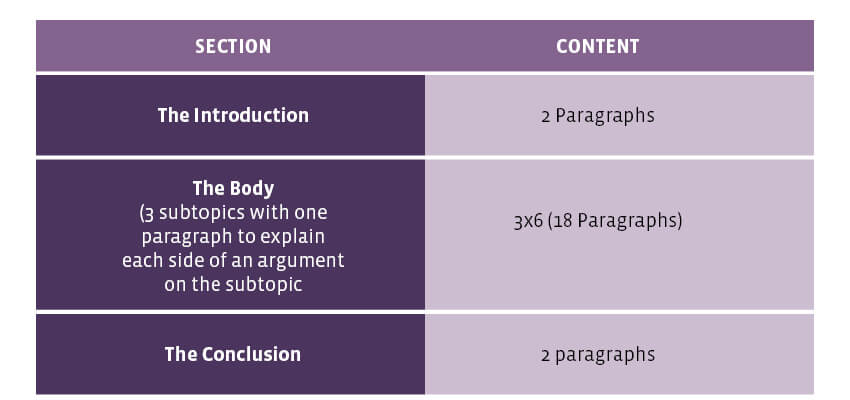
Sources to Consider Using
When writing your research paper and finding sources, it’s best to use a mix of sources. This may include:
- Internet: The Internet is filled with limitless possibilities. When you use the Internet, it’s best to find credible and trustworthy sources to avoid using fake news as a source. That’s why tools like Google Scholar can be so helpful.
- Textbooks: It’s more likely than not that you’ll be able to use your class textbook as a source for the research you are conducting.
- Books: Additionally, other books outside of those you read within your class will prove useful in any research paper.
Final Steps: Editing and Formatting
Once you’ve written all your ideas on the page, it’s time to edit. It cannot be stressed enough that editing is pivotal before submission. This is especially true if you’ve been writing under immense pressure.
Writing a 10- or 20-page research paper in one night is not easy, so there are bound to be mistakes and typos. The best way to catch these mistakes is to follow these tips:
- Take a break before you edit so you can come back to the page with somewhat fresh eyes and a clearer head
- Read it out loud to edit and catch mistakes because sometimes your brain will override typos or missing words to make sense of what it is reading
- If possible, ask someone else to look it over
- Consider using footnotes or block quotes
- Format according to how your university asks – MLA or APA, etc.
The Bottom Line
Life throws curveballs your way without warning. Whether you are holding yourself accountable for procrastinating or something out of your control came up, you may find yourself needing to write a big research paper in one night. It’s not the best-case scenario, but with the right tools and tricks up your sleeve, you can surely get it done!
In this article
At UoPeople, our blog writers are thinkers, researchers, and experts dedicated to curating articles relevant to our mission: making higher education accessible to everyone. Read More
Have a language expert improve your writing
Run a free plagiarism check in 10 minutes, generate accurate citations for free.
- Knowledge Base
- Research paper
How to Write a Research Paper | A Beginner's Guide
A research paper is a piece of academic writing that provides analysis, interpretation, and argument based on in-depth independent research.
Research papers are similar to academic essays , but they are usually longer and more detailed assignments, designed to assess not only your writing skills but also your skills in scholarly research. Writing a research paper requires you to demonstrate a strong knowledge of your topic, engage with a variety of sources, and make an original contribution to the debate.
This step-by-step guide takes you through the entire writing process, from understanding your assignment to proofreading your final draft.
Instantly correct all language mistakes in your text
Upload your document to correct all your mistakes in minutes

Table of contents
Understand the assignment, choose a research paper topic, conduct preliminary research, develop a thesis statement, create a research paper outline, write a first draft of the research paper, write the introduction, write a compelling body of text, write the conclusion, the second draft, the revision process, research paper checklist, free lecture slides.
Completing a research paper successfully means accomplishing the specific tasks set out for you. Before you start, make sure you thoroughly understanding the assignment task sheet:
- Read it carefully, looking for anything confusing you might need to clarify with your professor.
- Identify the assignment goal, deadline, length specifications, formatting, and submission method.
- Make a bulleted list of the key points, then go back and cross completed items off as you’re writing.
Carefully consider your timeframe and word limit: be realistic, and plan enough time to research, write, and edit.
Scribbr Citation Checker New
The AI-powered Citation Checker helps you avoid common mistakes such as:
- Missing commas and periods
- Incorrect usage of “et al.”
- Ampersands (&) in narrative citations
- Missing reference entries

There are many ways to generate an idea for a research paper, from brainstorming with pen and paper to talking it through with a fellow student or professor.
You can try free writing, which involves taking a broad topic and writing continuously for two or three minutes to identify absolutely anything relevant that could be interesting.
You can also gain inspiration from other research. The discussion or recommendations sections of research papers often include ideas for other specific topics that require further examination.
Once you have a broad subject area, narrow it down to choose a topic that interests you, m eets the criteria of your assignment, and i s possible to research. Aim for ideas that are both original and specific:
- A paper following the chronology of World War II would not be original or specific enough.
- A paper on the experience of Danish citizens living close to the German border during World War II would be specific and could be original enough.
Note any discussions that seem important to the topic, and try to find an issue that you can focus your paper around. Use a variety of sources , including journals, books, and reliable websites, to ensure you do not miss anything glaring.
Do not only verify the ideas you have in mind, but look for sources that contradict your point of view.
- Is there anything people seem to overlook in the sources you research?
- Are there any heated debates you can address?
- Do you have a unique take on your topic?
- Have there been some recent developments that build on the extant research?
In this stage, you might find it helpful to formulate some research questions to help guide you. To write research questions, try to finish the following sentence: “I want to know how/what/why…”
A thesis statement is a statement of your central argument — it establishes the purpose and position of your paper. If you started with a research question, the thesis statement should answer it. It should also show what evidence and reasoning you’ll use to support that answer.
The thesis statement should be concise, contentious, and coherent. That means it should briefly summarize your argument in a sentence or two, make a claim that requires further evidence or analysis, and make a coherent point that relates to every part of the paper.
You will probably revise and refine the thesis statement as you do more research, but it can serve as a guide throughout the writing process. Every paragraph should aim to support and develop this central claim.
Don't submit your assignments before you do this
The academic proofreading tool has been trained on 1000s of academic texts. Making it the most accurate and reliable proofreading tool for students. Free citation check included.

Try for free
A research paper outline is essentially a list of the key topics, arguments, and evidence you want to include, divided into sections with headings so that you know roughly what the paper will look like before you start writing.
A structure outline can help make the writing process much more efficient, so it’s worth dedicating some time to create one.
Your first draft won’t be perfect — you can polish later on. Your priorities at this stage are as follows:
- Maintaining forward momentum — write now, perfect later.
- Paying attention to clear organization and logical ordering of paragraphs and sentences, which will help when you come to the second draft.
- Expressing your ideas as clearly as possible, so you know what you were trying to say when you come back to the text.
You do not need to start by writing the introduction. Begin where it feels most natural for you — some prefer to finish the most difficult sections first, while others choose to start with the easiest part. If you created an outline, use it as a map while you work.
Do not delete large sections of text. If you begin to dislike something you have written or find it doesn’t quite fit, move it to a different document, but don’t lose it completely — you never know if it might come in useful later.
Paragraph structure
Paragraphs are the basic building blocks of research papers. Each one should focus on a single claim or idea that helps to establish the overall argument or purpose of the paper.
Example paragraph
George Orwell’s 1946 essay “Politics and the English Language” has had an enduring impact on thought about the relationship between politics and language. This impact is particularly obvious in light of the various critical review articles that have recently referenced the essay. For example, consider Mark Falcoff’s 2009 article in The National Review Online, “The Perversion of Language; or, Orwell Revisited,” in which he analyzes several common words (“activist,” “civil-rights leader,” “diversity,” and more). Falcoff’s close analysis of the ambiguity built into political language intentionally mirrors Orwell’s own point-by-point analysis of the political language of his day. Even 63 years after its publication, Orwell’s essay is emulated by contemporary thinkers.
Citing sources
It’s also important to keep track of citations at this stage to avoid accidental plagiarism . Each time you use a source, make sure to take note of where the information came from.
You can use our free citation generators to automatically create citations and save your reference list as you go.
APA Citation Generator MLA Citation Generator
The research paper introduction should address three questions: What, why, and how? After finishing the introduction, the reader should know what the paper is about, why it is worth reading, and how you’ll build your arguments.
What? Be specific about the topic of the paper, introduce the background, and define key terms or concepts.
Why? This is the most important, but also the most difficult, part of the introduction. Try to provide brief answers to the following questions: What new material or insight are you offering? What important issues does your essay help define or answer?
How? To let the reader know what to expect from the rest of the paper, the introduction should include a “map” of what will be discussed, briefly presenting the key elements of the paper in chronological order.
The major struggle faced by most writers is how to organize the information presented in the paper, which is one reason an outline is so useful. However, remember that the outline is only a guide and, when writing, you can be flexible with the order in which the information and arguments are presented.
One way to stay on track is to use your thesis statement and topic sentences . Check:
- topic sentences against the thesis statement;
- topic sentences against each other, for similarities and logical ordering;
- and each sentence against the topic sentence of that paragraph.
Be aware of paragraphs that seem to cover the same things. If two paragraphs discuss something similar, they must approach that topic in different ways. Aim to create smooth transitions between sentences, paragraphs, and sections.
The research paper conclusion is designed to help your reader out of the paper’s argument, giving them a sense of finality.
Trace the course of the paper, emphasizing how it all comes together to prove your thesis statement. Give the paper a sense of finality by making sure the reader understands how you’ve settled the issues raised in the introduction.
You might also discuss the more general consequences of the argument, outline what the paper offers to future students of the topic, and suggest any questions the paper’s argument raises but cannot or does not try to answer.
You should not :
- Offer new arguments or essential information
- Take up any more space than necessary
- Begin with stock phrases that signal you are ending the paper (e.g. “In conclusion”)
There are four main considerations when it comes to the second draft.
- Check how your vision of the paper lines up with the first draft and, more importantly, that your paper still answers the assignment.
- Identify any assumptions that might require (more substantial) justification, keeping your reader’s perspective foremost in mind. Remove these points if you cannot substantiate them further.
- Be open to rearranging your ideas. Check whether any sections feel out of place and whether your ideas could be better organized.
- If you find that old ideas do not fit as well as you anticipated, you should cut them out or condense them. You might also find that new and well-suited ideas occurred to you during the writing of the first draft — now is the time to make them part of the paper.
The goal during the revision and proofreading process is to ensure you have completed all the necessary tasks and that the paper is as well-articulated as possible. You can speed up the proofreading process by using the AI proofreader .
Global concerns
- Confirm that your paper completes every task specified in your assignment sheet.
- Check for logical organization and flow of paragraphs.
- Check paragraphs against the introduction and thesis statement.
Fine-grained details
Check the content of each paragraph, making sure that:
- each sentence helps support the topic sentence.
- no unnecessary or irrelevant information is present.
- all technical terms your audience might not know are identified.
Next, think about sentence structure , grammatical errors, and formatting . Check that you have correctly used transition words and phrases to show the connections between your ideas. Look for typos, cut unnecessary words, and check for consistency in aspects such as heading formatting and spellings .
Finally, you need to make sure your paper is correctly formatted according to the rules of the citation style you are using. For example, you might need to include an MLA heading or create an APA title page .
Scribbr’s professional editors can help with the revision process with our award-winning proofreading services.
Discover our paper editing service
Checklist: Research paper
I have followed all instructions in the assignment sheet.
My introduction presents my topic in an engaging way and provides necessary background information.
My introduction presents a clear, focused research problem and/or thesis statement .
My paper is logically organized using paragraphs and (if relevant) section headings .
Each paragraph is clearly focused on one central idea, expressed in a clear topic sentence .
Each paragraph is relevant to my research problem or thesis statement.
I have used appropriate transitions to clarify the connections between sections, paragraphs, and sentences.
My conclusion provides a concise answer to the research question or emphasizes how the thesis has been supported.
My conclusion shows how my research has contributed to knowledge or understanding of my topic.
My conclusion does not present any new points or information essential to my argument.
I have provided an in-text citation every time I refer to ideas or information from a source.
I have included a reference list at the end of my paper, consistently formatted according to a specific citation style .
I have thoroughly revised my paper and addressed any feedback from my professor or supervisor.
I have followed all formatting guidelines (page numbers, headers, spacing, etc.).
You've written a great paper. Make sure it's perfect with the help of a Scribbr editor!
Open Google Slides Download PowerPoint
Is this article helpful?
Other students also liked.
- Writing a Research Paper Introduction | Step-by-Step Guide
- Writing a Research Paper Conclusion | Step-by-Step Guide
- Research Paper Format | APA, MLA, & Chicago Templates
More interesting articles
- Academic Paragraph Structure | Step-by-Step Guide & Examples
- Checklist: Writing a Great Research Paper
- How to Create a Structured Research Paper Outline | Example
- How to Write a Discussion Section | Tips & Examples
- How to Write Recommendations in Research | Examples & Tips
- How to Write Topic Sentences | 4 Steps, Examples & Purpose
- Research Paper Appendix | Example & Templates
- Research Paper Damage Control | Managing a Broken Argument
- What Is a Theoretical Framework? | Guide to Organizing
What is your plagiarism score?
- Privacy Policy

Home » Research Paper – Structure, Examples and Writing Guide
Research Paper – Structure, Examples and Writing Guide
Table of Contents

Research Paper
Definition:
Research Paper is a written document that presents the author’s original research, analysis, and interpretation of a specific topic or issue.
It is typically based on Empirical Evidence, and may involve qualitative or quantitative research methods, or a combination of both. The purpose of a research paper is to contribute new knowledge or insights to a particular field of study, and to demonstrate the author’s understanding of the existing literature and theories related to the topic.
Structure of Research Paper
The structure of a research paper typically follows a standard format, consisting of several sections that convey specific information about the research study. The following is a detailed explanation of the structure of a research paper:
The title page contains the title of the paper, the name(s) of the author(s), and the affiliation(s) of the author(s). It also includes the date of submission and possibly, the name of the journal or conference where the paper is to be published.
The abstract is a brief summary of the research paper, typically ranging from 100 to 250 words. It should include the research question, the methods used, the key findings, and the implications of the results. The abstract should be written in a concise and clear manner to allow readers to quickly grasp the essence of the research.
Introduction
The introduction section of a research paper provides background information about the research problem, the research question, and the research objectives. It also outlines the significance of the research, the research gap that it aims to fill, and the approach taken to address the research question. Finally, the introduction section ends with a clear statement of the research hypothesis or research question.
Literature Review
The literature review section of a research paper provides an overview of the existing literature on the topic of study. It includes a critical analysis and synthesis of the literature, highlighting the key concepts, themes, and debates. The literature review should also demonstrate the research gap and how the current study seeks to address it.
The methods section of a research paper describes the research design, the sample selection, the data collection and analysis procedures, and the statistical methods used to analyze the data. This section should provide sufficient detail for other researchers to replicate the study.
The results section presents the findings of the research, using tables, graphs, and figures to illustrate the data. The findings should be presented in a clear and concise manner, with reference to the research question and hypothesis.
The discussion section of a research paper interprets the findings and discusses their implications for the research question, the literature review, and the field of study. It should also address the limitations of the study and suggest future research directions.
The conclusion section summarizes the main findings of the study, restates the research question and hypothesis, and provides a final reflection on the significance of the research.
The references section provides a list of all the sources cited in the paper, following a specific citation style such as APA, MLA or Chicago.
How to Write Research Paper
You can write Research Paper by the following guide:
- Choose a Topic: The first step is to select a topic that interests you and is relevant to your field of study. Brainstorm ideas and narrow down to a research question that is specific and researchable.
- Conduct a Literature Review: The literature review helps you identify the gap in the existing research and provides a basis for your research question. It also helps you to develop a theoretical framework and research hypothesis.
- Develop a Thesis Statement : The thesis statement is the main argument of your research paper. It should be clear, concise and specific to your research question.
- Plan your Research: Develop a research plan that outlines the methods, data sources, and data analysis procedures. This will help you to collect and analyze data effectively.
- Collect and Analyze Data: Collect data using various methods such as surveys, interviews, observations, or experiments. Analyze data using statistical tools or other qualitative methods.
- Organize your Paper : Organize your paper into sections such as Introduction, Literature Review, Methods, Results, Discussion, and Conclusion. Ensure that each section is coherent and follows a logical flow.
- Write your Paper : Start by writing the introduction, followed by the literature review, methods, results, discussion, and conclusion. Ensure that your writing is clear, concise, and follows the required formatting and citation styles.
- Edit and Proofread your Paper: Review your paper for grammar and spelling errors, and ensure that it is well-structured and easy to read. Ask someone else to review your paper to get feedback and suggestions for improvement.
- Cite your Sources: Ensure that you properly cite all sources used in your research paper. This is essential for giving credit to the original authors and avoiding plagiarism.
Research Paper Example
Note : The below example research paper is for illustrative purposes only and is not an actual research paper. Actual research papers may have different structures, contents, and formats depending on the field of study, research question, data collection and analysis methods, and other factors. Students should always consult with their professors or supervisors for specific guidelines and expectations for their research papers.
Research Paper Example sample for Students:
Title: The Impact of Social Media on Mental Health among Young Adults
Abstract: This study aims to investigate the impact of social media use on the mental health of young adults. A literature review was conducted to examine the existing research on the topic. A survey was then administered to 200 university students to collect data on their social media use, mental health status, and perceived impact of social media on their mental health. The results showed that social media use is positively associated with depression, anxiety, and stress. The study also found that social comparison, cyberbullying, and FOMO (Fear of Missing Out) are significant predictors of mental health problems among young adults.
Introduction: Social media has become an integral part of modern life, particularly among young adults. While social media has many benefits, including increased communication and social connectivity, it has also been associated with negative outcomes, such as addiction, cyberbullying, and mental health problems. This study aims to investigate the impact of social media use on the mental health of young adults.
Literature Review: The literature review highlights the existing research on the impact of social media use on mental health. The review shows that social media use is associated with depression, anxiety, stress, and other mental health problems. The review also identifies the factors that contribute to the negative impact of social media, including social comparison, cyberbullying, and FOMO.
Methods : A survey was administered to 200 university students to collect data on their social media use, mental health status, and perceived impact of social media on their mental health. The survey included questions on social media use, mental health status (measured using the DASS-21), and perceived impact of social media on their mental health. Data were analyzed using descriptive statistics and regression analysis.
Results : The results showed that social media use is positively associated with depression, anxiety, and stress. The study also found that social comparison, cyberbullying, and FOMO are significant predictors of mental health problems among young adults.
Discussion : The study’s findings suggest that social media use has a negative impact on the mental health of young adults. The study highlights the need for interventions that address the factors contributing to the negative impact of social media, such as social comparison, cyberbullying, and FOMO.
Conclusion : In conclusion, social media use has a significant impact on the mental health of young adults. The study’s findings underscore the need for interventions that promote healthy social media use and address the negative outcomes associated with social media use. Future research can explore the effectiveness of interventions aimed at reducing the negative impact of social media on mental health. Additionally, longitudinal studies can investigate the long-term effects of social media use on mental health.
Limitations : The study has some limitations, including the use of self-report measures and a cross-sectional design. The use of self-report measures may result in biased responses, and a cross-sectional design limits the ability to establish causality.
Implications: The study’s findings have implications for mental health professionals, educators, and policymakers. Mental health professionals can use the findings to develop interventions that address the negative impact of social media use on mental health. Educators can incorporate social media literacy into their curriculum to promote healthy social media use among young adults. Policymakers can use the findings to develop policies that protect young adults from the negative outcomes associated with social media use.
References :
- Twenge, J. M., & Campbell, W. K. (2019). Associations between screen time and lower psychological well-being among children and adolescents: Evidence from a population-based study. Preventive medicine reports, 15, 100918.
- Primack, B. A., Shensa, A., Escobar-Viera, C. G., Barrett, E. L., Sidani, J. E., Colditz, J. B., … & James, A. E. (2017). Use of multiple social media platforms and symptoms of depression and anxiety: A nationally-representative study among US young adults. Computers in Human Behavior, 69, 1-9.
- Van der Meer, T. G., & Verhoeven, J. W. (2017). Social media and its impact on academic performance of students. Journal of Information Technology Education: Research, 16, 383-398.
Appendix : The survey used in this study is provided below.
Social Media and Mental Health Survey
- How often do you use social media per day?
- Less than 30 minutes
- 30 minutes to 1 hour
- 1 to 2 hours
- 2 to 4 hours
- More than 4 hours
- Which social media platforms do you use?
- Others (Please specify)
- How often do you experience the following on social media?
- Social comparison (comparing yourself to others)
- Cyberbullying
- Fear of Missing Out (FOMO)
- Have you ever experienced any of the following mental health problems in the past month?
- Do you think social media use has a positive or negative impact on your mental health?
- Very positive
- Somewhat positive
- Somewhat negative
- Very negative
- In your opinion, which factors contribute to the negative impact of social media on mental health?
- Social comparison
- In your opinion, what interventions could be effective in reducing the negative impact of social media on mental health?
- Education on healthy social media use
- Counseling for mental health problems caused by social media
- Social media detox programs
- Regulation of social media use
Thank you for your participation!
Applications of Research Paper
Research papers have several applications in various fields, including:
- Advancing knowledge: Research papers contribute to the advancement of knowledge by generating new insights, theories, and findings that can inform future research and practice. They help to answer important questions, clarify existing knowledge, and identify areas that require further investigation.
- Informing policy: Research papers can inform policy decisions by providing evidence-based recommendations for policymakers. They can help to identify gaps in current policies, evaluate the effectiveness of interventions, and inform the development of new policies and regulations.
- Improving practice: Research papers can improve practice by providing evidence-based guidance for professionals in various fields, including medicine, education, business, and psychology. They can inform the development of best practices, guidelines, and standards of care that can improve outcomes for individuals and organizations.
- Educating students : Research papers are often used as teaching tools in universities and colleges to educate students about research methods, data analysis, and academic writing. They help students to develop critical thinking skills, research skills, and communication skills that are essential for success in many careers.
- Fostering collaboration: Research papers can foster collaboration among researchers, practitioners, and policymakers by providing a platform for sharing knowledge and ideas. They can facilitate interdisciplinary collaborations and partnerships that can lead to innovative solutions to complex problems.
When to Write Research Paper
Research papers are typically written when a person has completed a research project or when they have conducted a study and have obtained data or findings that they want to share with the academic or professional community. Research papers are usually written in academic settings, such as universities, but they can also be written in professional settings, such as research organizations, government agencies, or private companies.
Here are some common situations where a person might need to write a research paper:
- For academic purposes: Students in universities and colleges are often required to write research papers as part of their coursework, particularly in the social sciences, natural sciences, and humanities. Writing research papers helps students to develop research skills, critical thinking skills, and academic writing skills.
- For publication: Researchers often write research papers to publish their findings in academic journals or to present their work at academic conferences. Publishing research papers is an important way to disseminate research findings to the academic community and to establish oneself as an expert in a particular field.
- To inform policy or practice : Researchers may write research papers to inform policy decisions or to improve practice in various fields. Research findings can be used to inform the development of policies, guidelines, and best practices that can improve outcomes for individuals and organizations.
- To share new insights or ideas: Researchers may write research papers to share new insights or ideas with the academic or professional community. They may present new theories, propose new research methods, or challenge existing paradigms in their field.
Purpose of Research Paper
The purpose of a research paper is to present the results of a study or investigation in a clear, concise, and structured manner. Research papers are written to communicate new knowledge, ideas, or findings to a specific audience, such as researchers, scholars, practitioners, or policymakers. The primary purposes of a research paper are:
- To contribute to the body of knowledge : Research papers aim to add new knowledge or insights to a particular field or discipline. They do this by reporting the results of empirical studies, reviewing and synthesizing existing literature, proposing new theories, or providing new perspectives on a topic.
- To inform or persuade: Research papers are written to inform or persuade the reader about a particular issue, topic, or phenomenon. They present evidence and arguments to support their claims and seek to persuade the reader of the validity of their findings or recommendations.
- To advance the field: Research papers seek to advance the field or discipline by identifying gaps in knowledge, proposing new research questions or approaches, or challenging existing assumptions or paradigms. They aim to contribute to ongoing debates and discussions within a field and to stimulate further research and inquiry.
- To demonstrate research skills: Research papers demonstrate the author’s research skills, including their ability to design and conduct a study, collect and analyze data, and interpret and communicate findings. They also demonstrate the author’s ability to critically evaluate existing literature, synthesize information from multiple sources, and write in a clear and structured manner.
Characteristics of Research Paper
Research papers have several characteristics that distinguish them from other forms of academic or professional writing. Here are some common characteristics of research papers:
- Evidence-based: Research papers are based on empirical evidence, which is collected through rigorous research methods such as experiments, surveys, observations, or interviews. They rely on objective data and facts to support their claims and conclusions.
- Structured and organized: Research papers have a clear and logical structure, with sections such as introduction, literature review, methods, results, discussion, and conclusion. They are organized in a way that helps the reader to follow the argument and understand the findings.
- Formal and objective: Research papers are written in a formal and objective tone, with an emphasis on clarity, precision, and accuracy. They avoid subjective language or personal opinions and instead rely on objective data and analysis to support their arguments.
- Citations and references: Research papers include citations and references to acknowledge the sources of information and ideas used in the paper. They use a specific citation style, such as APA, MLA, or Chicago, to ensure consistency and accuracy.
- Peer-reviewed: Research papers are often peer-reviewed, which means they are evaluated by other experts in the field before they are published. Peer-review ensures that the research is of high quality, meets ethical standards, and contributes to the advancement of knowledge in the field.
- Objective and unbiased: Research papers strive to be objective and unbiased in their presentation of the findings. They avoid personal biases or preconceptions and instead rely on the data and analysis to draw conclusions.
Advantages of Research Paper
Research papers have many advantages, both for the individual researcher and for the broader academic and professional community. Here are some advantages of research papers:
- Contribution to knowledge: Research papers contribute to the body of knowledge in a particular field or discipline. They add new information, insights, and perspectives to existing literature and help advance the understanding of a particular phenomenon or issue.
- Opportunity for intellectual growth: Research papers provide an opportunity for intellectual growth for the researcher. They require critical thinking, problem-solving, and creativity, which can help develop the researcher’s skills and knowledge.
- Career advancement: Research papers can help advance the researcher’s career by demonstrating their expertise and contributions to the field. They can also lead to new research opportunities, collaborations, and funding.
- Academic recognition: Research papers can lead to academic recognition in the form of awards, grants, or invitations to speak at conferences or events. They can also contribute to the researcher’s reputation and standing in the field.
- Impact on policy and practice: Research papers can have a significant impact on policy and practice. They can inform policy decisions, guide practice, and lead to changes in laws, regulations, or procedures.
- Advancement of society: Research papers can contribute to the advancement of society by addressing important issues, identifying solutions to problems, and promoting social justice and equality.
Limitations of Research Paper
Research papers also have some limitations that should be considered when interpreting their findings or implications. Here are some common limitations of research papers:
- Limited generalizability: Research findings may not be generalizable to other populations, settings, or contexts. Studies often use specific samples or conditions that may not reflect the broader population or real-world situations.
- Potential for bias : Research papers may be biased due to factors such as sample selection, measurement errors, or researcher biases. It is important to evaluate the quality of the research design and methods used to ensure that the findings are valid and reliable.
- Ethical concerns: Research papers may raise ethical concerns, such as the use of vulnerable populations or invasive procedures. Researchers must adhere to ethical guidelines and obtain informed consent from participants to ensure that the research is conducted in a responsible and respectful manner.
- Limitations of methodology: Research papers may be limited by the methodology used to collect and analyze data. For example, certain research methods may not capture the complexity or nuance of a particular phenomenon, or may not be appropriate for certain research questions.
- Publication bias: Research papers may be subject to publication bias, where positive or significant findings are more likely to be published than negative or non-significant findings. This can skew the overall findings of a particular area of research.
- Time and resource constraints: Research papers may be limited by time and resource constraints, which can affect the quality and scope of the research. Researchers may not have access to certain data or resources, or may be unable to conduct long-term studies due to practical limitations.
About the author
Muhammad Hassan
Researcher, Academic Writer, Web developer
You may also like

Research Topics – Ideas and Examples

Research Paper Title Page – Example and Making...

How to Publish a Research Paper – Step by Step...

Ethical Considerations – Types, Examples and...

Implications in Research – Types, Examples and...

Research Design – Types, Methods and Examples
How to Write a Research Paper

If you already have a headache trying to understand what research paper is all about, we have created an ultimate guide for you on how to write a research paper. You will find all the answers to your questions regarding structure, planning, doing investigation, finding the topic that appeals to you. Plus, you will find out the secret to an excellent paper. Are you at the edge of your seat? Let us start with the basics then.
- What is a Research Paper
- Reasons for Writing a Research Paper
- Report Papers and Thesis Papers
- How to Start a Research Paper
- How to Choose a Topic for a Research Paper
- How to Write a Proposal for a Research Paper
- How to Write a Research Plan
- How to Do Research
- How to Write an Outline for a Research Paper
- How to Write a Thesis Statement for a Research Paper
- How to Write a Research Paper Rough Draft
- How to Write an Introduction for a Research Paper
- How to Write a Body of a Research Paper
- How to Write a Conclusion for a Research Paper
- How to Write an Abstract for a Research Paper
- How to Revise and Edit a Research Paper
- How to Write a Bibliography for a Research Paper
- What Makes a Good Research Paper
Research Paper Writing Services
What is a research paper.

Academic Writing, Editing, Proofreading, And Problem Solving Services
Get 10% off with 24start discount code.
You probably know the saying ‘the devil is not as black as he is painted’. This particular saying is absolutely true when it comes to writing a research paper. Your feet are cold even with the thought of this assignment. You have heard terrifying stories from older students. You have never done this before, so certainly you are scared. What is a research paper? How should I start? What are all these requirements about?
Luckily, you have a friend in need. That is our writing service. First and foremost, let us clarify the definition. A research paper is a piece of academic writing that provides information about a particular topic that you’ve researched . In other words, you choose a topic: about historical events, the work of some artist, some social issues etc. Then you collect data on the given topic and analyze it. Finally, you put your analysis on paper. See, it is not as scary as it seems. If you are still having doubts, whether you can handle it yourself, we are here to help you. Our team of writers can help you choose the topic, or give you advice on how to plan your work, or how to start, or craft a paper for you. Just contact us 24/7 and see everything yourself.
5 Reasons for Writing a Research Paper
Why should I spend my time writing some academic paper? What is the use of it? Is not some practical knowledge more important? The list of questions is endless when it comes to a research paper. That is why we have outlined 5 main reasons why writing a research paper is a good thing.
- You will learn how to organize your time
If you want to write a research paper, you will have to learn how to manage your time. This type of assignment cannot be done overnight. It requires careful planning and you will need to learn how to do it. Later, you will be able to use these time-managing skills in your personal life, so why not developing them?
- You will discover your writing skills
You cannot know something before you try it. This rule relates to writing as well. You cannot claim that you cannot write until you try it yourself. It will be really difficult at the beginning, but then the words will come to your head themselves.
- You will improve your analytical skills
Writing a research paper is all about investigation and analysis. You will need to collect data, examine and classify it. These skills are needed in modern life more than anything else is.
- You will gain confidence
Once you do your own research, it gives you the feeling of confidence in yourself. The reason is simple human brain likes solving puzzles and your assignment is just another puzzle to be solved.
- You will learn how to persuade the reader
When you write your paper, you should always remember that you are writing it for someone to read. Moreover, you want this someone to believe in your ideas. For this reason, you will have to learn different convincing methods and techniques. You will learn how to make your writing persuasive. In turns, you will be able to use these methods in real life.
What is the Difference between Report and Thesis Papers?
A common question is ‘what is the difference between a report paper and a thesis paper?’ The difference lies in the aim of these two assignments. While the former aims at presenting the information, the latter aims at providing your opinion on the matter. In other words, in a report paper you have to summarize your findings. In a thesis paper, you choose some issue and defend your point of view by persuading the reader. It is that simple.
A thesis paper is a more common assignment than a report paper. This task will help a professor to evaluate your analytical skills and skills to present your ideas logically. These skills are more important than just the ability to collect and summarize data.
How to Write a Research Paper Step by Step
Research comes from the French word rechercher , meaning “to seek out.” Writing a research paper requires you to seek out information about a subject, take a stand on it, and back it up with the opinions, ideas, and views of others. What results is a printed paper variously known as a term paper or library paper, usually between five and fifteen pages long—most instructors specify a minimum length—in which you present your views and findings on the chosen subject.

It is not a secret that the majority of students hate writing a research paper. The reason is simple it steals your time and energy. Not to mention, constant anxiety that you will not be able to meet the deadline or that you will forget about some academic requirement.
We will not lie to you; a research paper is a difficult assignment. You will have to spend a lot of time. You will need to read, to analyze, and to search for the material. You will probably be stuck sometimes. However, if you organize your work smart, you will gain something that is worth all the effort – knowledge, experience, and high grades.
The reason why many students fail writing a research paper is that nobody explained them how to start and how to plan their work. Luckily, you have found our writing service and we are ready to shed the light on this dark matter.
We have created a step by step guide for you on how to write a research paper. We will dwell upon the structure, the writing tips, the writing strategies as well as academic requirements. Read this whole article and you will see that you can handle writing this assignment and our team of writers is here to assist you.
How to Start a Research Paper?

It all starts with the assignment. Your professor gives you the task. It may be either some general issue or specific topic to write about. Your assignment is your first guide to success. If you understand what you need to do according to the assignment, you are on the road to high results. Do not be scared to clarify your task if you need to. There is nothing wrong in asking a question if you want to do something right. You can ask your professor or you can ask our writers who know a thing or two in academic writing.
It is essential to understand the assignment. A good beginning makes a good ending, so start smart.
Learn how to start a research paper .
Choosing a Topic for a Research Paper

We have already mentioned that it is not enough to do great research. You need to persuade the reader that you have made some great research. What convinces better that an eye-catching topic? That is why it is important to understand how to choose a topic for a research paper.
First, you need to delimit the general idea to a more specific one. Secondly, you need to find what makes this topic interesting for you and for the academia. Finally, you need to refine you topic. Remember, it is not something you will do in one day. You can be reshaping your topic throughout your whole writing process. Still, reshaping not changing it completely. That is why keep in your head one main idea: your topic should be precise and compelling .
Learn how to choose a topic for a research paper .
How to Write a Proposal for a Research Paper?

If you do not know what a proposal is, let us explain it to you. A proposal should answer three main questions:
- What is the main aim of your investigation?
- Why is your investigation important?
- How are you going to achieve the results?
In other words, proposal should show why your topic is interesting and how you are going to prove it. As to writing requirements, they may differ. That is why make sure you find out all the details at your department. You can ask your departmental administrator or find information online at department’s site. It is crucial to follow all the administrative requirements, as it will influence your grade.
Learn how to write a proposal for a research paper .
How to Write a Research Plan?

The next step is writing a plan. You have already decided on the main issues, you have chosen the bibliography, and you have clarified the methods. Here comes the planning. If you want to avoid writer’s block, you have to structure you work. Discuss your strategies and ideas with your instructor. Think thoroughly why you need to present some data and ideas first and others second. Remember that there are basic structure elements that your research paper should include:
- Thesis Statement
- Introduction
- Bibliography
You should keep in mind this skeleton when planning your work. This will keep your mind sharp and your ideas will flow logically.
Learn how to write a research plan .
How to Do Research?

Your research will include three stages: collecting data, reading and analyzing it, and writing itself.
First, you need to collect all the material that you will need for you investigation: films, documents, surveys, interviews, and others. Secondly, you will have to read and analyze. This step is tricky, as you need to do this part smart. It is not enough just to read, as you cannot keep in mind all the information. It is essential that you make notes and write down your ideas while analyzing some data. When you get down to the stage number three, writing itself, you will already have the main ideas written on your notes. Plus, remember to jot down the reference details. You will then appreciate this trick when you will have to write the bibliography.
If you do your research this way, it will be much easier for you to write the paper. You will already have blocks of your ideas written down and you will just need to add some material and refine your paper.
Learn how to do research .
How to Write an Outline for a Research Paper?

To make your paper well organized you need to write an outline. Your outline will serve as your guiding star through the writing process. With a great outline you will not get sidetracked, because you will have a structured plan to follow. Both you and the reader will benefit from your outline. You present your ideas logically and you make your writing coherent according to your plan. As a result, this outline guides the reader through your paper and the reader enjoys the way you demonstrate your ideas.
Learn how to write an outline for a research paper . See research paper outline examples .
How to Write a Thesis Statement for a Research Paper?

Briefly, the thesis is the main argument of your research paper. It should be precise, convincing and logical. Your thesis statement should include your point of view supported by evidence or logic. Still, remember it should be precise. You should not beat around the bush, or provide all the possible evidence you have found. It is usually a single sentence that shows your argument. In on sentence you should make a claim, explain why it significant and convince the reader that your point of view is important.
Learn how to write a thesis statement for a research paper . See research paper thesis statement examples .
Should I Write a Rough Draft for a Research Paper?

Do you know any writer who put their ideas on paper, then never edited them and just published? Probably, no writer did so. Writing a research paper is no exception. It is impossible to cope with this assignment without writing a rough draft.
Your draft will help you understand what you need to polish to make your paper perfect. All the requirements, academic standards make it difficult to do everything flawlessly at the first attempt. Make sure you know all the formatting requirements: margins, words quantity, reference requirements, formatting styles etc.
Learn how to write a rough draft for a research paper .
How to Write an Introduction for a Research Paper?

Let us make it more vivid for you. We have narrowed down the tips on writing an introduction to the three main ones:
- Include your thesis in your introduction
Remember to include the thesis statement in your introduction. Usually, it goes at the end of the first paragraph.
- Present the main ideas of the body
You should tell the main topics you are going to discuss in the main body. For this reason, before writing this part of introduction, make sure you know what is your main body is going to be about. It should include your main ideas.
- Polish your thesis and introduction
When you finish the main body of your paper, come back to the thesis statement and introduction. Restate something if needed. Just make it perfect; because introduction is like the trailer to your paper, it should make the reader want to read the whole piece.
Learn how to write an introduction for a research paper . See research paper introduction examples .
How to Write a Body of a Research Paper?

A body is the main part of your research paper. In this part, you will include all the needed evidence; you will provide the examples and support your argument.
It is important to structure your paragraphs thoroughly. That is to say, topic sentence and the evidence supporting the topic. Stay focused and do not be sidetracked. You have your outline, so follow it.
Here are the main tips to keep in head when writing a body of a research paper:
- Let the ideas flow logically
- Include only relevant information
- Provide the evidence
- Structure the paragraphs
- Make the coherent transition from one paragraph to another
See? When it is all structured, it is not as scary as it seemed at the beginning. Still, if you have doubts, you can always ask our writers for help.
Learn how to write a body of a research paper . See research paper transition examples .

How to Write a Conclusion for a Research Paper?

Writing a good conclusion is important as writing any other part of the paper. Remember that conclusion is not a summary of what you have mentioned before. A good conclusion should include your last strong statement.
If you have written everything according to the plan, the reader already knows why your investigation is important. The reader has already seen the evidence. The only thing left is a strong concluding thought that will organize all your findings.
Never include any new information in conclusion. You need to conclude, not to start a new discussion.
Learn how to write a conclusion for a research paper .
How to Write an Abstract for a Research Paper?

An abstract is a brief summary of your paper, usually 100-200 words. You should provide the main gist of your paper in this short summary. An abstract can be informative, descriptive or proposal. Depending on the type of abstract, you need to write, the requirements will differ.
To write an informative abstract you have to provide the summary of the whole paper. Informative summary. In other words, you need to tell about the main points of your work, the methods used, the results and the conclusion of your research.
To write a descriptive abstract you will not have to provide any summery. You should write a short teaser of your paper. That is to say, you need to write an overview of your paper. The aim of a descriptive abstract is to interest the reader.
Finally, to write a proposal abstract you will need to write the basic summary as for the informative abstract. However, the difference is the following: you aim at persuading someone to let you write on the topic. That is why, a proposal abstract should present your topic as the one worth investigating.
Learn how to write an abstract for a research paper .
Should I Revise and Edit a Research Paper?

Revising and editing your paper is essential if you want to get high grades. Let us help you revise your paper smart:
- Check your paper for spelling and grammar mistakes
- Sharpen the vocabulary
- Make sure there are no slang words in your paper
- Examine your paper in terms of structure
- Compare your topic, thesis statement to the whole piece
- Check your paper for plagiarism
If you need assistance with proofreading and editing your paper, you can turn to the professional editors at our service. They will help you polish your paper to perfection.
Learn how to revise and edit a research paper .
How to Write a Bibliography for a Research Paper?

First, let us make it clear that bibliography and works cited are two different things. Works cited are those that you cited in your paper. Bibliography should include all the materials you used to do your research. Still, remember that bibliography requirements differ depending on the formatting style of your paper. For this reason, make sure you ask you professor all the requirements you need to meet to avoid any misunderstanding.
Learn how to write a bibliography for a research paper .
The Key Secret to a Good Research Paper
Now when you know all the stages of writing a research paper, you are ready to find the key to a good research paper:
- Choose the topic that really interests you
- Make the topic interesting for you even if it is not at the beginning
- Follow the step by step guide and do not get sidetracked
- Be persistent and believe in yourself
- Really do research and write your paper from scratch
- Learn the convincing writing techniques and use them
- Follow the requirements of your assignment
- Ask for help if needed from real professionals
Feeling more confident about your paper now? We are sure you do. Still, if you need help, you can always rely on us 24/7.
We hope we have made writing a research paper much easier for you. We realize that it requires lots of time and energy. We believe when you say that you cannot handle it anymore. For this reason, we have been helping students like you for years. Our professional team of writers is ready to tackle any challenge.
All our authors are experienced writers crafting excellent academic papers. We help students meet the deadline and get the top grades they want. You can see everything yourself. All you need to do is to place your order online and we will contact you. Writing a research paper with us is truly easy, so why do not you check it yourself?
Additional Resources for Research Paper Writing:
- Anthropology Research
- Career Research
- Communication Research
- Criminal Justice Research
- Health Research
- Political Science Research
- Psychology Research
- Sociology Research
ORDER HIGH QUALITY CUSTOM PAPER

- How it works

How to Write a Dissertation in Ten Days or Less
Published by Owen Ingram at January 27th, 2023 , Revised On April 19, 2024
Can you Complete your Dissertation in Ten Days?
Most students struggle at some point with deadlines, and we regularly get asked questions such as ‘Can you write a dissertation in a month?’ and ‘Can you write a dissertation in three days?’ We do not judge why you are in this situation, we’re here to help you get your dissertation done. The answer to the questions is yes. But of course, the less time you have, the more pressure you are under.
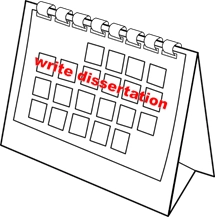
How Long Does it Take to Write a 10,000-word Dissertation?
This is a common question, as is “How long does it take to write a 7,000-word dissertation?” There is no figure in hours or days that answers this; it differs for everyone. “Is it possible to write a 10,000-word dissertation in two days?” Well, yes. But you will only find out if you can do it when the two days are up. You need to get started immediately, follow our advice and use our dissertation guides . But we are not claiming it’s easy.
Can I Complete my Dissertation in 3 Days? How Fast do I Need to Write?
If you have to produce 10,000 words in ten days, you have to average 1,000 a day. If you have two days, then 5,000 per day and if you work on it for 12 hours each of those days, you need to turn out 417 words per hour. A tall order, but it can be done. Do not let panic or pressure overwhelm you; and remember, it is perfectly acceptable to ask for help . You can stop asking your friends ‘How quickly can you write a dissertation?’ You are going to show them how quickly.
Can I Really Produce 10,000 Words in a Week?
How long d oes it take to write a 10k word dissertation? To give you some perspective, most people speak this many words in a day with no effort. You probably have more than enough words in your notes. It will make a big difference if you have your research project results analysis done already. If this is the case, you ‘only’ need to write them up. If you already made a good start but you are having trouble progressing, maybe you just need to focus on writing up your findings or certain chapters or areas.
You might think your notes are messy and disorganised or that they lack the right academic sound. Regardless, do not think of this task as producing all 10,000 words, rather, it is laying out your notes, organising them, and giving them a more formal, academic tone.
Can you Write a Dissertation in a Day?
Can you write a dissertation in a day? This is surely the most demanding academic writing challenge. It means 100% focus and work: Type up your notes, ensuring they have an academic/formal tone to them. Keep going, section by section and as it grows, you will start to see your dissertation appear.
Preparing to Write your Dissertation Fast
Prepare to start work.
You know your subject well, and you have probably written many essays on it by now. The main difference is that this assignment is longer. So, let’s get started. You need to prepare well; normal life can be suspended for the time you will spend working. The first preparations to make concern you and where you are going to work.
Distractions and Interruptions
Turn off your phone and avoid TV. If you are really serious, you will really do it. When you procrastinate or allow yourself to be distracted, what do you do? Gaming? Staring out of the window? Baking? Make these things difficult or impossible to do. Be aware of something called productive procrastination. This is when you do something productive but it’s not what you are meant to be doing. Do not mistake activity for productivity. When you find yourself vacuuming around your desk, snap out of it.
I’m Writing my Dissertation all Week. Quiet, Please
Some people can work with music playing, and some need silence. Listening to words, whether sung or spoken, can distract you when producing text. If there is something that will help you, such as instrumental music, use it. Make sure everyone knows what you are doing and ask them to leave you alone (except for bringing you food and drinks). Can someone else handle your duties and obligations for a while?
Create a Work Area
Set up a workplace and de-clutter it. Remove irrelevant books and anything you can fiddle with. Gather all your materials: this means textbooks, notes on paper and in digital form. Your research is likely over, but you will need everything to hand.
Give all materials specific places and keep them there. As you use them, you will remember where they are. Putting them down in different places will mean time lost looking for them, which will add frustration to the work.
Do All of your Legwork Before Starting
Getting up and walking away from the desk unnecessarily uses time you do not have. Do not let shopping trips interrupt your work. If you do not have enough food and supplies in before starting, get them first. Certain foods/snacks can help get you through, maybe you can suspend your usual health regime for a while. You need to feel comfortable in this. But do not overdo the caffeine or sugar .
Make a Work Schedule
Look ahead at your available time and make a schedule. If you work 21 hours on the first day, you might find yourself burnt out the next day. Sleep when you have to, work when you feel good. How long can you realistically work each day? Be careful not to create an unrealistic schedule, you will not keep up to it and will become demoralised. Remember that writing the dissertation is only 1% of your entire course; it is acceptable to get help at this late stage.
Where to Start
Start here – write an outline.
As well as a work schedule, you need a dissertation structure . You may be tempted to think that making an outline for your dissertation is extra work, that it would be quicker to just start writing. That would be like going on a driving tour to every European country with no plan. Without regular destinations, you will drift about aimlessly.
You can save time by focussing only on the main parts of the dissertation. If you run out of time, it will be better if the parts not completed are the less significant ones, although ideally nothing should be left unfinished. This is an exercise in prioritisation: Write the most valuable, points-scoring parts first.
Sacrifices May be Necessary
With a tight time limit, you might have to make sacrifices. People with the luxury of time will spend a day or more on just the table of contents or references section . You might not have this option. The focus has to be on the rapid production of text and its quality; things like detailed formatting and page layout will be secondary.
Prioritising your Order of Work
In the detailed plan below, skip the greyed-out parts to start with. You can use this to create an outline by adding a note under each part of the different sections stating what you are going to include there. This is where the job starts to appear less daunting; 10,000 now becomes 2,000 for this section, 1,000 for that section… The mountain becomes a set of smaller hills. And the introduction section can be written after the body, it is easier and quicker that way.
Hire an Expert Writer
Orders completed by our expert writers are
- Formally drafted in an academic style
- Free Amendments and 100% Plagiarism Free – or your money back!
- 100% Confidential and Timely Delivery!
- Free anti-plagiarism report
- Appreciated by thousands of clients. Check client reviews

| 1 |
| 2 |
| 3 |
| 4 |
| 5 |
| 6 |
| 7 |
| 1 Brief description of the topic and main problem |
| 2 |
| 3 The of the investigation |
| 4 |
| 5 Organisation of the research |
| 1 Introduction |
| 2 Summarise & combine findings from your sources |
| 3 Review & evaluation of sources used |
| 4 Critical assessment of the literature |
| 1 |
| 2 Philosophical approach |
| 3 |
| 4 Research limitations |
| 5 Ethical considerations |
| 6 |
| 1 Statement and analysis of the results |
| 2 Comparison of the obtained results and initial goals/questions |
| 1 |
| 2 Comparison of the results with the findings of prior researchers |
| 3 Suggestions regarding the use of the obtained findings for the further development of the topic and future investigation |
| Build this as you go along. |
| 1 Statement of the IRB forms (for example, the forms of the informed consent) |
| 2 Information regarding the instrumentation |
Writing the Dissertation Body
When you have an outline, you need to put some meat on those bones and build a body. Working from start to finish may be best (skipping the introduction), but the order you work in is your choice. If your notes are not in order, a quick way to identify notes that apply to the different sections is to mark them with different coloured highlighters as in the table above. This will draw your eyes to the relevant notes quickly. You can do this on your computer screen by highlighting similarly.
After the main body, the introduction is next. This will be easier to write because all the information will be fresh in your mind. What next? The appendices or the parts at the front? This should be your decision based on remaining time.
Good Practices for Writing your Dissertation
Ignore spelling and grammar.
Do not pay attention to spelling, grammar, and language rules at this stage. Attending to spelling and grammatical details as you work will distract you and spoil your flow. Spelling and grammatical mistakes do not matter in a work in progress. You can turn checking functions off until you reach the editing and proofreading stage. Concentrate only on writing up your notes, do not switch between tasks.
Attend to One Part of the Dissertation at a Time
Constantly switching between research, writing, and tidying up the reference section is inefficient. Each time you switch, your mind needs time to catch up then settle into that activity. By focussing, we mean you should do all the analysis in one session until it is finished, all the writing of major sections in another, and sorting out the reference section can be done in one sitting. Less switching saves time and usually turns out a better job.
Take Regular Short Breaks
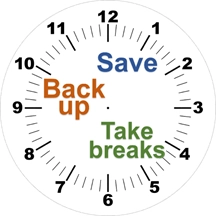
Save and Back up Routinely
When you leave the desk, click to save your work. Also do this after any burst of writing, and at regular intervals. Back up your work on another drive too. This is one of the most important things you will write. Treat it as the valuable document that it is.
For when you resume work, make sure you know where you left off, highlight it if that helps. When you come back to your work the next day, sometimes you can’t remember where you were; it can be difficult to resume the same line of thought. A habit of Ernest Hemingway was to leave an unfinished sentence to come back to so that he could…
Have a Strict but Simple Method of Noting Sources
Every time you quote or paraphrase something, note the source. Use a simple referencing technique while writing that does not demand much time. One such method is for the first in-text reference, just put (1) after the quote, use (2) for the second and so on. Start a list of sources that correspond to each number. You could highlight the numbers in a specific colour so you can attend to them later and not miss any. Missing just one reference, even accidentally, will still count as plagiarism . Before you start, be absolutely clear whether you are including a reference list or bibliography . Completing your list according to the required style ( Harvard , Chicago, etc.) can be done in one session.
Get a Qualified Appraisal of your Work
You will need someone to read your finished work. Having it read by someone unfamiliar with the subject and the structure of dissertations will be unproductive. Ideally it should be someone who understands the topic. And these days that person need not be physically present; you can email your draft to someone to get an opinion on changes & improvements .
Writing your Dissertation in Days
We are not going to sugar-coat the task of producing a dissertation in days rather than months and weeks. It is not easy, and regardless of what caused you to have such a short time remaining, it puts all your work in jeopardy. When someone asks us “Can I complete my dissertation in three days?” we have to answer yes, you can, but… It depends on the individual, how much work you have done so far, your personal circumstances, your other obligations, how much of those three days can you dedicate to the task.
How to Write a Dissertation Fast Checklist
Frequently asked questions, can i write my dissertation in under a week.
The short answer is yes but there are several factors to consider that may help or hinder you. Few people have the support around them to allow them to drop all commitments and focus on just one task. Also, few people will have taken on such a large a task in such a short time before, and might become overwhelmed.
The dissertation is where your study course culminates; all the time, effort, and expense you have invested should come to fruition here. This might not be a good time for maybe I can do it . Maybe you can make it to the bank before it closes. No? Oh, well, you can go tomorrow. Maybe I can write 10,000 words in a week. If the answer is no, the consequences are more serious.
This guide and all the other dissertation guides on this site are here to help you with every aspect of dissertation writing. You can also contact us directly through the chat box or Whatsapp.
I have to write my dissertation in three days. Where do I start?
Start by getting organised. Gather all the materials you need, create a work area, get rid of distractions, and if possible, delegate any obligations or chores to someone else for the duration. Then read this guide from the start. If you need further help when you are deep into the writing, just ask us. We exist just for this purpose. Our team and expert writers have handled almost every kind of dissertation emergency.
Can I do my research, analysis, and write my dissertation in ten days?
The more time you have, the better. But carrying out the research and analysis in such a short time will be very demanding. It can be done though; our team can do this in under a week. You would need a great level of support around you and an impressive level of determination and focus. If you supply the determination, we can provide the support .
What helped you finish your dissertation quickly?
To finish your dissertation quickly, prioritise tasks, set realistic goals, maintain a consistent work schedule, minimise distractions, seek feedback from advisors regularly, and break down the writing process into manageable chunks. Use effective time management techniques, such as the Pomodoro Technique, and stay organised with thorough planning and research strategies.
You May Also Like
There are eight main parts of a dissertation. Learn about what they are and what is included in them in this comprehensive blog.
Achieving a 95% on your dissertation? We reveal insider tips & discuss if it’s even possible. Aim for dissertation excellence!
The amount of evidence in a thesis or dissertation varies based on field, topic, and standards, prioritising quality over quantity.
USEFUL LINKS
LEARNING RESOURCES

COMPANY DETAILS

- How It Works

- Ask LitCharts AI
- Discussion Question Generator
- Essay Prompt Generator
- Quiz Question Generator

- Literature Guides
- Poetry Guides
- Shakespeare Translations
- Literary Terms
How to Write a Research Paper
Use the links below to jump directly to any section of this guide:
Research Paper Fundamentals
How to choose a topic or question, how to create a working hypothesis or thesis, common research paper methodologies, how to gather and organize evidence , how to write an outline for your research paper, how to write a rough draft, how to revise your draft, how to produce a final draft, resources for teachers .
It is not fair to say that no one writes anymore. Just about everyone writes text messages, brief emails, or social media posts every single day. Yet, most people don't have a lot of practice with the formal, organized writing required for a good academic research paper. This guide contains links to a variety of resources that can help demystify the process. Some of these resources are intended for teachers; they contain exercises, activities, and teaching strategies. Other resources are intended for direct use by students who are struggling to write papers, or are looking for tips to make the process go more smoothly.
The resources in this section are designed to help students understand the different types of research papers, the general research process, and how to manage their time. Below, you'll find links from university writing centers, the trusted Purdue Online Writing Lab, and more.
What is an Academic Research Paper?
"Genre and the Research Paper" (Purdue OWL)
There are different types of research papers. Different types of scholarly questions will lend themselves to one format or another. This is a brief introduction to the two main genres of research paper: analytic and argumentative.
"7 Most Popular Types of Research Papers" (Personal-writer.com)
This resource discusses formats that high school students commonly encounter, such as the compare and contrast essay and the definitional essay. Please note that the inclusion of this link is not an endorsement of this company's paid service.
How to Prepare and Plan Out Writing a Research Paper
Teachers can give their students a step-by-step guide like these to help them understand the different steps of the research paper process. These guides can be combined with the time management tools in the next subsection to help students come up with customized calendars for completing their papers.
"Ten Steps for Writing Research Papers" (American University)
This resource from American University is a comprehensive guide to the research paper writing process, and includes examples of proper research questions and thesis topics.
"Steps in Writing a Research Paper" (SUNY Empire State College)
This guide breaks the research paper process into 11 steps. Each "step" links to a separate page, which describes the work entailed in completing it.
How to Manage Time Effectively
The links below will help students determine how much time is necessary to complete a paper. If your sources are not available online or at your local library, you'll need to leave extra time for the Interlibrary Loan process. Remember that, even if you do not need to consult secondary sources, you'll still need to leave yourself ample time to organize your thoughts.
"Research Paper Planner: Timeline" (Baylor University)
This interactive resource from Baylor University creates a suggested writing schedule based on how much time a student has to work on the assignment.
"Research Paper Planner" (UCLA)
UCLA's library offers this step-by-step guide to the research paper writing process, which also includes a suggested planning calendar.
There's a reason teachers spend a long time talking about choosing a good topic. Without a good topic and a well-formulated research question, it is almost impossible to write a clear and organized paper. The resources below will help you generate ideas and formulate precise questions.
"How to Select a Research Topic" (Univ. of Michigan-Flint)
This resource is designed for college students who are struggling to come up with an appropriate topic. A student who uses this resource and still feels unsure about his or her topic should consult the course instructor for further personalized assistance.
"25 Interesting Research Paper Topics to Get You Started" (Kibin)
This resource, which is probably most appropriate for high school students, provides a list of specific topics to help get students started. It is broken into subsections, such as "paper topics on local issues."
"Writing a Good Research Question" (Grand Canyon University)
This introduction to research questions includes some embedded videos, as well as links to scholarly articles on research questions. This resource would be most appropriate for teachers who are planning lessons on research paper fundamentals.
"How to Write a Research Question the Right Way" (Kibin)
This student-focused resource provides more detail on writing research questions. The language is accessible, and there are embedded videos and examples of good and bad questions.
It is important to have a rough hypothesis or thesis in mind at the beginning of the research process. People who have a sense of what they want to say will have an easier time sorting through scholarly sources and other information. The key, of course, is not to become too wedded to the draft hypothesis or thesis. Just about every working thesis gets changed during the research process.
CrashCourse Video: "Sociology Research Methods" (YouTube)
Although this video is tailored to sociology students, it is applicable to students in a variety of social science disciplines. This video does a good job demonstrating the connection between the brainstorming that goes into selecting a research question and the formulation of a working hypothesis.
"How to Write a Thesis Statement for an Analytical Essay" (YouTube)
Students writing analytical essays will not develop the same type of working hypothesis as students who are writing research papers in other disciplines. For these students, developing the working thesis may happen as a part of the rough draft (see the relevant section below).
"Research Hypothesis" (Oakland Univ.)
This resource provides some examples of hypotheses in social science disciplines like Political Science and Criminal Justice. These sample hypotheses may also be useful for students in other soft social sciences and humanities disciplines like History.
When grading a research paper, instructors look for a consistent methodology. This section will help you understand different methodological approaches used in research papers. Students will get the most out of these resources if they use them to help prepare for conversations with teachers or discussions in class.
"Types of Research Designs" (USC)
A "research design," used for complex papers, is related to the paper's method. This resource contains introductions to a variety of popular research designs in the social sciences. Although it is not the most intuitive site to read, the information here is very valuable.
"Major Research Methods" (YouTube)
Although this video is a bit on the dry side, it provides a comprehensive overview of the major research methodologies in a format that might be more accessible to students who have struggled with textbooks or other written resources.
"Humanities Research Strategies" (USC)
This is a portal where students can learn about four methodological approaches for humanities papers: Historical Methodologies, Textual Criticism, Conceptual Analysis, and the Synoptic method.
"Selected Major Social Science Research Methods: Overview" (National Academies Press)
This appendix from the book Using Science as Evidence in Public Policy , printed by National Academies Press, introduces some methods used in social science papers.
"Organizing Your Social Sciences Research Paper: 6. The Methodology" (USC)
This resource from the University of Southern California's library contains tips for writing a methodology section in a research paper.
How to Determine the Best Methodology for You
Anyone who is new to writing research papers should be sure to select a method in consultation with their instructor. These resources can be used to help prepare for that discussion. They may also be used on their own by more advanced students.
"Choosing Appropriate Research Methodologies" (Palgrave Study Skills)
This friendly and approachable resource from Palgrave Macmillan can be used by students who are just starting to think about appropriate methodologies.
"How to Choose Your Research Methods" (NFER (UK))
This is another approachable resource students can use to help narrow down the most appropriate methods for their research projects.
The resources in this section introduce the process of gathering scholarly sources and collecting evidence. You'll find a range of material here, from introductory guides to advanced explications best suited to college students. Please consult the LitCharts How to Do Academic Research guide for a more comprehensive list of resources devoted to finding scholarly literature.
Google Scholar
Students who have access to library websites with detailed research guides should start there, but people who do not have access to those resources can begin their search for secondary literature here.
"Gathering Appropriate Information" (Texas Gateway)
This resource from the Texas Gateway for online resources introduces students to the research process, and contains interactive exercises. The level of complexity is suitable for middle school, high school, and introductory college classrooms.
"An Overview of Quantitative and Qualitative Data Collection Methods" (NSF)
This PDF from the National Science Foundation goes into detail about best practices and pitfalls in data collection across multiple types of methodologies.
"Social Science Methods for Data Collection and Analysis" (Swiss FIT)
This resource is appropriate for advanced undergraduates or teachers looking to create lessons on research design and data collection. It covers techniques for gathering data via interviews, observations, and other methods.
"Collecting Data by In-depth Interviewing" (Leeds Univ.)
This resource contains enough information about conducting interviews to make it useful for teachers who want to create a lesson plan, but is also accessible enough for college juniors or seniors to make use of it on their own.
There is no "one size fits all" outlining technique. Some students might devote all their energy and attention to the outline in order to avoid the paper. Other students may benefit from being made to sit down and organize their thoughts into a lengthy sentence outline. The resources in this section include strategies and templates for multiple types of outlines.
"Topic vs. Sentence Outlines" (UC Berkeley)
This resource introduces two basic approaches to outlining: the shorter topic-based approach, and the longer, more detailed sentence-based approach. This resource also contains videos on how to develop paper paragraphs from the sentence-based outline.
"Types of Outlines and Samples" (Purdue OWL)
The Purdue Online Writing Lab's guide is a slightly less detailed discussion of different types of outlines. It contains several sample outlines.
"Writing An Outline" (Austin C.C.)
This resource from a community college contains sample outlines from an American history class that students can use as models.
"How to Structure an Outline for a College Paper" (YouTube)
This brief (sub-2 minute) video from the ExpertVillage YouTube channel provides a model of outline writing for students who are struggling with the idea.
"Outlining" (Harvard)
This is a good resource to consult after completing a draft outline. It offers suggestions for making sure your outline avoids things like unnecessary repetition.
As with outlines, rough drafts can take on many different forms. These resources introduce teachers and students to the various approaches to writing a rough draft. This section also includes resources that will help you cite your sources appropriately according to the MLA, Chicago, and APA style manuals.
"Creating a Rough Draft for a Research Paper" (Univ. of Minnesota)
This resource is useful for teachers in particular, as it provides some suggested exercises to help students with writing a basic rough draft.
Rough Draft Assignment (Duke of Definition)
This sample assignment, with a brief list of tips, was developed by a high school teacher who runs a very successful and well-reviewed page of educational resources.
"Creating the First Draft of Your Research Paper" (Concordia Univ.)
This resource will be helpful for perfectionists or procrastinators, as it opens by discussing the problem of avoiding writing. It also provides a short list of suggestions meant to get students writing.
Using Proper Citations
There is no such thing as a rough draft of a scholarly citation. These links to the three major citation guides will ensure that your citations follow the correct format. Please consult the LitCharts How to Cite Your Sources guide for more resources.
Chicago Manual of Style Citation Guide
Some call The Chicago Manual of Style , which was first published in 1906, "the editors' Bible." The manual is now in its 17th edition, and is popular in the social sciences, historical journals, and some other fields in the humanities.
APA Citation Guide
According to the American Psychological Association, this guide was developed to aid reading comprehension, clarity of communication, and to reduce bias in language in the social and behavioral sciences. Its first full edition was published in 1952, and it is now in its sixth edition.
MLA Citation Guide
The Modern Language Association style is used most commonly within the liberal arts and humanities. The MLA Style Manual and Guide to Scholarly Publishing was first published in 1985 and (as of 2008) is in its third edition.
Any professional scholar will tell you that the best research papers are made in the revision stage. No matter how strong your research question or working thesis, it is not possible to write a truly outstanding paper without devoting energy to revision. These resources provide examples of revision exercises for the classroom, as well as tips for students working independently.
"The Art of Revision" (Univ. of Arizona)
This resource provides a wealth of information and suggestions for both students and teachers. There is a list of suggested exercises that teachers might use in class, along with a revision checklist that is useful for teachers and students alike.
"Script for Workshop on Revision" (Vanderbilt University)
Vanderbilt's guide for leading a 50-minute revision workshop can serve as a model for teachers who wish to guide students through the revision process during classtime.
"Revising Your Paper" (Univ. of Washington)
This detailed handout was designed for students who are beginning the revision process. It discusses different approaches and methods for revision, and also includes a detailed list of things students should look for while they revise.
"Revising Drafts" (UNC Writing Center)
This resource is designed for students and suggests things to look for during the revision process. It provides steps for the process and has a FAQ for students who have questions about why it is important to revise.
Conferencing with Writing Tutors and Instructors
No writer is so good that he or she can't benefit from meeting with instructors or peer tutors. These resources from university writing, learning, and communication centers provide suggestions for how to get the most out of these one-on-one meetings.
"Getting Feedback" (UNC Writing Center)
This very helpful resource talks about how to ask for feedback during the entire writing process. It contains possible questions that students might ask when developing an outline, during the revision process, and after the final draft has been graded.
"Prepare for Your Tutoring Session" (Otis College of Art and Design)
This guide from a university's student learning center contains a lot of helpful tips for getting the most out of working with a writing tutor.
"The Importance of Asking Your Professor" (Univ. of Waterloo)
This article from the university's Writing and Communication Centre's blog contains some suggestions for how and when to get help from professors and Teaching Assistants.
Once you've revised your first draft, you're well on your way to handing in a polished paper. These resources—each of them produced by writing professionals at colleges and universities—outline the steps required in order to produce a final draft. You'll find proofreading tips and checklists in text and video form.
"Developing a Final Draft of a Research Paper" (Univ. of Minnesota)
While this resource contains suggestions for revision, it also features a couple of helpful checklists for the last stages of completing a final draft.
Basic Final Draft Tips and Checklist (Univ. of Maryland-University College)
This short and accessible resource, part of UMUC's very thorough online guide to writing and research, contains a very basic checklist for students who are getting ready to turn in their final drafts.
Final Draft Checklist (Everett C.C.)
This is another accessible final draft checklist, appropriate for both high school and college students. It suggests reading your essay aloud at least once.
"How to Proofread Your Final Draft" (YouTube)
This video (approximately 5 minutes), produced by Eastern Washington University, gives students tips on proofreading final drafts.
"Proofreading Tips" (Georgia Southern-Armstrong)
This guide will help students learn how to spot common errors in their papers. It suggests focusing on content and editing for grammar and mechanics.
This final set of resources is intended specifically for high school and college instructors. It provides links to unit plans and classroom exercises that can help improve students' research and writing skills. You'll find resources that give an overview of the process, along with activities that focus on how to begin and how to carry out research.
"Research Paper Complete Resources Pack" (Teachers Pay Teachers)
This packet of assignments, rubrics, and other resources is designed for high school students. The resources in this packet are aligned to Common Core standards.
"Research Paper—Complete Unit" (Teachers Pay Teachers)
This packet of assignments, notes, PowerPoints, and other resources has a 4/4 rating with over 700 ratings. It is designed for high school teachers, but might also be useful to college instructors who work with freshmen.
"Teaching Students to Write Good Papers" (Yale)
This resource from Yale's Center for Teaching and Learning is designed for college instructors, and it includes links to appropriate activities and exercises.
"Research Paper Writing: An Overview" (CUNY Brooklyn)
CUNY Brooklyn offers this complete lesson plan for introducing students to research papers. It includes an accompanying set of PowerPoint slides.
"Lesson Plan: How to Begin Writing a Research Paper" (San Jose State Univ.)
This lesson plan is designed for students in the health sciences, so teachers will have to modify it for their own needs. It includes a breakdown of the brainstorming, topic selection, and research question process.
"Quantitative Techniques for Social Science Research" (Univ. of Pittsburgh)
This is a set of PowerPoint slides that can be used to introduce students to a variety of quantitative methods used in the social sciences.
- PDFs for all 136 Lit Terms we cover
- Downloads of 1988 LitCharts Lit Guides
- Teacher Editions for every Lit Guide
- Explanations and citation info for 41,968 quotes across 1988 books
- Downloadable (PDF) line-by-line translations of every Shakespeare play
Need something? Request a new guide .
How can we improve? Share feedback .
LitCharts is hiring!

- Quizzes, saving guides, requests, plus so much more.
Suggestions or feedback?
MIT News | Massachusetts Institute of Technology
- Machine learning
- Sustainability
- Black holes
- Classes and programs
Departments
- Aeronautics and Astronautics
- Brain and Cognitive Sciences
- Architecture
- Political Science
- Mechanical Engineering
Centers, Labs, & Programs
- Abdul Latif Jameel Poverty Action Lab (J-PAL)
- Picower Institute for Learning and Memory
- Lincoln Laboratory
- School of Architecture + Planning
- School of Engineering
- School of Humanities, Arts, and Social Sciences
- Sloan School of Management
- School of Science
- MIT Schwarzman College of Computing
Study reveals the benefits and downside of fasting
Press contact :, media download.

*Terms of Use:
Images for download on the MIT News office website are made available to non-commercial entities, press and the general public under a Creative Commons Attribution Non-Commercial No Derivatives license . You may not alter the images provided, other than to crop them to size. A credit line must be used when reproducing images; if one is not provided below, credit the images to "MIT."

Previous image Next image
Low-calorie diets and intermittent fasting have been shown to have numerous health benefits: They can delay the onset of some age-related diseases and lengthen lifespan, not only in humans but many other organisms.
Many complex mechanisms underlie this phenomenon. Previous work from MIT has shown that one way fasting exerts its beneficial effects is by boosting the regenerative abilities of intestinal stem cells, which helps the intestine recover from injuries or inflammation.
In a study of mice, MIT researchers have now identified the pathway that enables this enhanced regeneration, which is activated once the mice begin “refeeding” after the fast. They also found a downside to this regeneration: When cancerous mutations occurred during the regenerative period, the mice were more likely to develop early-stage intestinal tumors.
“Having more stem cell activity is good for regeneration, but too much of a good thing over time can have less favorable consequences,” says Omer Yilmaz, an MIT associate professor of biology, a member of MIT’s Koch Institute for Integrative Cancer Research, and the senior author of the new study.
Yilmaz adds that further studies are needed before forming any conclusion as to whether fasting has a similar effect in humans.
“We still have a lot to learn, but it is interesting that being in either the state of fasting or refeeding when exposure to mutagen occurs can have a profound impact on the likelihood of developing a cancer in these well-defined mouse models,” he says.
MIT postdocs Shinya Imada and Saleh Khawaled are the lead authors of the paper, which appears today in Nature .
Driving regeneration
For several years, Yilmaz’s lab has been investigating how fasting and low-calorie diets affect intestinal health. In a 2018 study , his team reported that during a fast, intestinal stem cells begin to use lipids as an energy source, instead of carbohydrates. They also showed that fasting led to a significant boost in stem cells’ regenerative ability.
However, unanswered questions remained: How does fasting trigger this boost in regenerative ability, and when does the regeneration begin?
“Since that paper, we’ve really been focused on understanding what is it about fasting that drives regeneration,” Yilmaz says. “Is it fasting itself that’s driving regeneration, or eating after the fast?”
In their new study, the researchers found that stem cell regeneration is suppressed during fasting but then surges during the refeeding period. The researchers followed three groups of mice — one that fasted for 24 hours, another one that fasted for 24 hours and then was allowed to eat whatever they wanted during a 24-hour refeeding period, and a control group that ate whatever they wanted throughout the experiment.
The researchers analyzed intestinal stem cells’ ability to proliferate at different time points and found that the stem cells showed the highest levels of proliferation at the end of the 24-hour refeeding period. These cells were also more proliferative than intestinal stem cells from mice that had not fasted at all.
“We think that fasting and refeeding represent two distinct states,” Imada says. “In the fasted state, the ability of cells to use lipids and fatty acids as an energy source enables them to survive when nutrients are low. And then it’s the postfast refeeding state that really drives the regeneration. When nutrients become available, these stem cells and progenitor cells activate programs that enable them to build cellular mass and repopulate the intestinal lining.”
Further studies revealed that these cells activate a cellular signaling pathway known as mTOR, which is involved in cell growth and metabolism. One of mTOR’s roles is to regulate the translation of messenger RNA into protein, so when it’s activated, cells produce more protein. This protein synthesis is essential for stem cells to proliferate.
The researchers showed that mTOR activation in these stem cells also led to production of large quantities of polyamines — small molecules that help cells to grow and divide.
“In the refed state, you’ve got more proliferation, and you need to build cellular mass. That requires more protein, to build new cells, and those stem cells go on to build more differentiated cells or specialized intestinal cell types that line the intestine,” Khawaled says.
Too much of a good thing
The researchers also found that when stem cells are in this highly regenerative state, they are more prone to become cancerous. Intestinal stem cells are among the most actively dividing cells in the body, as they help the lining of the intestine completely turn over every five to 10 days. Because they divide so frequently, these stem cells are the most common source of precancerous cells in the intestine.
In this study, the researchers discovered that if they turned on a cancer-causing gene in the mice during the refeeding stage, they were much more likely to develop precancerous polyps than if the gene was turned on during the fasting state. Cancer-linked mutations that occurred during the refeeding state were also much more likely to produce polyps than mutations that occurred in mice that did not undergo the cycle of fasting and refeeding.
“I want to emphasize that this was all done in mice, using very well-defined cancer mutations. In humans it’s going to be a much more complex state,” Yilmaz says. “But it does lead us to the following notion: Fasting is very healthy, but if you’re unlucky and you’re refeeding after a fasting, and you get exposed to a mutagen, like a charred steak or something, you might actually be increasing your chances of developing a lesion that can go on to give rise to cancer.”
Yilmaz also noted that the regenerative benefits of fasting could be significant for people who undergo radiation treatment, which can damage the intestinal lining, or other types of intestinal injury. His lab is now studying whether polyamine supplements could help to stimulate this kind of regeneration, without the need to fast.
“This fascinating study provides insights into the complex interplay between food consumption, stem cell biology, and cancer risk,” says Ophir Klein, a professor of medicine at the University of California at San Francisco and Cedars-Sinai Medical Center, who was not involved in the study. “Their work lays a foundation for testing polyamines as compounds that may augment intestinal repair after injuries, and it suggests that careful consideration is needed when planning diet-based strategies for regeneration to avoid increasing cancer risk.”
The research was funded, in part, by a Pew-Stewart Trust Scholar award, the Marble Center for Cancer Nanomedicine, the Koch Institute-Dana Farber/Harvard Cancer Center Bridge Project, and the MIT Stem Cell Initiative.
Share this news article on:
Press mentions, medical news today.
A new study led by researchers at MIT suggests that fasting and then refeeding stimulates cell regeneration in the intestines, reports Katharine Lang for Medical News Today . However, notes Lang, researchers also found that fasting “carries the risk of stimulating the formation of intestinal tumors.”
Prof. Ömer Yilmaz and his colleagues have discovered the potential health benefits and consequences of fasting, reports Max Kozlov for Nature . “There is so much emphasis on fasting and how long to be fasting that we’ve kind of overlooked this whole other side of the equation: what is going on in the refed state,” says Yilmaz.
MIT researchers have discovered how fasting impacts the regenerative abilities of intestinal stem cells, reports Ed Cara for Gizmodo . “The major finding of our current study is that refeeding after fasting is a distinct state from fasting itself,” explain Prof. Ömer Yilmaz and postdocs Shinya Imada and Saleh Khawaled. “Post-fasting refeeding augments the ability of intestinal stem cells to, for example, repair the intestine after injury.”
Previous item Next item
Related Links
- Omer Yilmaz
- Koch Institute
- Department of Biology
Related Topics
Related articles.
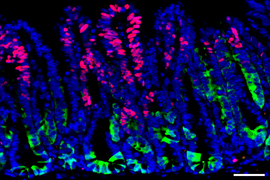
How early-stage cancer cells hide from the immune system
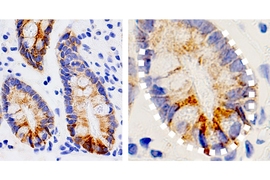
Study links certain metabolites to stem cell function in the intestine

Fasting boosts stem cells’ regenerative capacity

How diet influences colon cancer
More mit news.

Scientists find neurons that process language on different timescales
Read full story →

Pursuing the secrets of a stealthy parasite

Study of disordered rock salts leads to battery breakthrough

Toward a code-breaking quantum computer

Uphill battles: Across the country in 75 days

3 Questions: From the bench to the battlefield
- More news on MIT News homepage →
Massachusetts Institute of Technology 77 Massachusetts Avenue, Cambridge, MA, USA
- Map (opens in new window)
- Events (opens in new window)
- People (opens in new window)
- Careers (opens in new window)
- Accessibility
- Social Media Hub
- MIT on Facebook
- MIT on YouTube
- MIT on Instagram

Style and Grammar Guidelines
APA Style provides a foundation for effective scholarly communication because it helps writers present their ideas in a clear, concise, and inclusive manner. When style works best, ideas flow logically, sources are credited appropriately, and papers are organized predictably. People are described using language that affirms their worth and dignity. Authors plan for ethical compliance and report critical details of their research protocol to allow readers to evaluate findings and other researchers to potentially replicate the studies. Tables and figures present information in an engaging, readable manner.
The style and grammar guidelines pages present information about APA Style as described in the Publication Manual of the American Psychological Association, Seventh Edition and the Concise Guide to APA Style, Seventh Edition . Any updates to APA Style are noted on the applicable topic pages. If you are still using the sixth edition, helpful resources are available in the sixth edition archive .
Looking for more style?

- Accessibility of APA Style
- Line Spacing
- Order of Pages
- Page Header
- Paragraph Alignment and Indentation
- Sample Papers
- Title Page Setup
- Appropriate Level of Citation
- Basic Principles of Citation
- Classroom or Intranet Sources
- Paraphrasing
- Personal Communications
- Quotations From Research Participants
- Secondary Sources
- Abbreviations
- Capitalization
- Italics and Quotation Marks
- Punctuation
- Spelling and Hyphenation
- General Principles for Reducing Bias
- Historical Context
- Intersectionality
- Participation in Research
- Racial and Ethnic Identity
- Sexual Orientation
- Socioeconomic Status
- Accessible Use of Color in Figures
- Figure Setup
- Sample Figures
- Sample Tables
- Table Setup
- Archival Documents and Collections
- Basic Principles of Reference List Entries
- Database Information in References
- DOIs and URLs
- Elements of Reference List Entries
- Missing Reference Information
- Reference Examples
- References in a Meta-Analysis
- Reference Lists Versus Bibliographies
- Works Included in a Reference List
- Active and Passive Voice
- Anthropomorphism
- First-Person Pronouns
- Logical Comparisons
- Plural Nouns
- Possessive Adjectives
- Possessive Nouns
- Singular “They”
- Adapting a Dissertation or Thesis Into a Journal Article
- Correction Notices
- Cover Letters
- Journal Article Reporting Standards (JARS)
- Open Science
- Response to Reviewers
Information
- Author Services
Initiatives
You are accessing a machine-readable page. In order to be human-readable, please install an RSS reader.
All articles published by MDPI are made immediately available worldwide under an open access license. No special permission is required to reuse all or part of the article published by MDPI, including figures and tables. For articles published under an open access Creative Common CC BY license, any part of the article may be reused without permission provided that the original article is clearly cited. For more information, please refer to https://www.mdpi.com/openaccess .
Feature papers represent the most advanced research with significant potential for high impact in the field. A Feature Paper should be a substantial original Article that involves several techniques or approaches, provides an outlook for future research directions and describes possible research applications.
Feature papers are submitted upon individual invitation or recommendation by the scientific editors and must receive positive feedback from the reviewers.
Editor’s Choice articles are based on recommendations by the scientific editors of MDPI journals from around the world. Editors select a small number of articles recently published in the journal that they believe will be particularly interesting to readers, or important in the respective research area. The aim is to provide a snapshot of some of the most exciting work published in the various research areas of the journal.
Original Submission Date Received: .
- Active Journals
- Find a Journal
- Proceedings Series
- For Authors
- For Reviewers
- For Editors
- For Librarians
- For Publishers
- For Societies
- For Conference Organizers
- Open Access Policy
- Institutional Open Access Program
- Special Issues Guidelines
- Editorial Process
- Research and Publication Ethics
- Article Processing Charges
- Testimonials
- Preprints.org
- SciProfiles
- Encyclopedia

Article Menu

- Subscribe SciFeed
- Recommended Articles
- Google Scholar
- on Google Scholar
- Table of Contents
Find support for a specific problem in the support section of our website.
Please let us know what you think of our products and services.
Visit our dedicated information section to learn more about MDPI.
JSmol Viewer
Assessing climate change projections through high-resolution modelling: a comparative study of three european cities.

1. Introduction
2. data and methods, 2.1. study areas, 2.2. the modelling setup and evaluation, 2.3. climate change indices, 3. results and discussion, 3.1. model evaluation for recent past, 3.2. daily mean, maximum and minimum temperature, 3.3. climate change indices, 4. nature-based solutions potential, 5. summary and conclusions, supplementary materials, author contributions, institutional review board statement, informed consent statement, data availability statement, acknowledgments, conflicts of interest.
- Pörtner, D.C.; Roberts, M.; Tignor, E.S.; Poloczanska, K.; Mintenbeck, A.; Alegría, M.; Craig, S.; Langsdorf, S.; Löschke, V.; Möller, A.; et al. (Eds.) IPCC Climate Change 2022: Impacts, Adaptation, and Vulnerability: Contribution of Working Group II to the Sixth Assessment Report of the Intergovernmental Panel on Climate Change ; Cambridge University Press: Cambridge, UK, 2022; ISBN 978-92-9169-159-3. [ Google Scholar ]
- WMO-No. 1320: State of the Climate in Europe 2022 ; World Meteorological Organization: Geneva, Switzerland, 2023. [ Google Scholar ]
- IPCC Sixth Assessment Report. Available online: https://www.ipcc.ch/assessment-report/ar6/ (accessed on 2 August 2024).
- Mbow, C.; Rosenzweig, C.; Barioni, L.G.; Benton, T.G.; Herrero, M.; Krishnapillai, M.; Liwenga, E.; Pradhan, P.; Rivera-Ferre, M.G.; Sapkota, T.; et al. Climate Change and Land: An IPCC Special Report on Climate Change, Desertification, Land Degradation, Sustainable Land Management, Food Security, and Greenhouse Gas Fluxes in Terrestrial Ecosystems ; Shukla, P.R., Skea, J., Calvo Buendia, E., Masson-Delmotte, V., Pörtner, H.-O., Roberts, D.C., Zhai, P., Slade, R., Connors, S., van Diemen, R., et al., Eds.; Cambridge University Press: Cambridge, UK, 2019. [ Google Scholar ]
- Dugord, P.A.; Lauf, S.; Schuster, C.; Kleinschmit, B. Land Use Patterns, Temperature Distribution, and Potential Heat Stress Risk—The Case Study Berlin, Germany. Comput. Environ. Urban Syst. 2014 , 48 , 86–98. [ Google Scholar ] [ CrossRef ]
- Gill, S.E.; Handley, J.F.; Ennos, A.R.; Pauleit, S. Adapting Cities for Climate Change: The Role of the Green Infrastructure. Built Environ. Environ. 2007 , 33 , 115–133. [ Google Scholar ] [ CrossRef ]
- Kim, S.; Ryu, Y. Describing the Spatial Patterns of Heat Vulnerability from Urban Design Perspectives. Int. J. Sustain. Dev. World Ecol. 2015 , 22 , 189–200. [ Google Scholar ] [ CrossRef ]
- Barros, V.R.; Field, C.B.; Dokken, D.J.; Mastrandrea, M.D.; Mach, K.J.; Bilir, T.E.; Chatterjee, M.; Yuka, K.L.E.; Estrada, O.; Genova, R.C. (Eds.) IPCC Climate Change 2014: Impacts, Adaptation, and Vulnerability Part A: Global and Sectoral Aspects Working Group II Contribution to the Fifth Assessment Report of the Intergovernmental Panel on Climate Change ; Cambridge University Press: Cambridge, UK; New York, NY, USA, 2014; 1132p, ISBN 978107641655. [ Google Scholar ]
- Rafael, S.; Augusto, B.; Ascenso, A.; Borrego, C.; Miranda, A.I. Re-Naturing Cities: Evaluating the Effects on Future Air Quality in the City of Porto. Atmos. Environ. 2020 , 222 , 117123. [ Google Scholar ] [ CrossRef ]
- Hobbie, S.E.; Grimm, N.B. Nature-Based Approaches to Managing Climate Change Impacts in Cities. Philos. Trans. R. Soc. B 2020 , 375 , 1794. [ Google Scholar ] [ CrossRef ]
- Jacob, D.; Petersen, J.; Eggert, B.; Alias, A.; Christensen, O.B.; Bouwer, L.M.; Braun, A.; Colette, A.; Déqué, M.; Georgievski, G.; et al. EURO-CORDEX: New High-Resolution Climate Change Projections for European Impact Research. Reg. Environ. Change 2014 , 14 , 563–578. [ Google Scholar ] [ CrossRef ]
- Van Vuuren, D.P.; Edmonds, J.; Kainuma, M.; Riahi, K.; Thomson, A.; Hibbard, K.; Hurtt, G.C.; Kram, T.; Krey, V.; Lamarque, J.-F.; et al. The Representative Concentration Pathways: An Overview. Clim. Change 2011 , 109 , 5–31. [ Google Scholar ] [ CrossRef ]
- Schär, C.; Fuhrer, O.; Arteaga, A.; Ban, N.; Charpilloz, C.; Di Girolamo, S.; Hentgen, L.; Hoefler, T.; Lapillonne, X.; Leutwyler, D.; et al. Kilometer-Scale Climate Models: Prospects and Challenges. Bull. Am. Meteorol. Soc. 2020 , 101 , E567–E587. [ Google Scholar ] [ CrossRef ]
- Tölle, M.H.; Schefczyk, L.; Gutjahr, O. Scale Dependency of Regional Climate Modeling of Current and Future Climate Extremes in Germany. Theor. Appl. Climatol. 2018 , 134 , 829–848. [ Google Scholar ] [ CrossRef ]
- Keppas, S.C.; Papadogiannaki, S.; Parliari, D.; Kontos, S.; Poupkou, A.; Tzoumaka, P.; Kelessis, A.; Zanis, P.; Casasanta, G.; de’Donato, F.; et al. Future Climate Change Impact on Urban Heat Island in Two Mediterranean Cities Based on High-Resolution Regional Climate Simulations. Atmosphere 2021 , 12 , 884. [ Google Scholar ] [ CrossRef ]
- Qiu, L.; Im, E.-S.; Hur, J.; Shim, K.-M. Added Value of Very High Resolution Climate Simulations over South Korea Using WRF Modeling System. Clim. Dyn. 2020 , 54 , 173–189. [ Google Scholar ] [ CrossRef ]
- Coelho, S.; Rafael, S.; Lopes, D.; Miranda, A.I.; Ferreira, J. How Changing Climate May Influence Air Pollution Control Strategies for 2030? Sci. Total Environ. 2021 , 758 , 143911. [ Google Scholar ] [ CrossRef ] [ PubMed ]
- Thomson, A.M.; Calvin, K.V.; Smith, S.J.; Kyle, G.P.; Volke, A.; Patel, P.; Delgado-Arias, S.; Bond-Lamberty, B.; Wise, M.A.; Clarke, L.E.; et al. RCP4.5: A Pathway for Stabilization of Radiative Forcing by 2100. Clim. Change 2011 , 109 , 77–94. [ Google Scholar ] [ CrossRef ]
- Ascenso, A.; Gama, C.; Roebeling, P.; Miranda, A.I. How Effective Are Nature-Based Solutions in Different Environments? Proceedings of the WIT Transactions on Ecology and the Environment. Online, 26–28 October 2021; WIT Press: Billerica MA, USA, 2021; Volume 252, pp. 3–14. [ Google Scholar ] [ CrossRef ]
- Chausson, A.; Turner, B.; Seddon, D.; Chabaneix, N.; Girardin, C.A.J.; Kapos, V.; Key, I.; Roe, D.; Smith, A.; Woroniecki, S.; et al. Mapping the Effectiveness of Nature-Based Solutions for Climate Change Adaptation. Glob. Change Biol. 2020 , 26 , 6134–6155. [ Google Scholar ] [ CrossRef ] [ PubMed ]
- Seddon, N.; Smith, A.; Smith, P.; Key, I.; Chausson, A.; Girardin, C.; House, J.; Srivastava, S.; Turner, B. Getting the Message Right on Nature-Based Solutions to Climate Change. Glob. Change Biol. 2021 , 27 , 1518–1546. [ Google Scholar ] [ CrossRef ]
- Pereira, P.; Yin, C.; Hua, T. Nature-Based Solutions, Ecosystem Services, Disservices, and Impacts on Well-Being in Urban Environments. Curr. Opin. Environ. Sci. Health 2023 , 33 , 100465. [ Google Scholar ] [ CrossRef ]
- Coelho, S.; Rafael, S.; Coutinho, M.; Monteiro, A.; Medina, J.; Figueiredo, S.; Cunha, S.; Lopes, M.; Miranda, A.I.; Borrego, C. Climate-Change Adaptation Framework for Multiple Urban Areas in Northern Portugal. Environ. Manag. 2020 , 66 , 395–406. [ Google Scholar ] [ CrossRef ]
- Municipality of Eindhoven Eindhoven | Population & Governance. Available online: https://onderzoek.eindhoven.nl/basisinfo/bevolking-bestuur (accessed on 2 August 2022).
- KNMI Climatology, Daily Data of the Weather in the Netherlands—Download. Available online: http://projects.knmi.nl/klimatologie/daggegevens/selectie.cgi (accessed on 2 August 2022).
- Ascenso, A.; Augusto, B.; Silveira, C.; Rafael, S.; Coelho, S.; Monteiro, A.; Ferreira, J.; Menezes, I.; Roebeling, P.; Miranda, A.I. Impacts of Nature-Based Solutions on the Urban Atmospheric Environment: A Case Study for Eindhoven, The Netherlands. Urban For. Urban Green. 2021 , 57 , 126870. [ Google Scholar ] [ CrossRef ]
- Augusto, B.; Roebeling, P.; Rafael, S.; Ferreira, J.; Ascenso, A.; Bodilis, C. Short and Medium- to Long-Term Impacts of Nature-Based Solutions on Urban Heat. Sustain. Cities Soc. 2020 , 57 , 102122. [ Google Scholar ] [ CrossRef ]
- Costa, S.; Peters, R.; Martins, R.; Postmes, L.; Keizer, J.J.; Roebeling, P. Effectiveness of Nature-Based Solutions on Pluvial Flood Hazard Mitigation: The Case Study of the City of Eindhoven (The Netherlands). Resources 2021 , 10 , 24. [ Google Scholar ] [ CrossRef ]
- Roebeling, P.; Saraiva, M.; Gneco, I.; Palla, A.; Alves, H.; Rocha, J.; Martins, F. Sustainable Urbanizing Landscape Development (SULD) Decision Support Tool: Report on Other Aqua Cases ; Aqua-Add Project, Aqua-Add Technical Report No.04.; Open Repository of the University of Porto: Porto, Portugal, 2014; Volume 33. [ Google Scholar ]
- Saraiva, M.; Roebeling, P.; Sousa, S.; Teotónio, C.; Palla, A.; Gnecco, I. Dimensions of Shrinkage: Evaluating the Socio-Economic Consequences of Population Decline in Two Medium-Sized Cities in Europe, Using the SULD Decision Support Tool. Environ. Plan. B Urban Anal. City Sci. 2017 , 44 , 1122–1144. [ Google Scholar ] [ CrossRef ]
- Istat—Istituto Nazionale di Statistica Resident Population on 1st January. Available online: http://dati.istat.it/?lang=en (accessed on 2 August 2022).
- Acquaotta, F.; Faccini, F.; Fratianni, S.; Paliaga, G.; Sacchini, A.; Vilímek, V. Increased Flash Flooding in Genoa Metropolitan Area: A Combination of Climate Changes and Soil Consumption? Meteorol. Atmos. Phys. 2019 , 131 , 1099–1110. [ Google Scholar ] [ CrossRef ]
- Weatherbase Genoa, Italy Koppen Climate Classification. Available online: https://www.weatherbase.com/weather/weather-summary.php3?s=2161&cityname=Genoa,+Italy,%202021 (accessed on 20 June 2022).
- Rodrigues, V.; Gama, C.; Ascenso, A.; Oliveira, K.; Coelho, S.; Monteiro, A.; Hayes, E.; Lopes, M. Assessing Air Pollution in European Cities to Support a Citizen Centered Approach to Air Quality Management. Sci. Total Environ. 2021 , 799 , 149311. [ Google Scholar ] [ CrossRef ]
- Laikari, A.; Dubovik, M.; Rinta-Hiiro, V.; Wendling, L.; Postmes, L.; Van Dinter, M.; Den Hollander, M.; Van Der Putten, P.; Särkilahti, M.; Leppänen, S.; et al. NBS Demonstration Site Start-Up Report ; Urban Natures Lab: Brussels, Belgium, 2021. [ Google Scholar ]
- Acquaotta, F.; Faccini, F.; Fratianni, S.; Paliaga, G.; Sacchini, A. Rainfall Intensity in the Genoa Metropolitan Area: Secular Variations and Consequences. Weather 2018 , 73 , 356–362. [ Google Scholar ] [ CrossRef ]
- Statistics Finland Key Figures on Population by Area, Information and Year. Available online: https://pxweb2.stat.fi/PxWeb/pxweb/en/StatFin/StatFin__vaerak/statfin_vaerak_pxt_11ra.px/ (accessed on 2 August 2022).
- Tampere City Board. Carbon Neutral Tampere 2030 Roadmap . 2020. Available online: https://www.tampere.fi/sites/default/files/2022-06/Carbon_Neutral_Tampere_2030_Roadmap.pdf (accessed on 2 August 2024).
- Skamarock, C.; Klemp, B.; Dudhia, J.; Gill, O.; Barker, D.; Duda, G.; Huang, X.; Wang, W.; Powers, G. A Description of the Advanced Research WRF Version 3 ; No. NCAR/TN-475+STR; University Corporation for Atmospheric Research: Boulder, CO, USA, 2008. [ Google Scholar ] [ CrossRef ]
- Fita, L.; Fernández, J.; García-Díez, M. CLWRF: WRF Modifications for Regional Climate Simulation under Future Scenarios. In Proceedings of the 11th WRF Users’ Workshop, Boulder, CO, USA, 22–24 June 2010. [ Google Scholar ]
- Fita, L.; Fernández, J.; García-Díez, M. CORINE Land Cover Technical Guide—Addendum 2000 ; European Environment Agency: Copenhagen, Denmark, 2000.
- Pineda, N.; Jorba, O.; Jorge, J.; Baldasano, J.M. Using NOAA AVHRR and SPOT VGT Data to Estimate Surface Parameters: Application to a Mesoscale Meteorological Model. Int. J. Remote Sens. 2004 , 25 , 129–143. [ Google Scholar ] [ CrossRef ]
- Regione Liguria Consultazione Dati Meteoclimatici. Available online: https://ambientepub.regione.liguria.it/SiraQualMeteo/script/PubAccessoDatiMeteo.asp (accessed on 2 August 2022).
- Finnish Meteorological Institute Weather and Sea—Download Observations. Available online: https://en.ilmatieteenlaitos.fi/download-observations (accessed on 3 August 2022).
- Borrego, C.; Monteiro, A.; Ferreira, J.; Miranda, A.I.; Costa, A.M.; Carvalho, A.C.; Lopes, M. Procedures for Estimation of Modelling Uncertainty in Air Quality Assessment. Environ. Int. 2008 , 34 , 613–620. [ Google Scholar ] [ CrossRef ] [ PubMed ]
- Schlünzen, K.H.; Sokhi, R.S. Overview of Tools and Methods for Meteorological and Air Pollution Mesoscale Model Evaluation and User Training ; WMO/TD; WMO: Geneva, Switzerland, 2008; Volume 41, ISBN 978-1-905313-59-4. [ Google Scholar ]
- Hong, S.Y.; Lim, J.O.J. The WRF Single Moment 6 Class Microphysics Scheme (WSM6). J. Korean Meteorol. Soc. 2006 , 42 , 129–151. [ Google Scholar ]
- Dudhia, J. Numerical Study of Convection Observed during the Winter Monsoon Experiment Using a Mesoscale Two-Dimensional Model. J. Atmos. Sci. 1989 , 46 , 3077–3107. [ Google Scholar ] [ CrossRef ]
- Mlawer, E.J.; Taubman, S.J.; Brown, P.D.; Iacono, M.J.; Clough, S.A. Radiative Transfer for Inhomogeneous Atmospheres: RRTM, a Validated Correlated-k Model for the Longwave. J. Geophys. Res. D Atmos. 1997 , 102 , 16663–16682. [ Google Scholar ] [ CrossRef ]
- Zhang, D.; Anthes, R.A. A High-Resolution Model of the Planetary Boundary Layer—Sensitivity Tests and Comparisons with SESAME-79 Data. J. Appl. Meteorol. 1982 , 21 , 1594–1609. [ Google Scholar ] [ CrossRef ]
- Tewari, M.; Chen, F.; Wang, W.; Dudhia, J.; LeMone, M.A.; Mitchell, K.; Ek, M.; Gayno, G.; Wegiel, J.; Cuenca, R.H. Implementation and Verification of the Unified Noah Land Surface Model in the WRF Model. In Proceedings of the 20th Conference on Weather Analysis and Forecasting/16th Conference on Numerical Weather Prediction, Seattle, WA, USA, 12–16 January 2004. [ Google Scholar ]
- Hong, S.Y.; Noh, Y.; Dudhia, J. A New Vertical Diffusion Package with an Explicit Treatment of Entrainment Processes. Mon. Weather Rev. 2006 , 134 , 2318–2341. [ Google Scholar ] [ CrossRef ]
- Grell, G.A.; Freitas, S.R. A Scale and Aerosol Aware Stochastic Convective Parameterization for Weather and Air Quality Modeling. Atmos. Chem. Phys. 2014 , 14 , 5233–5250. [ Google Scholar ] [ CrossRef ]
- Giorgetta, M.A.; Jungclaus, J.; Reick, C.H.; Legutke, S.; Bader, J.; Böttinger, M.; Brovkin, V.; Crueger, T.; Esch, M.; Fieg, K.; et al. Climate and Carbon Cycle Changes from 1850 to 2100 in MPI-ESM Simulations for the Coupled Model Intercomparison Project Phase 5. J. Adv. Model Earth Syst. 2013 , 5 , 572–597. [ Google Scholar ] [ CrossRef ]
- Riahi, K.; Grübler, A.; Nakicenovic, N. Scenarios of Long-Term Socio-Economic and Environmental Development under Climate Stabilization. Technol. Forecast Soc. Change 2007 , 74 , 887–935. [ Google Scholar ] [ CrossRef ]
- Rafael, S.; Martins, H.; Marta-Almeida, M.; Sá, E.; Coelho, S.; Rocha, A.; Borrego, C.; Lopes, M. Quantification and Mapping of Urban Fluxes under Climate Change: Application of WRF-SUEWS Model to Greater Porto Area (Portugal). Environ. Res. 2017 , 155 , 321–334. [ Google Scholar ] [ CrossRef ] [ PubMed ]
- Klein Tank, A.M.; Zwiers, F.W.; Zhang, X.; Canada, E. Guidelines on Analysis of Extremes in a Changing Climate in Support of Informed Decisions for Adaptation ; World Meteorological Organization: Geneva, Switzerland, 2009. [ Google Scholar ]
- European Commission; Directorate-General for Research and Innovation. Evaluating the Impact of Nature-Based Solutions: A Handbook for Practitioners ; Dumitru, A., Wendling, L., Eds.; Publications Office of the European Union: Luxembourg, 2021; ISBN 978-92-76-22821-9. [ Google Scholar ]
- Lee, S.H.; Lee, K.S.; Jin, W.C.; Song, H.K. Effect of an Urban Park on Air Temperature Differences in a Central Business District Area. Landsc. Ecol. Eng. 2009 , 5 , 183–191. [ Google Scholar ] [ CrossRef ]
- Hamouda, M.E.; Pasquero, C. European Extreme Precipitation: The Effects of Spatio-Temporal Resolution of the Data. Weather Clim. Extrem. 2021 , 33 , 100337. [ Google Scholar ] [ CrossRef ]
- Marta-Almeida, M.; Teixeira, J.C.; Carvalho, M.J.; Melo-Gonçalves, P.; Rocha, A.M. High Resolution WRF Climatic Simulations for the Iberian Peninsula: Model Validation. Phys. Chem. Earth Parts A/B/C 2016 , 94 , 94–105. [ Google Scholar ] [ CrossRef ]
- Pieri, A.B.; von Hardenberg, J.; Parodi, A.; Provenzale, A. Sensitivity of Precipitation Statistics to Resolution, Microphysics, and Convective Parameterization: A Case Study with the High-Resolution WRF Climate Model over Europe. J. Hydrometeorol. 2015 , 16 , 1857–1872. [ Google Scholar ] [ CrossRef ]
- Yang, B.; Qian, Y.; Lin, G.; Leung, R.; Zhang, Y. Some Issues in Uncertainty Quantification and Parameter Tuning: A Case Study of Convective Parameterization Scheme in the WRF Regional Climate Model. Atmos. Chem. Phys. 2012 , 12 , 2409–2427. [ Google Scholar ] [ CrossRef ]
- Strangeways, I. Measuring Global Temperature: Their Analysis and Interpretation ; Cambridge University Press: Cambridge, UK, 2010. [ Google Scholar ]
- Wang, X.; Hou, X.; Piao, Y.; Feng, A.; Li, Y. Climate Change Projections of Temperature Over the Coastal Area of China Using SimCLIM. Front. Environ. Sci. 2021 , 9 , 548. [ Google Scholar ] [ CrossRef ]
- Cholakian, A.; Colette, A.; Coll, I.; Ciarelli, G.; Beekmann, M. Future Climatic Drivers and Their Effect on PM10 Components in Europe and the Mediterranean Sea. Atmos. Chem. Phys. 2019 , 19 , 4459–4484. [ Google Scholar ] [ CrossRef ]
- Warscher, M.; Wagner, S.; Marke, T.; Laux, P.; Smiatek, G.; Strasser, U.; Kunstmann, H. A 5 Km Resolution Regional Climate Simulation for Central Europe: Performance in High Mountain Areas and Seasonal, Regional and Elevation-Dependent Variations. Atmosphere 2019 , 10 , 682. [ Google Scholar ] [ CrossRef ]
- Ruosteenoja, K.; Markkanen, T.; Räisänen, J. Thermal Seasons in Northern Europe in Projected Future Climate. Int. J. Climatol. 2020 , 40 , 4444–4462. [ Google Scholar ] [ CrossRef ]
- KNMI KNMI’14: Climate Change Scenarios for the 21st Century–A Netherlands Perspective ; Hurk, B.; van den Siegmund, P.; Tank, A.K. (Eds.) KNMI: De Bilt, The Netherlands, 2014. [ Google Scholar ]
- Lecœur, È.; Seigneur, C.; Pagé, C.; Terray, L. A Statistical Method to Estimate PM2.5 Concentrations from Meteorology and Its Application to the Effect of Climate Change. J. Geophys. Res. Atmos. 2014 , 119 , 3537–3585. [ Google Scholar ] [ CrossRef ]
- D’Oria, M.; Cozzi, C.; Tanda, M.G. Future Precipitation and Temperature Changes over the Taro, Parma and Enza River Basins in Northern Italy. Ital. J. Eng. Geol. Environ. 2018 , 2018 , 49–63. [ Google Scholar ] [ CrossRef ]
- D’Oria, M.; Ferraresi, M.; Tanda, M.G. Historical Trends and High-Resolution Future Climate Projections in Northern Tuscany (Italy). J. Hydrol. 2017 , 555 , 708–723. [ Google Scholar ] [ CrossRef ]
- Ruosteenoja, K.; Jylhä, K.; Kämäräinen, M. Climate Projections for Finland Under the RCP Forcing Scenarios. Geophysica 2016 , 51 , 17–50. [ Google Scholar ]
- Keuler, K.; Radtke, K.; Kotlarski, S.; Lüthi, D. Regional Climate Change over Europe in COSMO-CLM: Influence of Emission Scenario and Driving Global Model. Meteorol. Z. 2016 , 25 , 121–136. [ Google Scholar ] [ CrossRef ]
- Collins, M.; Knutti, R.; Arblaster, J.; Dufresne, J.-L.; Fichefet, T.; Friedlingstein, P.; Gao, X.; Gutowski, W.J.; Johns, T.; Krinner, G.; et al. Long-Term Climate Change: Projections, Commitments and Irreversibility. In Climate Change 2013: The Physical Science Basis. Contribution of Working Group I to the Fifth Assessment Report of the Intergovernmental Panel on Climate Change ; Stocker, T.F., Qin, D., Plattner, G.-K., Tignor, M., Allen, S.K., Boschung, J., Nauels, A., Xia, Y., Midgley, V.B., Eds.; Cambridge University Press: Cambridge, UK; New York, NY, USA, 2013. [ Google Scholar ]
- Maule, C.F.; Mendlik, T.; Christensen, O.B. The Effect of the Pathway to a Two Degrees Warmer World on the Regional Temperature Change of Europe. Clim. Serv. 2017 , 7 , 3–11. [ Google Scholar ] [ CrossRef ]
- Ban, N.; Schmidli, J.; Schär, C. Evaluation of the Convection-Resolving Regional Climate Modeling Approach in Decade-Long Simulations. J. Geophys. Res. Atmos. 2014 , 119 , 7889–7907. [ Google Scholar ] [ CrossRef ]
- Fernández, J.; Frías, M.D.; Cabos, W.D.; Cofiño, A.S.; Domínguez, M.; Fita, L.; Gaertner, M.A.; García-Díez, M.; Gutiérrez, J.M.; Jiménez-Guerrero, P.; et al. Consistency of Climate Change Projections from Multiple Global and Regional Model Intercomparison Projects. Clim. Dyn. 2019 , 52 , 1139–1156. [ Google Scholar ] [ CrossRef ]
- Giorgi, F.; Gutowski, W.J. Regional Dynamical Downscaling and the CORDEX Initiative. Annu. Rev. Environ. Resour. 2015 , 40 , 467–490. [ Google Scholar ] [ CrossRef ]
- Prein, A.F.; Gobiet, A.; Suklitsch, M.; Truhetz, H.; Awan, N.K.; Keuler, K.; Georgievski, G. Added Value of Convection Permitting Seasonal Simulations. Clim. Dyn. 2013 , 41 , 2655–2677. [ Google Scholar ] [ CrossRef ]
- Kim, S.; Sinclair, V.A.; Räisänen, J.; Ruuhela, R. Heat Waves in Finland: Present and Projected Summertime Extreme Temperatures and Their Associated Circulation Patterns. Int. J. Climatol. 2018 , 38 , 5253. [ Google Scholar ] [ CrossRef ]
- Jylhä, K.; Jokisalo, J.; Ruosteenoja, K.; Pilli-Sihvola, K.; Kalamees, T.; Seitola, T.; Mäkelä, H.M.; Hyvönen, R.; Laapas, M.; Drebs, A. Energy Demand for the Heating and Cooling of Residential Houses in Finland in a Changing Climate. Energy Build. 2015 , 99 , 104–116. [ Google Scholar ] [ CrossRef ]
- Pepin, N.; Bradley, R.S.; Diaz, H.F.; Baraer, M.; Caceres, E.B.; Forsythe, N.; Fowler, H.; Greenwood, G.; Hashmi, M.Z.; Liu, X.D.; et al. Elevation-Dependent Warming in Mountain Regions of the World. Nat. Clim. Change 2015 , 5 , 424–430. [ Google Scholar ] [ CrossRef ]
- Oswald, S.M.; Hollosi, B.; Žuvela-Aloise, M.; See, L.; Guggenberger, S.; Hafner, W.; Prokop, G.; Storch, A.; Schieder, W. Using Urban Climate Modelling and Improved Land Use Classifications to Support Climate Change Adaptation in Urban Environments: A Case Study for the City of Klagenfurt, Austria. Urban Clim. 2020 , 31 , 100582. [ Google Scholar ] [ CrossRef ]
- De Wit, R.; Kainz, A.; Goler, R.; Žuvela-Aloise, M.; Hahn, C.; Zuccaro, G.; Leone, M.; Loibl, W.; Tötzer, T.; Hager, W.; et al. Supporting Climate Proof Planning with CLARITY’s Climate Service and Modelling of Climate Adaptation Strategies—The Linz Use-Case. Urban Clim. 2020 , 34 , 100675. [ Google Scholar ] [ CrossRef ]
- Gál, T.; Mahó, S.I.; Skarbit, N.; Unger, J. Numerical Modelling for Analysis of the Effect of Different Urban Green Spaces on Urban Heat Load Patterns in the Present and in the Future. Comput. Environ. Urban Syst. 2021 , 87 , 101600. [ Google Scholar ] [ CrossRef ]
- He, C.; He, L.; Zhang, Y.; Kinney, P.L.; Ma, W. Potential Impacts of Cool and Green Roofs on Temperature-Related Mortality in the Greater Boston Region. Environ. Res. Lett. 2020 , 15 , 094042. [ Google Scholar ] [ CrossRef ]
- Rafael, S.; Correia, L.P.; Ascenso, A.; Augusto, B.; Lopes, D.; Miranda, A.I. Are Green Roofs the Path to Clean Air and Low Carbon Cities? Sci. Total Environ. 2021 , 798 , 149313. [ Google Scholar ] [ CrossRef ]
- Zhao, J.; Zhao, X.; Liang, S.; Wang, H.; Liu, N.; Liu, P.; Wu, D. Dynamic Cooling Effects of Permanent Urban Green Spaces in Beijing, China. Remote Sens. 2021 , 13 , 3282. [ Google Scholar ] [ CrossRef ]
Click here to enlarge figure
| Simulation Period | Eindhoven | Genova | Tampere |
|---|---|---|---|
| Recent past | 2013 | 2013 | 2012 |
| Medium-term future | 2048 | 2051 | 2052 |
| Index | Name | Definition |
|---|---|---|
| DTR | Daily Temperature Range | Difference between daily maximum and minimum temperatures |
| SU | Summer days | Number of days where the daily maximum temperature is higher than 25 °C |
| TR | Tropical nights | Number of days where the daily minimum temperature is higher than 20 °C |
| ID | Icing days | Number of days where the daily maximum temperature is lower than 0 °C |
| FD | Frost days | Number of days where the daily minimum temperature is lower than 0 °C |
| Daily Average Temperature | Daily Precipitation | ||||||
|---|---|---|---|---|---|---|---|
| City | Name | r | Bias (°C) | RMSE (°C) | r | Bias (mm) | RMSE (mm) |
| Eindhoven | Airport | 0.99 | 0.24 | 1.29 | 0.61 | 0.55 | 4.14 |
| Genova | Bolzaneto | 0.98 | 0.38 | 1.26 | 0.75 | −0.29 | 7.57 |
| Castellaccio | 0.99 | 2.14 | 2.44 | 0.60 | 1.84 | 11.63 | |
| Centro Funzionale | 0.98 | −1.14 | 1.65 | 0.63 | 0.74 | 8.56 | |
| Gavette | ---- | ---- | ---- | 0.66 | 0.01 | 9.09 | |
| Pegli | 0.98 | −1.22 | 1.85 | ---- | ---- | ---- | |
| Pontedecimo | 0.99 | 0.23 | 1.28 | 0.75 | 0.30 | 8.70 | |
| Tampere | Harmala | ---- | ---- | ---- | 0.55 | 5.38 | 14.17 |
| Airport | 0.99 | 1.42 | 2.17 | ---- | ---- | ---- | |
| Siilinkari | 0.99 | −0.83 | 1.73 | ---- | ---- | ---- | |
| DJF | MAM | JJA | SON | ANNUAL | ||
|---|---|---|---|---|---|---|
| Eindhoven | +0.94 | +0.70 | +0.29 | −1.03 | +0.26 | |
| Genova | +0.94 | −0.22 | −0.38 | −0.04 | +0.09 | |
| Tampere | −2.92 | −1.25 | +1.77 | +0.95 | −0.31 | |
| Eindhoven | +0.91 | +1.16 | +0.30 | −0.93 | +0.40 | |
| Genova | +0.94 | 0.00 | −0.57 | −0.26 | +0.04 | |
| Tampere | −2.94 | −1.03 | +1.69 | +0.75 | −0.33 | |
| Eindhoven | +0.73 | +0.32 | +0.05 | −1.27 | −0.01 | |
| Genova | +0.81 | −0.51 | −0.23 | +0.07 | +0.05 | |
| Tampere | −2.87 | −1.40 | +1.77 | +1.13 | −0.29 |
| Ref. | Location | Resolution (km ) | ∆Tmean (°C) |
|---|---|---|---|
| EURO-CORDEX * | Eindhoven | 12.5 × 12.5 | −3.5 |
| KNMI [ ] | Netherlands | 11 × 11 | 1 |
| Lecœur et al. [ ] | Netherlands | 50 × 50 | 0.5–1.5 |
| EURO-CORDEX * | Genova | 12.5 × 12.5 | 0.4 |
| Cholakian et al. [ ] | Western Mediterranean | 50 × 50 | 1.77 |
| D’oria et al. [ ] | Northern Italy | 12.5 × 12.5 | 1.5 |
| D’oria et al. [ ] | Northern Tuscany | 12.5 × 12.5 | 0.8 |
| Lecœur et al. [ ] | Italy | 50 × 50 | 0.5–1.5 |
| EURO-CORDEX * | Tampere | 12.5 × 12.5 | 0.6 |
| Ruosteenoja et al. [ ] | Finland | 50 × 50 | 1.8 |
| Lecœur et al. [ ] | Finland | 50 × 50 | 0.5–1.5 |
| DJF | MAM | JJA | SON | ANNUAL | ||
|---|---|---|---|---|---|---|
| (°C) (%) | Eindhoven | 4.47 | 8.18 | 8.22 | 6.56 | 6.88 |
| (+4%) | (+11%) | (+3%) | (+5%) | (+6%) | ||
| Genova | 4.25 | 5.45 | 4.96 | 4.90 | 4.89 | |
| (+3%) | (+11%) | (−6%) | (−6%) | (+0%) | ||
| Tampere | 3.08 | 5.05 | 5.61 | 3.43 | 4.30 | |
| (−2%) | (+8%) | (−1%) | (−10%) | (−1%) | ||
| (days per season) | Eindhoven | 0.00 | 2.41 | 22.60 | 4.01 | 29.02 |
| (0.00) | (+2.37) | (+5.80) | (−8.13) | (+0.04) | ||
| Genova | 0.00 | 0.05 | 25.03 | 0.97 | 26.04 | |
| (0.00) | (−0.13) | (+6.50) | (−7.44) | (−1.06) | ||
| Tampere | 0.00 | 0.00 | 0.50 | 0.00 | 0.50 | |
| (+0.00) | (+0.00) | (+0.50) | (+0.00) | (+0.50) | ||
| (nights per season) | Eindhoven | 0.00 | 0.37 | 4.27 | 0.84 | 5.48 |
| (+0.00) | (+0.37) | (+1.02) | (−3.10) | (−1.71) | ||
| Genova | 0.00 | 0.00 | 27.51 | 7.31 | 34.83 | |
| (+0.00) | (+0.00) | (−0.63) | (−5.81) | (−6.43) | ||
| Tampere | 0.00 | 0.00 | 0.00 | 0.00 | 0.00 | |
| (+0.00) | (+0.00) | (+0.00) | (+0.00) | (+0.00) | ||
| (days per season) | Eindhoven | 6.41 | 1.46 | 0.00 | 4.24 | 12.11 |
| (−0.56) | (+1.46) | (+0.00) | (+4.24) | (+5.14) | ||
| Genova | 1.93 | 0.00 | 0.00 | 0.00 | 1.93 | |
| (−0.78) | (+0.00) | (+0.00) | (+0.00) | (−0.78) | ||
| Tampere | 61.23 | 26.00 | 0.00 | 1.00 | 88.00 | |
| (+12.87) | (+14.51) | (+0.00) | (−15.23) | (+12.16) | ||
| (days per season) | Eindhoven | 24.80 | 6.58 | 0.00 | 8.67 | 40.06 |
| (−7.24) | (+4.95) | (+0.00) | (+8.18) | (+5.89) | ||
| Genova | 11.20 | 0.44 | 0.00 | 0.09 | 11.73 | |
| (−4.22) | (−0.73) | (+0.00) | (−0.13) | (−5.09) | ||
| Tampere | 75.93 | 40.90 | 0.00 | 5.32 | 122.15 | |
| (+2.24) | (−2.78) | (+0.00) | (−16.35) | (−16.89) |
| The statements, opinions and data contained in all publications are solely those of the individual author(s) and contributor(s) and not of MDPI and/or the editor(s). MDPI and/or the editor(s) disclaim responsibility for any injury to people or property resulting from any ideas, methods, instructions or products referred to in the content. |
Share and Cite
Ascenso, A.; Augusto, B.; Coelho, S.; Menezes, I.; Monteiro, A.; Rafael, S.; Ferreira, J.; Gama, C.; Roebeling, P.; Miranda, A.I. Assessing Climate Change Projections through High-Resolution Modelling: A Comparative Study of Three European Cities. Sustainability 2024 , 16 , 7276. https://doi.org/10.3390/su16177276
Ascenso A, Augusto B, Coelho S, Menezes I, Monteiro A, Rafael S, Ferreira J, Gama C, Roebeling P, Miranda AI. Assessing Climate Change Projections through High-Resolution Modelling: A Comparative Study of Three European Cities. Sustainability . 2024; 16(17):7276. https://doi.org/10.3390/su16177276
Ascenso, Ana, Bruno Augusto, Sílvia Coelho, Isilda Menezes, Alexandra Monteiro, Sandra Rafael, Joana Ferreira, Carla Gama, Peter Roebeling, and Ana Isabel Miranda. 2024. "Assessing Climate Change Projections through High-Resolution Modelling: A Comparative Study of Three European Cities" Sustainability 16, no. 17: 7276. https://doi.org/10.3390/su16177276
Article Metrics
Article access statistics, supplementary material.
ZIP-Document (ZIP, 100 KiB)
Further Information
Mdpi initiatives, follow mdpi.

Subscribe to receive issue release notifications and newsletters from MDPI journals
Thank you for visiting nature.com. You are using a browser version with limited support for CSS. To obtain the best experience, we recommend you use a more up to date browser (or turn off compatibility mode in Internet Explorer). In the meantime, to ensure continued support, we are displaying the site without styles and JavaScript.
- View all journals
- Explore content
- About the journal
- Publish with us
- Sign up for alerts
- Open access
- Published: 22 July 2024
Neural general circulation models for weather and climate
- Dmitrii Kochkov ORCID: orcid.org/0000-0003-3846-4911 1 na1 ,
- Janni Yuval ORCID: orcid.org/0000-0001-7519-0118 1 na1 ,
- Ian Langmore 1 na1 ,
- Peter Norgaard 1 na1 ,
- Jamie Smith 1 na1 ,
- Griffin Mooers 1 ,
- Milan Klöwer 2 ,
- James Lottes 1 ,
- Stephan Rasp 1 ,
- Peter Düben ORCID: orcid.org/0000-0002-4610-3326 3 ,
- Sam Hatfield 3 ,
- Peter Battaglia 4 ,
- Alvaro Sanchez-Gonzalez 4 ,
- Matthew Willson ORCID: orcid.org/0000-0002-8730-1927 4 ,
- Michael P. Brenner 1 , 5 &
- Stephan Hoyer ORCID: orcid.org/0000-0002-5207-0380 1 na1
Nature ( 2024 ) Cite this article
53k Accesses
3 Citations
677 Altmetric
Metrics details
- Atmospheric dynamics
- Climate and Earth system modelling
- Computational science
General circulation models (GCMs) are the foundation of weather and climate prediction 1 , 2 . GCMs are physics-based simulators that combine a numerical solver for large-scale dynamics with tuned representations for small-scale processes such as cloud formation. Recently, machine-learning models trained on reanalysis data have achieved comparable or better skill than GCMs for deterministic weather forecasting 3 , 4 . However, these models have not demonstrated improved ensemble forecasts, or shown sufficient stability for long-term weather and climate simulations. Here we present a GCM that combines a differentiable solver for atmospheric dynamics with machine-learning components and show that it can generate forecasts of deterministic weather, ensemble weather and climate on par with the best machine-learning and physics-based methods. NeuralGCM is competitive with machine-learning models for one- to ten-day forecasts, and with the European Centre for Medium-Range Weather Forecasts ensemble prediction for one- to fifteen-day forecasts. With prescribed sea surface temperature, NeuralGCM can accurately track climate metrics for multiple decades, and climate forecasts with 140-kilometre resolution show emergent phenomena such as realistic frequency and trajectories of tropical cyclones. For both weather and climate, our approach offers orders of magnitude computational savings over conventional GCMs, although our model does not extrapolate to substantially different future climates. Our results show that end-to-end deep learning is compatible with tasks performed by conventional GCMs and can enhance the large-scale physical simulations that are essential for understanding and predicting the Earth system.
Similar content being viewed by others

Accurate medium-range global weather forecasting with 3D neural networks
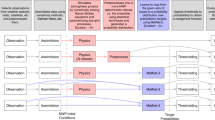
Deep learning for twelve hour precipitation forecasts
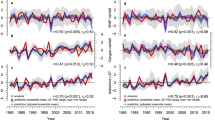
Skilful predictions of the Asian summer monsoon one year ahead
Solving the equations for Earth’s atmosphere with general circulation models (GCMs) is the basis of weather and climate prediction 1 , 2 . Over the past 70 years, GCMs have been steadily improved with better numerical methods and more detailed physical models, while exploiting faster computers to run at higher resolution. Inside GCMs, the unresolved physical processes such as clouds, radiation and precipitation are represented by semi-empirical parameterizations. Tuning GCMs to match historical data remains a manual process 5 , and GCMs retain many persistent errors and biases 6 , 7 , 8 . The difficulty of reducing uncertainty in long-term climate projections 9 and estimating distributions of extreme weather events 10 presents major challenges for climate mitigation and adaptation 11 .
Recent advances in machine learning have presented an alternative for weather forecasting 3 , 4 , 12 , 13 . These models rely solely on machine-learning techniques, using roughly 40 years of historical data from the European Center for Medium-Range Weather Forecasts (ECMWF) reanalysis v5 (ERA5) 14 for model training and forecast initialization. Machine-learning methods have been remarkably successful, demonstrating state-of-the-art deterministic forecasts for 1- to 10-day weather prediction at a fraction of the computational cost of traditional models 3 , 4 . Machine-learning atmospheric models also require considerably less code, for example GraphCast 3 has 5,417 lines versus 376,578 lines for the National Oceanic and Atmospheric Administration’s FV3 atmospheric model 15 (see Supplementary Information section A for details).
Nevertheless, machine-learning approaches have noteworthy limitations compared with GCMs. Existing machine-learning models have focused on deterministic prediction, and surpass deterministic numerical weather prediction in terms of the aggregate metrics for which they are trained 3 , 4 . However, they do not produce calibrated uncertainty estimates 4 , which is essential for useful weather forecasts 1 . Deterministic machine-learning models using a mean-squared-error loss are rewarded for averaging over uncertainty, producing unrealistically blurry predictions when optimized for multi-day forecasts 3 , 13 . Unlike physical models, machine-learning models misrepresent derived (diagnostic) variables such as geostrophic wind 16 . Furthermore, although there has been some success in using machine-learning approaches on longer timescales 17 , 18 , these models have not demonstrated the ability to outperform existing GCMs.
Hybrid models that combine GCMs with machine learning are appealing because they build on the interpretability, extensibility and successful track record of traditional atmospheric models 19 , 20 . In the hybrid model approach, a machine-learning component replaces or corrects the traditional physical parameterizations of a GCM. Until now, the machine-learning component in such models has been trained ‘offline’, by learning parameterizations independently of their interaction with dynamics. These components are then inserted into an existing GCM. The lack of coupling between machine-learning components and the governing equations during training potentially causes serious problems, such as instability and climate drift 21 . So far, hybrid models have mostly been limited to idealized scenarios such as aquaplanets 22 , 23 . Under realistic conditions, machine-learning corrections have reduced some biases of very coarse GCMs 24 , 25 , 26 , but performance remains considerably worse than state-of-the-art models.
Here we present NeuralGCM, a fully differentiable hybrid GCM of Earth’s atmosphere. NeuralGCM is trained on forecasting up to 5-day weather trajectories sampled from ERA5. Differentiability enables end-to-end ‘online training’ 27 , with machine-learning components optimized in the context of interactions with the governing equations for large-scale dynamics, which we find enables accurate and stable forecasts. NeuralGCM produces physically consistent forecasts with accuracy comparable to best-in-class models across a range of timescales, from 1- to 15-day weather to decadal climate prediction.
Neural GCMs
A schematic of NeuralGCM is shown in Fig. 1 . The two key components of NeuralGCM are a differentiable dynamical core for solving the discretized governing dynamical equations and a learned physics module that parameterizes physical processes with a neural network, described in full detail in Methods , Supplementary Information sections B and C , and Supplementary Table 1 . The dynamical core simulates large-scale fluid motion and thermodynamics under the influence of gravity and the Coriolis force. The learned physics module (Supplementary Fig. 1 ) predicts the effect of unresolved processes, such as cloud formation, radiative transport, precipitation and subgrid-scale dynamics, on the simulated fields using a neural network.
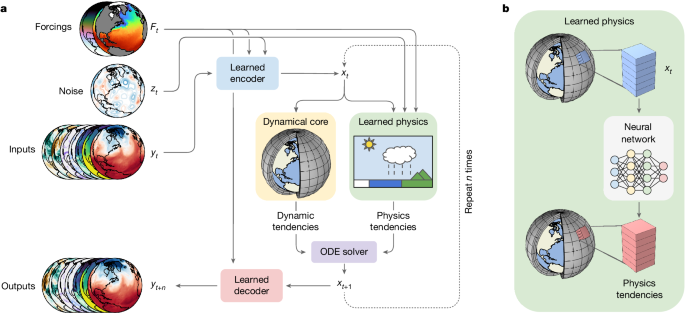
a , Overall model structure, showing how forcings F t , noise z t (for stochastic models) and inputs y t are encoded into the model state x t . The model state is fed into the dynamical core, and alongside forcings and noise into the learned physics module. This produces tendencies (rates of change) used by an implicit–explicit ordinary differential equation (ODE) solver to advance the state in time. The new model state x t +1 can then be fed back into another time step, or decoded into model predictions. b , The learned physics module, which feeds data for individual columns of the atmosphere into a neural network used to produce physics tendencies in that vertical column.
The differentiable dynamical core in NeuralGCM allows an end-to-end training approach, whereby we advance the model multiple time steps before employing stochastic gradient descent to minimize discrepancies between model predictions and reanalysis (Supplementary Information section G.2 ). We gradually increase the rollout length from 6 hours to 5 days (Supplementary Information section G and Supplementary Table 5 ), which we found to be critical because our models are not accurate for multi-day prediction or stable for long rollouts early in training (Supplementary Information section H.6.2 and Supplementary Fig. 23 ). The extended back-propagation through hundreds of simulation steps enables our neural networks to take into account interactions between the learned physics and the dynamical core. We train deterministic and stochastic NeuralGCM models, each of which uses a distinct training protocol, described in full detail in Methods and Supplementary Table 4 .
We train a range of NeuralGCM models at horizontal resolutions with grid spacing of 2.8°, 1.4° and 0.7° (Supplementary Fig. 7 ). We evaluate the performance of NeuralGCM at a range of timescales appropriate for weather forecasting and climate simulation. For weather, we compare against the best-in-class conventional physics-based weather models, ECMWF’s high-resolution model (ECMWF-HRES) and ensemble prediction system (ECMWF-ENS), and two of the recent machine-learning-based approaches, GraphCast 3 and Pangu 4 . For climate, we compare against a global cloud-resolving model and Atmospheric Model Intercomparison Project (AMIP) runs.
Medium-range weather forecasting
Our evaluation set-up focuses on quantifying accuracy and physical consistency, following WeatherBench2 12 . We regrid all forecasts to a 1.5° grid using conservative regridding, and average over all 732 forecasts made at noon and midnight UTC in the year 2020, which was held-out from training data for all machine-learning models. NeuralGCM, GraphCast and Pangu compare with ERA5 as the ground truth, whereas ECMWF-ENS and ECMWF-HRES compare with the ECMWF operational analysis (that is, HRES at 0-hour lead time), to avoid penalizing the operational forecasts for different biases than ERA5.
Model accuracy
We use ECMWF’s ensemble (ENS) model as a reference baseline as it achieves the best performance across the majority of lead times 12 . We assess accuracy using (1) root-mean-squared error (RMSE), (2) root-mean-squared bias (RMSB), (3) continuous ranked probability score (CRPS) and (4) spread-skill ratio, with the results shown in Fig. 2 . We provide more in-depth evaluations including scorecards, metrics for additional variables and levels and maps in Extended Data Figs. 1 and 2 , Supplementary Information section H and Supplementary Figs. 9 – 22 .
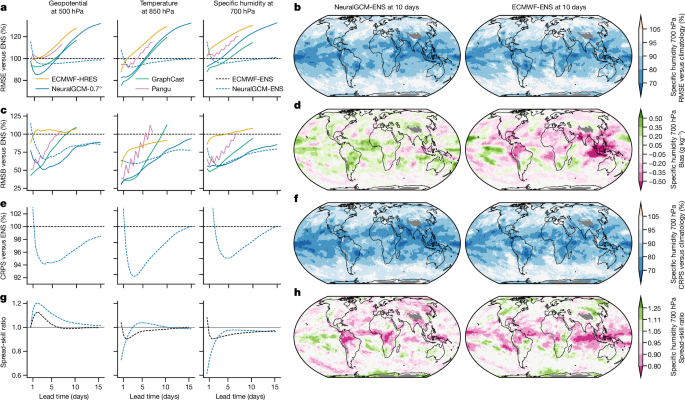
a , c , RMSE ( a ) and RMSB ( c ) for ECMWF-ENS, ECMWF-HRES, NeuralGCM-0.7°, NeuralGCM-ENS, GraphCast 3 and Pangu 4 on headline WeatherBench2 variables, as a percentage of the error of ECMWF-ENS. Deterministic and stochastic models are shown in solid and dashed lines respectively. e , g , CRPS relative to ECMWF-ENS ( e ) and spread-skill ratio for the ENS and NeuralGCM-ENS models ( g ). b , d , f , h , Spatial distributions of RMSE ( b ), bias ( d ), CRPS ( f ) and spread-skill ratio ( h ) for NeuralGCM-ENS and ECMWF-ENS models for 10-day forecasts of specific humidity at 700 hPa. Spatial plots of RMSE and CRPS show skill relative to a probabilistic climatology 12 with an ensemble member for each of the years 1990–2019. The grey areas indicate regions where climatological surface pressure on average is below 700 hPa.
Deterministic models that produce a single weather forecast for given initial conditions can be compared effectively using RMSE skill at short lead times. For the first 1–3 days, depending on the atmospheric variable, RMSE is minimized by forecasts that accurately track the evolution of weather patterns. At this timescale we find that NeuralGCM-0.7° and GraphCast achieve best results, with slight variations across different variables (Fig. 2a ). At longer lead times, RMSE rapidly increases owing to chaotic divergence of nearby weather trajectories, making RMSE less informative for deterministic models. RMSB calculates persistent errors over time, which provides an indication of how models would perform at much longer lead times. Here NeuralGCM models also compare favourably against previous approaches (Fig. 2c ), with notably much less bias for specific humidity in the tropics (Fig. 2d ).
Ensembles are essential for capturing intrinsic uncertainty of weather forecasts, especially at longer lead times. Beyond about 7 days, the ensemble means of ECMWF-ENS and NeuralGCM-ENS forecasts have considerably lower RMSE than the deterministic models, indicating that these models better capture the average of possible weather. A better metric for ensemble models is CRPS, which is a proper scoring rule that is sensitive to full marginal probability distributions 28 . Our stochastic model (NeuralGCM-ENS) running at 1.4° resolution has lower error compared with ECMWF-ENS across almost all variables, lead times and vertical levels for ensemble-mean RMSE, RSMB and CRPS (Fig. 2a,c,e and Supplementary Information section H ), with similar spatial patterns of skill (Fig. 2b,f ). Like ECMWF-ENS, NeuralGCM-ENS has a spread-skill ratio of approximately one (Fig. 2d ), which is a necessary condition for calibrated forecasts 29 .
An important characteristic of forecasts is their resemblance to realistic weather patterns. Figure 3 shows a case study that illustrates the performance of NeuralGCM on three types of important weather phenomenon: tropical cyclones, atmospheric rivers and the Intertropical Convergence Zone. Figure 3a shows that all the machine-learning models make significantly blurrier forecasts than the source data ERA5 and physics-based ECMWF-HRES forecast, but NeuralCGM-0.7° outperforms the pure machine-learning models, despite its coarser resolution (0.7° versus 0.25° for GraphCast and Pangu). Blurry forecasts correspond to physically inconsistent atmospheric conditions and misrepresent extreme weather. Similar trends hold for other derived variables of meteorological interest (Supplementary Information section H.2 ). Ensemble-mean predictions, from both NeuralGCM and ECMWF, are closer to ERA5 in an average sense, and thus are inherently smooth at long lead times. In contrast, as shown in Fig. 3 and in Supplementary Information section H.3 , individual realizations from the ECMWF and NeuralGCM ensembles remain sharp, even at long lead times. Like ECMWF-ENS, NeuralGCM-ENS produces a statistically representative range of future weather scenarios for each weather phenomenon, despite its eight-times-coarser resolution.
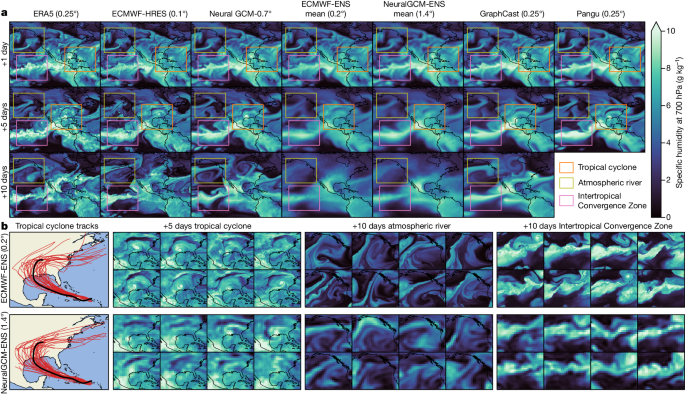
All forecasts are initialized at 2020-08-22T12z, chosen to highlight Hurricane Laura, the most damaging Atlantic hurricane of 2020. a , Specific humidity at 700 hPa for 1-day, 5-day and 10-day forecasts over North America and the Northeast Pacific Ocean from ERA5 14 , ECMWF-HRES, NeuralGCM-0.7°, ECMWF-ENS (mean), NeuralGCM-ENS (mean), GraphCast 3 and Pangu 4 . b , Forecasts from individual ensemble members from ECMWF-ENS and NeuralGCM-ENS over regions of interest, including predicted tracks of Hurricane Laura from each of the 50 ensemble members (Supplementary Information section I.2 ). The track from ERA5 is plotted in black.
We can quantify the blurriness of different forecast models via their power spectra. Supplementary Figs. 17 and 18 show that the power spectra of NeuralCGM-0.7° is consistently closer to ERA5 than the other machine-learning forecast methods, but is still blurrier than ECMWF’s physical forecasts. The spectra of NeuralGCM forecasts is also roughly constant over the forecast period, in stark contrast to GraphCast, which worsens with lead time. The spectrum of NeuralGCM becomes more accurate with increased resolution (Supplementary Fig. 22 ), which suggests the potential for further improvements of NeuralGCM models trained at higher resolutions.
Water budget
In NeuralGCM, advection is handled by the dynamical core, while the machine-learning parameterization models local processes within vertical columns of the atmosphere. Thus, unlike pure machine-learning methods, local sources and sinks can be isolated from tendencies owing to horizontal transport and other resolved dynamics (Supplementary Fig. 3 ). This makes our results more interpretable and facilitates the diagnosis of the water budget. Specifically, we diagnose precipitation minus evaporation (Supplementary Information section H.5 ) rather than directly predicting these as in machine-learning-based approaches 3 . For short weather forecasts, the mean of precipitation minus evaporation has a realistic spatial distribution that is very close to ERA5 data (Extended Data Fig. 4c–e ). The precipitation-minus-evaporation rate distribution of NeuralGCM-0.7° closely matches the ERA5 distribution in the extratropics (Extended Data Fig. 4b ), although it underestimates extreme events in the tropics (Extended Data Fig. 4a ). It is noted that the current version of NeuralGCM directly predicts tendencies for an atmospheric column, and thus cannot distinguish between precipitation and evaporation.
Geostrophic wind balance
We examined the extent to which NeuralGCM, GraphCast and ECMWF-HRES capture the geostrophic wind balance, the near-equilibrium between the dominant forces that drive large-scale dynamics in the mid-latitudes 30 . A recent study 16 highlighted that Pangu misrepresents the vertical structure of the geostrophic and ageostrophic winds and noted a deterioration at longer lead times. Similarly, we observe that GraphCast shows an error that worsens with lead time. In contrast, NeuralGCM more accurately depicts the vertical structure of the geostrophic and ageostrophic winds, as well as their ratio, compared with GraphCast across various rollouts, when compared against ERA5 data (Extended Data Fig. 3 ). However, ECMWF-HRES still shows a slightly closer alignment to ERA5 data than NeuralGCM does. Within NeuralGCM, the representation of the geostrophic wind’s vertical structure only slightly degrades in the initial few days, showing no noticeable changes thereafter, particularly beyond day 5.
Generalizing to unseen data
Physically consistent weather models should still perform well for weather conditions for which they were not trained. We expect that NeuralGCM may generalize better than machine-learning-only atmospheric models, because NeuralGCM employs neural networks that act locally in space, on individual vertical columns of the atmosphere. To explore this hypothesis, we compare versions of NeuralCGM-0.7° and GraphCast trained to 2017 on 5 years of weather forecasts beyond the training period (2018–2022) in Supplementary Fig. 36 . Unlike GraphCast, NeuralGCM does not show a clear trend of increasing error when initialized further into the future from the training data. To extend this test beyond 5 years, we trained a NeuralGCM-2.8° model using only data before 2000, and tested its skill for over 21 unseen years (Supplementary Fig. 35 ).
Climate simulations
Although our deterministic NeuralGCM models are trained to predict weather up to 3 days ahead, they are generally capable of simulating the atmosphere far beyond medium-range weather timescales. For extended climate simulations, we prescribe historical sea surface temperature (SST) and sea-ice concentration. These simulations feature many emergent phenomena of the atmosphere on timescales from months to decades.
For climate simulations with NeuralGCM, we use 2.8° and 1.4° deterministic models, which are relatively inexpensive to train (Supplementary Information section G.7 ) and allow us to explore a larger parameter space to find stable models. Previous studies found that running extended simulations with hybrid models is challenging due to numerical instabilities and climate drift 21 . To quantify stability in our selected models, we run multiple initial conditions and report how many of them finish without instability.
Seasonal cycle and emergent phenomena
To assess the capability of NeuralGCM to simulate various aspects of the seasonal cycle, we run 2-year simulations with NeuralGCM-1.4°. for 37 different initial conditions spaced every 10 days for the year 2019. Out of these 37 initial conditions, 35 successfully complete the full 2 years without instability; for case studies of instability, see Supplementary Information section H.7 , and Supplementary Figs. 26 and 27 . We compare results from NeuralGCM-1.4° for 2020 with ERA5 data and with outputs from the X-SHiELD global cloud-resolving model, which is coupled to an ocean model nudged towards reanalysis 31 . This X-SHiELD run has been used as a target for training machine-learning climate models 24 . For comparison, we evaluate models after regridding predictions to 1.4° resolution. This comparison slightly favours NeuralGCM because NeuralGCM was tuned to match ERA5, but the discrepancy between ERA5 and the actual atmosphere is small relative to model error.
Figure 4a shows the temporal variation of the global mean temperature to 2020, as captured by 35 simulations from NeuralGCM, in comparison with the ERA5 reanalysis and standard climatology benchmarks. The seasonality and variability of the global mean temperature from NeuralGCM are quantitatively similar to those observed in ERA5. The ensemble-mean temperature RMSE for NeuralGCM stands at 0.16 K when benchmarked against ERA5, which is a significant improvement over the climatology’s RMSE of 0.45 K. We find that NeuralGCM accurately simulates the seasonal cycle, as evidenced by metrics such as the annual cycle of the global precipitable water (Supplementary Fig. 30a ) and global total kinetic energy (Supplementary Fig. 30b ). Furthermore, the model captures essential atmospheric dynamics, including the Hadley circulation and the zonal-mean zonal wind (Supplementary Fig. 28 ), as well as the spatial patterns of eddy kinetic energy in different seasons (Supplementary Fig. 31 ), and the distinctive seasonal behaviours of monsoon circulation (Supplementary Fig. 29 ; additional details are provided in Supplementary Information section I.1 ).
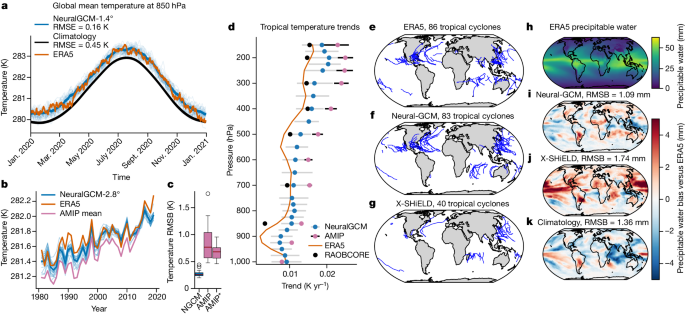
a , Global mean temperature for ERA5 14 (orange), 1990–2019 climatology (black) and NeuralGCM-1.4° (blue) for 2020 using 35 simulations initialized every 10 days during 2019 (thick line, ensemble mean; thin lines, different initial conditions). b , Yearly global mean temperature for ERA5 (orange), mean over 22 CMIP6 AMIP experiments 34 (violet; model details are in Supplementary Information section I.3 ) and NeuralGCM-2.8° for 22 AMIP-like simulations with prescribed SST initialized every 10 days during 1980 (thick line, ensemble mean; thin lines, different initial conditions). c , The RMSB of the 850-hPa temperature averaged between 1981 and 2014 for 22 NeuralGCM-2.8° AMIP runs (labelled NGCM), 22 CMIP6 AMIP experiments (labelled AMIP) and debiased 22 CMIP6 AMIP experiments (labelled AMIP*; bias was removed by removing the 850-hPa global temperature bias). In the box plots, the red line represents the median. The box delineates the first to third quartiles; the whiskers extend to 1.5 times the interquartile range (Q1 − 1.5IQR and Q3 + 1.5IQR), and outliers are shown as individual dots. d , Vertical profiles of tropical (20° S–20° N) temperature trends for 1981–2014. Orange, ERA5; black dots, Radiosonde Observation Correction using Reanalyses (RAOBCORE) 41 ; blue dots, mean trends for NeuralGCM; purple dots, mean trends from CMIP6 AMIP runs (grey and black whiskers, 25th and 75th percentiles for NeuralGCM and CMIP6 AMIP runs, respectively). e – g , Tropical cyclone tracks for ERA5 ( e ), NeuralGCM-1.4° ( f ) and X-SHiELD 31 ( g ). h – k , Mean precipitable water for ERA5 ( h ) and the precipitable water bias in NeuralGCM-1.4° ( i ), initialized 90 days before mid-January 2020 similarly to X-SHiELD, X-SHiELD ( j ) and climatology ( k ; averaged between 1990 and 2019). In d – i , quantities are calculated between mid-January 2020 and mid-January 2021 and all models were regridded to a 256 × 128 Gaussian grid before computation and tracking.
Next, we compare the annual biases of a single NeuralGCM realization with a single realization of X-SHiELD (the only one available), both initiated in mid-October 2019. We consider 19 January 2020 to 17 January 2021, the time frame for which X-SHiELD data are available. Global cloud-resolving models, such as X-SHiELD, are considered state of the art, especially for simulating the hydrological cycle, owing to their resolution being capable of resolving deep convection 32 . The annual bias in precipitable water for NeuralGCM (RMSE of 1.09 mm) is substantially smaller than the biases of both X-SHiELD (RMSE of 1.74 mm) and climatology (RMSE of 1.36 mm; Fig. 4i–k ). Moreover, NeuralGCM shows a lower temperature bias in the upper and lower troposphere than X-SHiELD (Extended Data Fig. 6 ). We also indirectly compare precipitation bias in X-SHiELD with precipitation-minus-evaporation bias in NeuralGCM-1.4°, which shows slightly larger bias and grid-scale artefacts for NeuralGCM (Extended Data Fig. 5 ).
Finally, to assess the capability of NeuralGCM to generate tropical cyclones in an annual model integration, we use the tropical cyclone tracker TempestExtremes 33 , as described in Supplementary Information section I.2 , Supplementary Fig. 34 and Supplementary Table 6 . Figure 4e–g shows that NeuralGCM, even at a coarse resolution of 1.4°, produces realistic trajectories and counts of tropical cyclone (83 versus 86 in ERA5 for the corresponding period), whereas X-SHiELD, when regridded to 1.4° resolution, substantially underestimates the tropical cyclone count (40). Additional statistical analyses of tropical cyclones can be found in Extended Data Figs. 7 and 8 .
Decadal simulations
To assess the capability of NeuralGCM to simulate historical temperature trends, we conduct AMIP-like simulations over a duration of 40 years with NeuralGCM-2.8°. Out of 37 different runs with initial conditions spaced every 10 days during the year 1980, 22 simulations were stable for the entire 40-year period, and our analysis focuses on these results. We compare with 22 simulations run with prescribed SST from the Coupled Model Intercomparison Project Phase 6 (CMIP6) 34 , listed in Supplementary Information section I.3 .
We find that all 40-year simulations of NeuralGCM, as well as the mean of the 22 AMIP runs, accurately capture the global warming trends observed in ERA5 data (Fig. 4b ). There is a strong correlation in the year-to-year temperature trends with ERA5 data, suggesting that NeuralGCM effectively captures the impact of SST forcing on climate. When comparing spatial biases averaged over 1981–2014, we find that all 22 NeuralGCM-2.8° runs have smaller bias than the CMIP6 AMIP runs, and this result remains even when removing the global temperature bias in CMIP6 AMIP runs (Fig. 4c and Supplementary Figs. 32 and 33 ).
Next, we investigated the vertical structure of tropical warming trends, which climate models tend to overestimate in the upper troposphere 35 . As shown in Fig. 4d , the trends, calculated by linear regression, of NeuralGCM are closer to ERA5 than those of AMIP runs. In particular, the bias in the upper troposphere is reduced. However, NeuralGCM does show a wider spread in its predictions than the AMIP runs, even at levels near the surface where temperatures are typically more constrained by prescribed SST.
Lastly, we evaluated NeuralGCM’s capability to generalize to unseen warmer climates by conducting AMIP simulations with increased SST (Supplementary Information section I.4.2 ). We find that NeuralGCM shows some of the robust features of climate warming response to modest SST increases (+1 K and +2 K); however, for more substantial SST increases (+4 K), NeuralGCM’s response diverges from expectations (Supplementary Fig. 37 ). In addition, AMIP simulations with increased SST show climate drift, underscoring NeuralGCM’s limitations in this context (Supplementary Fig. 38 ).
NeuralGCM is a differentiable hybrid atmospheric model that combines the strengths of traditional GCMs with machine learning for weather forecasting and climate simulation. To our knowledge, NeuralGCM is the first machine-learning-based model to make accurate ensemble weather forecasts, with better CRPS than state-of-the-art physics-based models. It is also, to our knowledge, the first hybrid model that achieves comparable spatial bias to global cloud-resolving models, can simulate realistic tropical cyclone tracks and can run AMIP-like simulations with realistic historical temperature trends. Overall, NeuralGCM demonstrates that incorporating machine learning is a viable alternative to building increasingly detailed physical models 32 for improving GCMs.
Compared with traditional GCMs with similar skill, NeuralGCM is computationally efficient and low complexity. NeuralGCM runs at 8- to 40-times-coarser horizontal resolution than ECMWF’s Integrated Forecasting System and global cloud-resolving models, which enables 3 to 5 orders of magnitude savings in computational resources. For example, NeuralGCM-1.4° simulates 70,000 simulation days in 24 hours using a single tensor-processing-unit versus 19 simulated days on 13,824 central-processing-unit cores with X-SHiELD (Extended Data Table 1 ). This can be leveraged for previously impractical tasks such as large ensemble forecasting. NeuralGCM’s dynamical core uses global spectral methods 36 , and learned physics is parameterized with fully connected neural networks acting on single vertical columns. Substantial headroom exists to pursue higher accuracy using advanced numerical methods and machine-learning architectures.
Our results provide strong evidence for the disputed hypothesis 37 , 38 , 39 that learning to predict short-term weather is an effective way to tune parameterizations for climate. NeuralGCM models trained on 72-hour forecasts are capable of realistic multi-year simulation. When provided with historical SSTs, they capture essential atmospheric dynamics such as seasonal circulation, monsoons and tropical cyclones. However, we will probably need alternative training strategies 38 , 39 to learn important processes for climate with subtle impacts on weather timescales, such as a cloud feedback.
The NeuralGCM approach is compatible with incorporating either more physics or more machine learning, as required for operational weather forecasts and climate simulations. For weather forecasting, we expect that end-to-end learning 40 with observational data will allow for better and more relevant predictions, including key variables such as precipitation. Such models could include neural networks acting as corrections to traditional data assimilation and model diagnostics. For climate projection, NeuralGCM will need to be reformulated to enable coupling with other Earth-system components (for example, ocean and land), and integrating data on the atmospheric chemical composition (for example, greenhouse gases and aerosols). There are also research challenges common to current machine-learning-based climate models 19 , including the capability to simulate unprecedented climates (that is, generalization), adhering to physical constraints, and resolving numerical instabilities and climate drift. NeuralGCM’s flexibility to incorporate physics-based models (for example, radiation) offers a promising avenue to address these challenges.
Models based on physical laws and empirical relationships are ubiquitous in science. We believe the differentiable hybrid modelling approach of NeuralGCM has the potential to transform simulation for a wide range of applications, such as materials discovery, protein folding and multiphysics engineering design.
Differentiable atmospheric model
NeuralGCM combines components of the numerical solver and flexible neural network parameterizations. Simulation in time is carried out in a coordinate system suitable for solving the dynamical equations of the atmosphere, describing large-scale fluid motion and thermodynamics under the influence of gravity and the Coriolis force.
Our differentiable dynamical core is implemented in JAX, a library for high-performance code in Python that supports automatic differentiation 42 . The dynamical core solves the hydrostatic primitive equations with moisture, using a horizontal pseudo-spectral discretization and vertical sigma coordinates 36 , 43 . We evolve seven prognostic variables: vorticity and divergence of horizontal wind, temperature, surface pressure, and three water species (specific humidity, and specific ice and liquid cloud water content).
Our learned physics module uses the single-column approach of GCMs 2 , whereby information from only a single atmospheric column is used to predict the impact of unresolved processes occurring within that column. These effects are predicted using a fully connected neural network with residual connections, with weights shared across all atmospheric columns (Supplementary Information section C.4 ).
The inputs to the neural network include the prognostic variables in the atmospheric column, total incident solar radiation, sea-ice concentration and SST (Supplementary Information section C.1 ). We also provide horizontal gradients of the prognostic variables, which we found improves performance 44 . All inputs are standardized to have zero mean and unit variance using statistics precomputed during model initialization. The outputs are the prognostic variable tendencies scaled by the fixed unconditional standard deviation of the target field (Supplementary Information section C.5 ).
To interface between ERA5 14 data stored in pressure coordinates and the sigma coordinate system of our dynamical core, we introduce encoder and decoder components (Supplementary Information section D ). These components perform linear interpolation between pressure levels and sigma coordinate levels. We additionally introduce learned corrections to both encoder and decoder steps (Supplementary Figs. 4–6 ), using the same column-based neural network architecture as the learned physics module. Importantly, the encoder enables us to eliminate the gravity waves from initialization shock 45 , which otherwise contaminate forecasts.
Figure 1a shows the sequence of steps that NeuralGCM takes to make a forecast. First, it encodes ERA5 data at t = t 0 on pressure levels to initial conditions on sigma coordinates. To perform a time step, the dynamical core and learned physics (Fig. 1b ) then compute tendencies, which are integrated in time using an implicit–explicit ordinary differential equation solver 46 (Supplementary Information section E and Supplementary Table 2 ). This is repeated to advance the model from t = t 0 to t = t final . Finally, the decoder converts predictions back to pressure levels.
The time-step size of the ODE solver (Supplementary Table 3 ) is limited by the Courant–Friedrichs–Lewy condition on dynamics, and can be small relative to the timescale of atmospheric change. Evaluating learned physics is approximately 1.5 times as expensive as a time step of the dynamical core. Accordingly, following the typical practice for GCMs, we hold learned physics tendencies constant for multiple ODE time steps to reduce computational expense, typically corresponding to 30 minutes of simulation time.
Deterministic and stochastic models
We train deterministic NeuralGCM models using a combination of three loss functions (Supplementary Information section G.4 ) to encourage accuracy and sharpness while penalizing bias. During the main training phase, all losses are defined in a spherical harmonics basis. We use a standard mean squared error loss for prompting accuracy, modified to progressively filter out contributions from higher total wavenumbers at longer lead times (Supplementary Fig. 8 ). This filtering approach tackles the ‘double penalty problem’ 47 as it prevents the model from being penalized for predicting high-wavenumber features in incorrect locations at later times, especially beyond the predictability horizon. A second loss term encourages the spectrum to match the training data using squared loss on the total wavenumber spectrum of prognostic variables. These first two losses are evaluated on both sigma and pressure levels. Finally, a third loss term discourages bias by adding mean squared error on the batch-averaged mean amplitude of each spherical harmonic coefficient. For analysis of the impact that various loss functions have, refer to Supplementary Information section H.6.1 , and Supplementary Figs. 23 and 24 . The combined action of the three training losses allow the resulting models trained on 3-day rollouts to remain stable during years-to-decades-long climate simulations. Before final evaluations, we perform additional fine-tuning of just the decoder component on short rollouts of 24 hours (Supplementary Information section G.5 ).
Stochastic NeuralGCM models incorporate inherent randomness in the form of additional random fields passed as inputs to neural network components. Our stochastic loss is based on the CRPS 28 , 48 , 49 . CRPS consists of mean absolute error that encourages accuracy, balanced by a similar term that encourages ensemble spread. For each variable we use a sum of CRPS in grid space and CRPS in the spherical harmonic basis below a maximum cut-off wavenumber (Supplementary Information section G.6 ). We compute CRPS on rollout lengths from 6 hours to 5 days. As illustrated in Fig. 1 , we inject noise to the learned encoder and the learned physics module by sampling from Gaussian random fields with learned spatial and temporal correlation (Supplementary Information section C.2 and Supplementary Fig. 2 ). For training, we generate two ensemble members per forecast, which suffices for an unbiased estimate of CRPS.
Data availability
For training and evaluating the NeuralGCM models, we used the publicly available ERA5 dataset 14 , originally downloaded from https://cds.climate.copernicus.eu/ and available via Google Cloud Storage in Zarr format at gs://gcp-public-data-arco-era5/ar/full_37-1h-0p25deg-chunk-1.zarr-v3. To compare NeuralGCM with operational and data-driven weather models, we used forecast datasets distributed as part of WeatherBench2 12 at https://weatherbench2.readthedocs.io/en/latest/data-guide.html , to which we have added NeuralGCM forecasts for 2020. To compare NeuralGCM with atmospheric models in climate settings, we used CMIP6 data available at https://catalog.pangeo.io/browse/master/climate/ , as well as X-SHiELD 24 outputs available on Google Cloud storage in a ‘requester pays’ bucket at gs://ai2cm-public-requester-pays/C3072-to-C384-res-diagnostics. The Radiosonde Observation Correction using Reanalyses (RAOBCORE) V1.9 that was used as reference tropical temperature trends was downloaded from https://webdata.wolke.img.univie.ac.at/haimberger/v1.9/ . Base maps use freely available data from https://www.naturalearthdata.com/downloads/ .
Code availability
The NeuralGCM code base is separated into two open source projects: Dinosaur and NeuralGCM, both publicly available on GitHub at https://github.com/google-research/dinosaur (ref. 50 ) and https://github.com/google-research/neuralgcm (ref. 51 ). The Dinosaur package implements a differentiable dynamical core used by NeuralGCM, whereas the NeuralGCM package provides machine-learning models and checkpoints of trained models. Evaluation code for NeuralGCM weather forecasts is included in WeatherBench2 12 , available at https://github.com/google-research/weatherbench2 (ref. 52 ).
Bauer, P., Thorpe, A. & Brunet, G. The quiet revolution of numerical weather prediction. Nature 525 , 47–55 (2015).
Article ADS CAS PubMed Google Scholar
Balaji, V. et al. Are general circulation models obsolete? Proc. Natl Acad. Sci. USA 119 , e2202075119 (2022).
Article CAS PubMed PubMed Central Google Scholar
Lam, R. et al. Learning skillful medium-range global weather forecasting. Science 382 , 1416–1421 (2023).
Article ADS MathSciNet CAS PubMed Google Scholar
Bi, K. et al. Accurate medium-range global weather forecasting with 3D neural networks. Nature 619 , 533–538 (2023).
Article ADS CAS PubMed PubMed Central Google Scholar
Hourdin, F. et al. The art and science of climate model tuning. Bull. Am. Meteorol. Soc. 98 , 589–602 (2017).
Article ADS Google Scholar
Bony, S. & Dufresne, J.-L. Marine boundary layer clouds at the heart of tropical cloud feedback uncertainties in climate models. Geophys. Res. Lett. 32 , L20806 (2005).
Webb, M. J., Lambert, F. H. & Gregory, J. M. Origins of differences in climate sensitivity, forcing and feedback in climate models. Clim. Dyn. 40 , 677–707 (2013).
Article Google Scholar
Sherwood, S. C., Bony, S. & Dufresne, J.-L. Spread in model climate sensitivity traced to atmospheric convective mixing. Nature 505 , 37–42 (2014).
Article ADS PubMed Google Scholar
Palmer, T. & Stevens, B. The scientific challenge of understanding and estimating climate change. Proc. Natl Acad. Sci. USA 116 , 24390–24395 (2019).
Fischer, E. M., Beyerle, U. & Knutti, R. Robust spatially aggregated projections of climate extremes. Nat. Clim. Change 3 , 1033–1038 (2013).
Field, C. B. Managing the Risks of Extreme Events and Disasters to Advance Climate Change Adaptation: Special Report of the Intergovernmental Panel on Climate Change (Cambridge Univ. Press, 2012).
Rasp, S. et al. WeatherBench 2: A benchmark for the next generation of data-driven global weather models. J. Adv. Model. Earth Syst. 16 , e2023MS004019 (2024).
Keisler, R. Forecasting global weather with graph neural networks. Preprint at https://arxiv.org/abs/2202.07575 (2022).
Hersbach, H. et al. The ERA5 global reanalysis. Q. J. R. Meteorol. Soc. 146 , 1999–2049 (2020).
Zhou, L. et al. Toward convective-scale prediction within the next generation global prediction system. Bull. Am. Meteorol. Soc. 100 , 1225–1243 (2019).
Bonavita, M. On some limitations of current machine learning weather prediction models. Geophys. Res. Lett. 51 , e2023GL107377 (2024).
Weyn, J. A., Durran, D. R. & Caruana, R. Improving data-driven global weather prediction using deep convolutional neural networks on a cubed sphere. J. Adv. Model. Earth Syst. 12 , e2020MS002109 (2020).
Watt-Meyer, O. et al. ACE: a fast, skillful learned global atmospheric model for climate prediction. Preprint at https://arxiv.org/abs/2310.02074 (2023).
Bretherton, C. S. Old dog, new trick: reservoir computing advances machine learning for climate modeling. Geophys. Res. Lett. 50 , e2023GL104174 (2023).
Reichstein, M. et al. Deep learning and process understanding for data-driven Earth system science. Nature 566 , 195–204 (2019).
Brenowitz, N. D. & Bretherton, C. S. Spatially extended tests of a neural network parametrization trained by coarse-graining. J. Adv. Model. Earth Syst. 11 , 2728–2744 (2019).
Rasp, S., Pritchard, M. S. & Gentine, P. Deep learning to represent subgrid processes in climate models. Proc. Natl Acad. Sci. USA 115 , 9684–9689 (2018).
Yuval, J. & O’Gorman, P. A. Stable machine-learning parameterization of subgrid processes for climate modeling at a range of resolutions. Nat. Commun. 11 , 3295 (2020).
Kwa, A. et al. Machine-learned climate model corrections from a global storm-resolving model: performance across the annual cycle. J. Adv. Model. Earth Syst. 15 , e2022MS003400 (2023).
Arcomano, T., Szunyogh, I., Wikner, A., Hunt, B. R. & Ott, E. A hybrid atmospheric model incorporating machine learning can capture dynamical processes not captured by its physics-based component. Geophys. Res. Lett. 50 , e2022GL102649 (2023).
Han, Y., Zhang, G. J. & Wang, Y. An ensemble of neural networks for moist physics processes, its generalizability and stable integration. J. Adv. Model. Earth Syst. 15 , e2022MS003508 (2023).
Gelbrecht, M., White, A., Bathiany, S. & Boers, N. Differentiable programming for Earth system modeling. Geosci. Model Dev. 16 , 3123–3135 (2023).
Gneiting, T. & Raftery, A. E. Strictly proper scoring rules, prediction, and estimation. J. Am. Stat. Assoc. 102 , 359–378 (2007).
Article MathSciNet CAS Google Scholar
Fortin, V., Abaza, M., Anctil, F. & Turcotte, R. Why should ensemble spread match the RMSE of the ensemble mean? J. Hydrometeorol. 15 , 1708–1713 (2014).
Holton, J. R. An introduction to Dynamic Meteorology 5th edn (Elsevier, 2004).
Cheng, K.-Y. et al. Impact of warmer sea surface temperature on the global pattern of intense convection: insights from a global storm resolving model. Geophys. Res. Lett. 49 , e2022GL099796 (2022).
Stevens, B. et al. DYAMOND: the dynamics of the atmospheric general circulation modeled on non-hydrostatic domains. Prog. Earth Planet. Sci. 6 , 61 (2019).
Ullrich, P. A. et al. TempestExtremes v2.1: a community framework for feature detection, tracking, and analysis in large datasets. Geosc. Model Dev. 14 , 5023–5048 (2021).
Eyring, V. et al. Overview of the Coupled Model Intercomparison Project Phase 6 (CMIP6) experimental design and organization. Geosci. Model Dev. 9 , 1937–1958 (2016).
Mitchell, D. M., Lo, Y. E., Seviour, W. J., Haimberger, L. & Polvani, L. M. The vertical profile of recent tropical temperature trends: persistent model biases in the context of internal variability. Environ. Res. Lett. 15 , 1040b4 (2020).
Bourke, W. A multi-level spectral model. I. Formulation and hemispheric integrations. Mon. Weather Rev. 102 , 687–701 (1974).
Ruiz, J. J., Pulido, M. & Miyoshi, T. Estimating model parameters with ensemble-based data assimilation: a review. J. Meteorol. Soc. Jpn Ser. II 91 , 79–99 (2013).
Schneider, T., Lan, S., Stuart, A. & Teixeira, J. Earth system modeling 2.0: a blueprint for models that learn from observations and targeted high-resolution simulations. Geophys. Res. Lett. 44 , 12–396 (2017).
Schneider, T., Leung, L. R. & Wills, R. C. J. Opinion: Optimizing climate models with process knowledge, resolution, and artificial intelligence. Atmos. Chem. Phys. 24 , 7041–7062 (2024).
Sutskever, I., Vinyals, O. & Le, Q. V. Sequence to sequence learning with neural networks. Adv. Neural Inf. Process. Syst. 27 , 3104–3112 (2014).
Haimberger, L., Tavolato, C. & Sperka, S. Toward elimination of the warm bias in historic radiosonde temperature records—some new results from a comprehensive intercomparison of upper-air data. J. Clim. 21 , 4587–4606 (2008).
Bradbury, J. et al. JAX: composable transformations of Python+NumPy programs. GitHub http://github.com/google/jax (2018).
Durran, D. R. Numerical Methods for Fluid Dynamics: With Applications to Geophysics Vol. 32, 2nd edn (Springer, 2010).
Wang, P., Yuval, J. & O’Gorman, P. A. Non-local parameterization of atmospheric subgrid processes with neural networks. J. Adv. Model. Earth Syst. 14 , e2022MS002984 (2022).
Daley, R. Normal mode initialization. Rev. Geophys. 19 , 450–468 (1981).
Whitaker, J. S. & Kar, S. K. Implicit–explicit Runge–Kutta methods for fast–slow wave problems. Mon. Weather Rev. 141 , 3426–3434 (2013).
Gilleland, E., Ahijevych, D., Brown, B. G., Casati, B. & Ebert, E. E. Intercomparison of spatial forecast verification methods. Weather Forecast. 24 , 1416–1430 (2009).
Rasp, S. & Lerch, S. Neural networks for postprocessing ensemble weather forecasts. Month. Weather Rev. 146 , 3885–3900 (2018).
Pacchiardi, L., Adewoyin, R., Dueben, P. & Dutta, R. Probabilistic forecasting with generative networks via scoring rule minimization. J. Mach. Learn. Res. 25 , 1–64 (2024).
Smith, J. A., Kochkov, D., Norgaard, P., Yuval, J. & Hoyer, S. google-research/dinosaur: 1.0.0. Zenodo https://doi.org/10.5281/zenodo.11376145 (2024).
Kochkov, D. et al. google-research/neuralgcm: 1.0.0. Zenodo https://doi.org/10.5281/zenodo.11376143 (2024).
Rasp, S. et al. google-research/weatherbench2: v0.2.0. Zenodo https://doi.org/10.5281/zenodo.11376271 (2023).
Download references
Acknowledgements
We thank A. Kwa, A. Merose and K. Shah for assistance with data acquisition and handling; L. Zepeda-Núñez for feedback on the paper; and J. Anderson, C. Van Arsdale, R. Chemke, G. Dresdner, J. Gilmer, J. Hickey, N. Lutsko, G. Nearing, A. Paszke, J. Platt, S. Ponda, M. Pritchard, D. Rothenberg, F. Sha, T. Schneider and O. Voicu for discussions.
Author information
These authors contributed equally: Dmitrii Kochkov, Janni Yuval, Ian Langmore, Peter Norgaard, Jamie Smith, Stephan Hoyer
Authors and Affiliations
Google Research, Mountain View, CA, USA
Dmitrii Kochkov, Janni Yuval, Ian Langmore, Peter Norgaard, Jamie Smith, Griffin Mooers, James Lottes, Stephan Rasp, Michael P. Brenner & Stephan Hoyer
Earth, Atmospheric and Planetary Sciences, Massachusetts Institute of Technology, Cambridge, MA, USA
Milan Klöwer
European Centre for Medium-Range Weather Forecasts, Reading, UK
Peter Düben & Sam Hatfield
Google DeepMind, London, UK
Peter Battaglia, Alvaro Sanchez-Gonzalez & Matthew Willson
School of Engineering and Applied Sciences, Harvard University, Cambridge, MA, USA
Michael P. Brenner
You can also search for this author in PubMed Google Scholar
Contributions
D.K., J.Y., I.L., P.N., J.S. and S. Hoyer contributed equally to this work. D.K., J.Y., I.L., P.N., J.S., G.M., J.L. and S. Hoyer wrote the code. D.K., J.Y., I.L., P.N., G.M. and S. Hoyer trained models and analysed the data. M.P.B. and S. Hoyer managed and oversaw the research project. M.K., S.R., P.D., S. Hatfield, P.B. and M.P.B. contributed technical advice and ideas. M.W. ran experiments with GraphCast for comparison with NeuralGCM. A.S.-G. assisted with data preparation. D.K., J.Y., I.L., P.N. and S. Hoyer wrote the paper. All authors gave feedback and contributed to editing the paper.
Corresponding authors
Correspondence to Dmitrii Kochkov , Janni Yuval or Stephan Hoyer .
Ethics declarations
Competing interests.
D.K., J.Y., I.L., P.N., J.S., J.L., S.R., P.B., A.S.-G., M.W., M.P.B. and S. Hoyer are employees of Google. S. Hoyer, D.K., I.L., J.Y., G.M., P.N., J.S. and M.B. have filed international patent application PCT/US2023/035420 in the name of Google LLC, currently pending, relating to neural general circulation models.
Peer review
Peer review information.
Nature thanks Karthik Kashinath and the other, anonymous, reviewer(s) for their contribution to the peer review of this work. Peer reviewer reports are available.
Additional information
Publisher’s note Springer Nature remains neutral with regard to jurisdictional claims in published maps and institutional affiliations.
Extended data figures and tables
Extended data fig. 1 maps of bias for neuralgcm-ens and ecmwf-ens forecasts..
Bias is averaged over all forecasts initialized in 2020.
Extended Data Fig. 2 Maps of spread-skill ratio for NeuralGCM-ENS and ECMWF-ENS forecasts.
Spread-skill ratio is averaged over all forecasts initialized in 2020.
Extended Data Fig. 3 Geostrophic balance in NeuralGCM, GraphCast 3 and ECMWF-HRES.
Vertical profiles of the extratropical intensity (averaged between latitude 30°–70° in both hemispheres) and over all forecasts initialized in 2020 of (a,d,g) geostrophic wind, (b,e,h) ageostrophic wind and (c,f,i) the ratio of the intensity of ageostrophic wind over geostrophic wind for ERA5 (black continuous line in all panels), (a,b,c) NeuralGCM-0.7°, (d,e,f) GraphCast and (g,h,i) ECMWF-HRES at lead times of 1 day, 5 days and 10 days.
Extended Data Fig. 4 Precipitation minus evaporation calculated from the third day of weather forecasts.
(a) Tropical (latitudes −20° to 20°) precipitation minus evaporation (P minus E) rate distribution, (b) Extratropical (latitudes 30° to 70° in both hemispheres) P minus E, (c) mean P minus E for 2020 ERA5 14 and (d) NeuralGCM-0.7° (calculated from the third day of forecasts and averaged over all forecasts initialized in 2020), (e) the bias between NeuralGCM-0.7° and ERA5, (f-g) Snapshot of daily precipitation minus evaporation for 2020-01-04 for (f) NeuralGCM-0.7° (forecast initialized on 2020-01-02) and (g) ERA5.
Extended Data Fig. 5 Indirect comparison between precipitation bias in X-SHiELD and precipitation minus evaporation bias in NeuralGCM-1.4°.
Mean precipitation calculated between 2020-01-19 and 2021-01-17 for (a) ERA5 14 (c) X-SHiELD 31 and the biases in (e) X-SHiELD and (g) climatology (ERA5 data averaged over 1990-2019). Mean precipitation minus evaporation calculated between 2020-01-19 and 2021-01-17 for (b) ERA5 (d) NeuralGCM-1.4° (initialized in October 18th 2019) and the biases in (f) NeuralGCM-1.4° and (h) climatology (data averaged over 1990–2019).
Extended Data Fig. 6 Yearly temperature bias for NeuralGCM and X-SHiELD 31 .
Mean temperature between 2020-01-19 to 2020-01-17 for (a) ERA5 at 200hPa and (b) 850hPa. (c,d) the bias in the temperature for NeuralGCM-1.4°, (e,f) the bias in X-SHiELD and (g,h) the bias in climatology (calculated from 1990–2019). NeuralGCM-1.4° was initialized in 18th of October (similar to X-SHiELD).
Extended Data Fig. 7 Tropical Cyclone densities and annual regional counts.
(a) Tropical Cyclone (TC) density from ERA5 14 data spanning 1987–2020. (b) TC density from NeuralGCM-1.4° for 2020, generated using 34 different initial conditions all initialized in 2019. (c) Box plot depicting the annual number of TCs across different regions, based on ERA5 data (1987–2020), NeuralGCM-1.4° for 2020 (34 initial conditions), and orange markers show ERA5 for 2020. In the box plots, the red line represents the median; the box delineates the first to third quartiles; the whiskers extend to 1.5 times the interquartile range (Q1 − 1.5IQR and Q3 + 1.5IQR), and outliers are shown as individual dots. Each year is defined from January 19th to January 17th of the following year, aligning with data availability from X-SHiELD. For NeuralGCM simulations, the 3 initial conditions starting in January 2019 exclude data for January 17th, 2021, as these runs spanned only two years.
Extended Data Fig. 8 Tropical Cyclone maximum wind distribution in NeuralGCM vs. ERA5 14 .
Number of Tropical Cyclones (TCs) as a function of maximum wind speed at 850hPa across different regions, based on ERA5 data (1987–2020; in orange), and NeuralGCM-1.4° for 2020 (34 initial conditions; in blue). Each year is defined from January 19th to January 17th of the following year, aligning with data availability from X-SHiELD. For NeuralGCM simulations, the 3 initial conditions starting in January 2019 exclude data for January 17th, 2021, as these runs spanned only two years.
Supplementary information
Supplementary information.
Supplementary Information (38 figures, 6 tables): (A) Lines of code in atmospheric models; (B) Dynamical core of NeuralGCM; (C) Learned physics of NeuralGCM; (D) Encoder and decoder of NeuralGCM; (E) Time integration; (F) Evaluation metrics; (G) Training; (H) Additional weather evaluations; (I) Additional climate evaluations.
Peer Review File
Rights and permissions.
Open Access This article is licensed under a Creative Commons Attribution 4.0 International License, which permits use, sharing, adaptation, distribution and reproduction in any medium or format, as long as you give appropriate credit to the original author(s) and the source, provide a link to the Creative Commons licence, and indicate if changes were made. The images or other third party material in this article are included in the article’s Creative Commons licence, unless indicated otherwise in a credit line to the material. If material is not included in the article’s Creative Commons licence and your intended use is not permitted by statutory regulation or exceeds the permitted use, you will need to obtain permission directly from the copyright holder. To view a copy of this licence, visit http://creativecommons.org/licenses/by/4.0/ .
Reprints and permissions
About this article
Cite this article.
Kochkov, D., Yuval, J., Langmore, I. et al. Neural general circulation models for weather and climate. Nature (2024). https://doi.org/10.1038/s41586-024-07744-y
Download citation
Received : 13 November 2023
Accepted : 15 June 2024
Published : 22 July 2024
DOI : https://doi.org/10.1038/s41586-024-07744-y
Share this article
Anyone you share the following link with will be able to read this content:
Sorry, a shareable link is not currently available for this article.
Provided by the Springer Nature SharedIt content-sharing initiative
This article is cited by
Google ai predicts long-term climate trends and weather — in minutes.
- Helena Kudiabor
Nature (2024)
Weather and climate predicted accurately — without using a supercomputer
- Oliver Watt-Meyer
By submitting a comment you agree to abide by our Terms and Community Guidelines . If you find something abusive or that does not comply with our terms or guidelines please flag it as inappropriate.
Quick links
- Explore articles by subject
- Guide to authors
- Editorial policies
Sign up for the Nature Briefing: AI and Robotics newsletter — what matters in AI and robotics research, free to your inbox weekly.
GCSE results 2024: how did each subject perform?

GCSE results released today show that overall grades were broadly similar to 2023 , including when broken down by subject.
This year’s exams maintained standards from last year, which was the final step in Ofqual’s return to normal exams and grading after the Covid-19 pandemic.
Examiners were asked to ensure the standard of work this year was “broadly similar” to 2023, though to “bear in mind any residual impact of disruption on performance”.
While almost all mitigations have been removed, GCSE students in some subjects were still provided with formulae sheets this year.
Top grades fell between 2022 and 2023 as grading was brought in line with pre-pandemic standards. Some variation in results in subjects between years is always expected.
Here are the headline takeaways from today’s GCSE results, broken down by subject (scroll down or click the links below to go straight to each subject):
- Arts and D&T
The proportion of overall entries receiving a pass or higher (grade 4/C) in maths this year was down slightly from 61 per cent last year to 59.6 per cent in 2024.
This year was the same as the 59.6 per cent who got a grade 4/C or above in 2019.
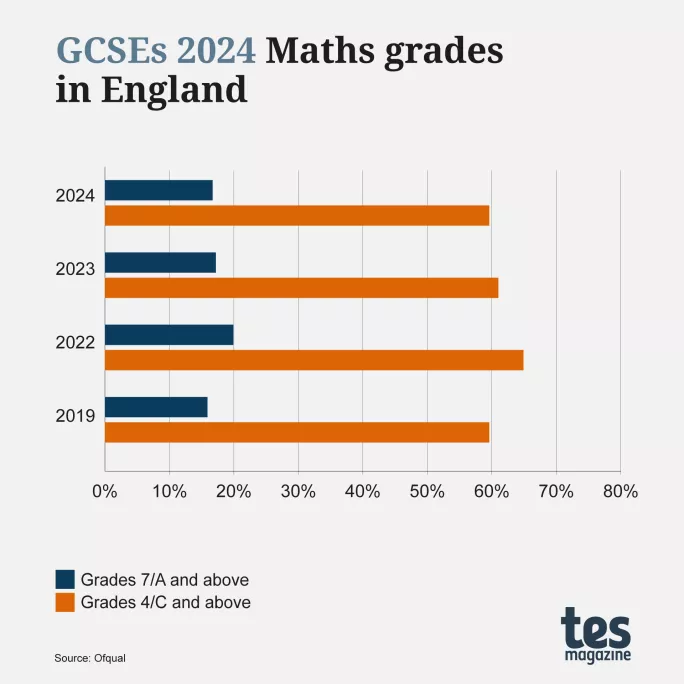
Meanwhile, 16.7 per cent received a grade 7/A or higher in maths GCSE this year - a decrease from 17.2 per cent who got the top grades in 2023 but above 15.9 per cent in 2019.
The 2023 GCSE results saw an uptick in the number of students failing to achieve grade 4 for English and maths and therefore an increase in those having to resit in November.
However, less than a quarter of the students who took GCSE maths in November 2023 passed - meaning the majority failed their resits .
Only 17.4 per cent of entries from students aged 17 or over achieved a grade 4/C in maths in England this year - slightly up from 16.4 per cent in 2023.

- GCSE results: English and maths pass rate down
- Why grades 1-3 are not a fail
- How much does attendance affect exam results?
- GCSE resits: everything you need to know
GCSE English language and literature
Like in maths, achieving that grade 4/C needed to pass English language is key for GCSE students.
This year, 61.6 per cent of entries managed to achieve a passing grade or higher in English language, a fall from last year when 64.2 per cent were awarded grade 4/C or above.
The English language overall pass rate was also slightly below 2019, when 61.8 per cent of entries passed English language.
However, much of this is driven by entries from students aged 17 or over who are likely resitting. In England, 20.9 per cent of entries from these students were awarded a grade 4/C - a drop from 25.9 per cent last year.
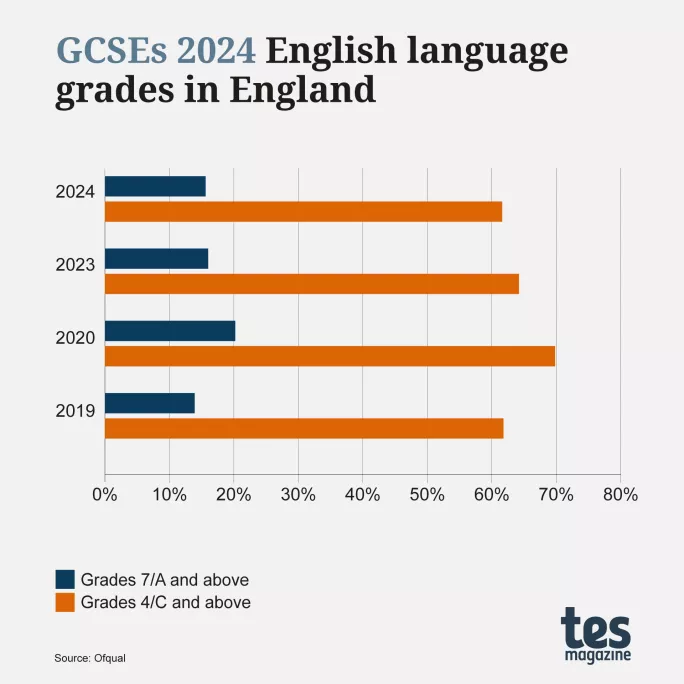
Speaking in a Joint Council for Qualifications briefing this morning, Claire Thomson, AQA’s director of regulation and compliance, said the drop in pass rates was “largely around the 17-year-olds and over who are skewing the distributions. If you look at just the 16-year-olds, they are very stable with minimal movement over the years”.
“The 17 and over cohort has grown and come back over pre-pandemic levels, which is altering the results,” she added.
For English literature, 73.7 per cent of overall entries achieved a grade 4/C or higher - down slightly from 73.9 per cent in 2023 but up slightly from 73.4 per cent in 2019.
In literature, 20.1 per cent achieved a grade 7/A or above, and 15.6 per cent in language. This compares with the 20.6 per cent who achieved grade 7/A in literature in 2023 and 16 per cent in language.
This year, teachers with students doing the Romeo and Juliet option in AQA’s English literature paper warned the extract students received was “difficult” and could leave some young people disadvantaged.

GCSE double science, biology, chemistry and physics
In the double science GCSE, the proportion of entries getting top grades (7/A and above) rose to 8.8 per cent from 8.5 per cent in 2023.
Meanwhile, 57.1 per cent of entries received a pass or higher in double science, compared with 56.6 per cent last year.

In the three sciences, the proportion getting the top grades increased slightly for physics and chemistry and remained the same for biology.
Along with GCSE maths, physics and combined science students were allowed to have formulae and equation sheets for another year.
This was to recognise the cohort had “experienced two years of national closures during secondary school”.
In biology, 42 per cent achieved the top grades - compared with 42 per cent in 2023 and 42.3 per cent in 2019.
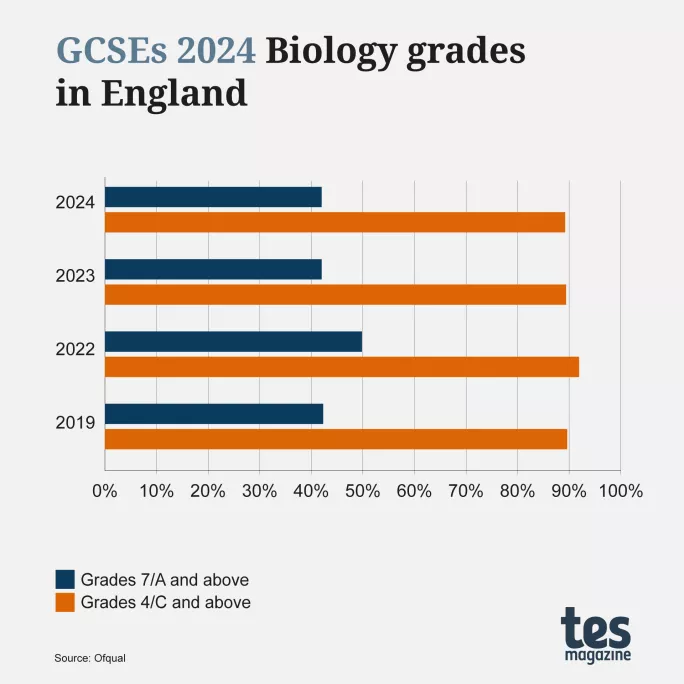
Meanwhile in physics, 44 per cent achieved the top grades - higher than the 43 per cent in 2023 and 43.8 per cent in 2019.
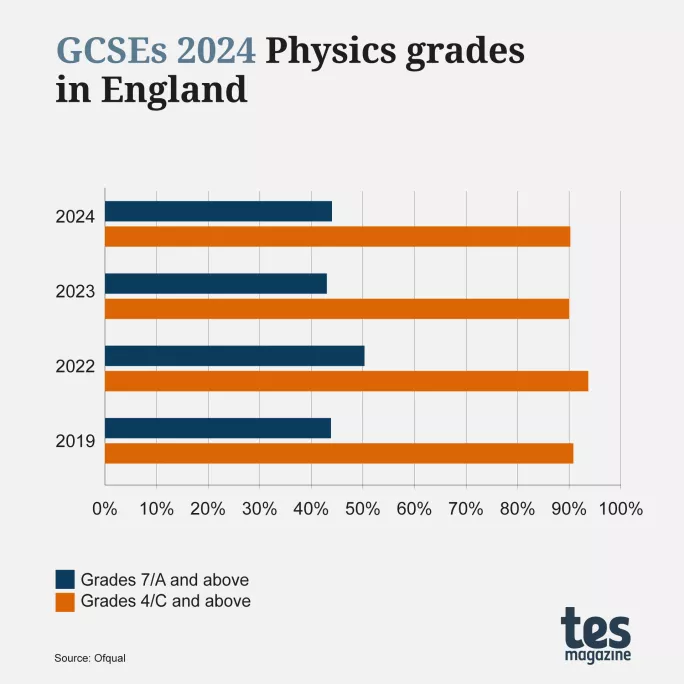
In chemistry, 44.7 per cent achieved the top grades - higher than the 43.6 per cent in 2023 and 43.9 per cent in 2019.
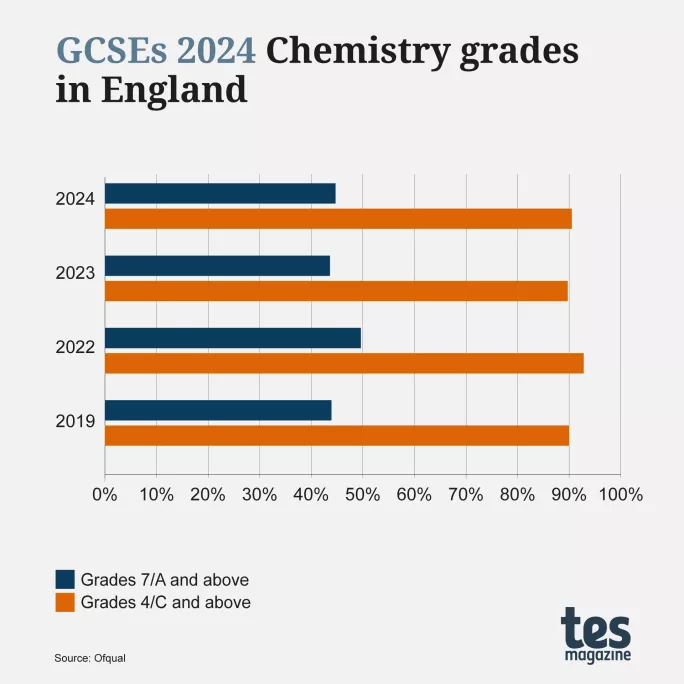
GCSE Spanish, French and German
The proportion of entries receiving top grades in modern foreign languages rose this year.
In Spanish, 26.7 per cent received a grade 7/A or higher and 69.8 per cent passed with a grade 4/C or higher. These are compared with 26.1 per cent that got the top grades in 2023 and 69.2 per cent that passed.
Adjustments were made to grading standards for French and German GCSEs again this year to better align results with Spanish.
Last year, exam boards were required by Ofqual to award more generously at grades 9, 7 and 4. This year, exam boards were asked to make further positive adjustments at the same grades for GCSE German, and grades 7 and 4 for French.
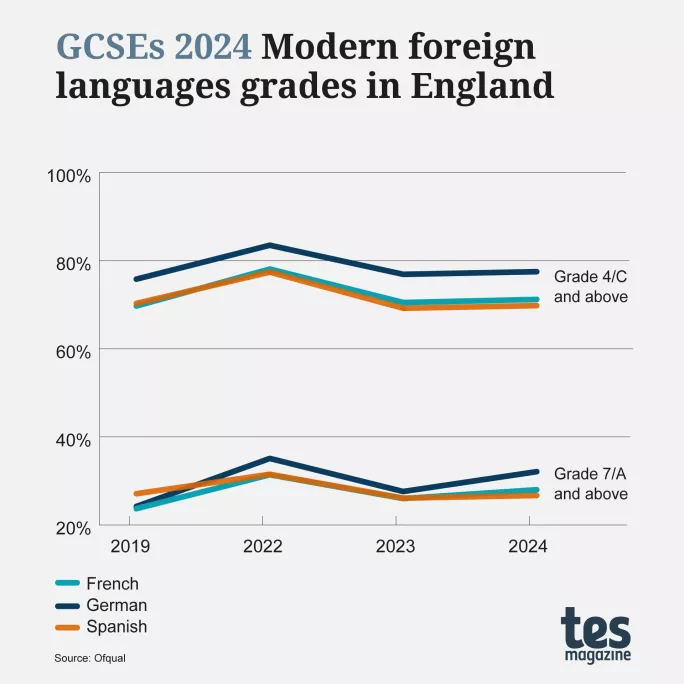
Considering this, 32.1 per cent achieved a grade 7/A above in German, compared with 27.6 per cent last year, and 28 per cent in French, up from 26 per cent in 2023.
The pass rate also increased. In French, 71.2 per cent were awarded a grade 4/C or higher - up from 70.5 per cent last year and 69.7 in 2019.
In German, 77.5 per cent passed - up from 76.9 per cent in 2023 and 75.8 per cent in 2019.
Just 9.3 per cent achieved a grade 9 in German GCSE last year, though this was up from 5.8 per cent in 2019. This has continued to rise to 10.4 per cent in 2024.
GCSE history and geography
This year, 25.8 per cent of entries scored the top grades (grade 7/A or above) in GCSE history.
This is an increase of 0.5 percentage points from 25.3 per cent in 2023.
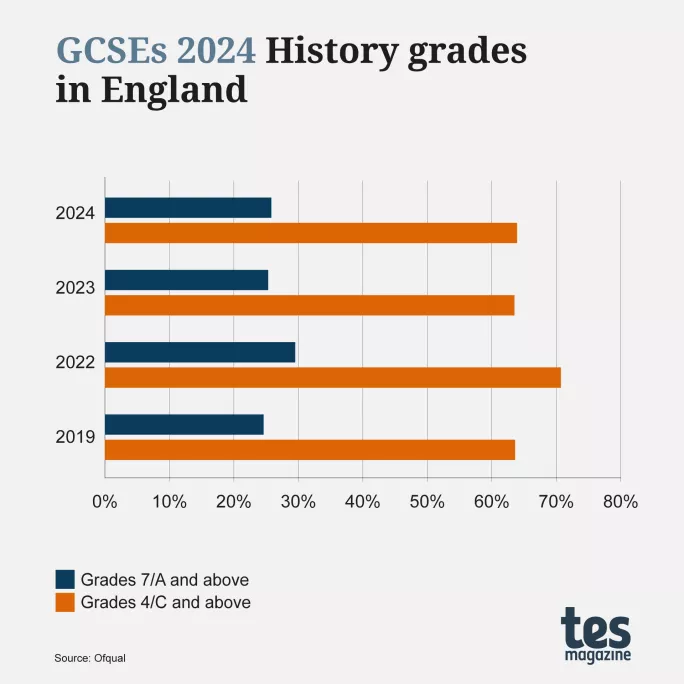
In geography, a similar proportion of entries achieved a grade 7/A or above at 24.5 per cent, the same as 24.5 per cent in both 2023 and 2019.
The pass rate in both GCSEs increased very slightly to 63.9 per cent in history and 65 per cent in geography.
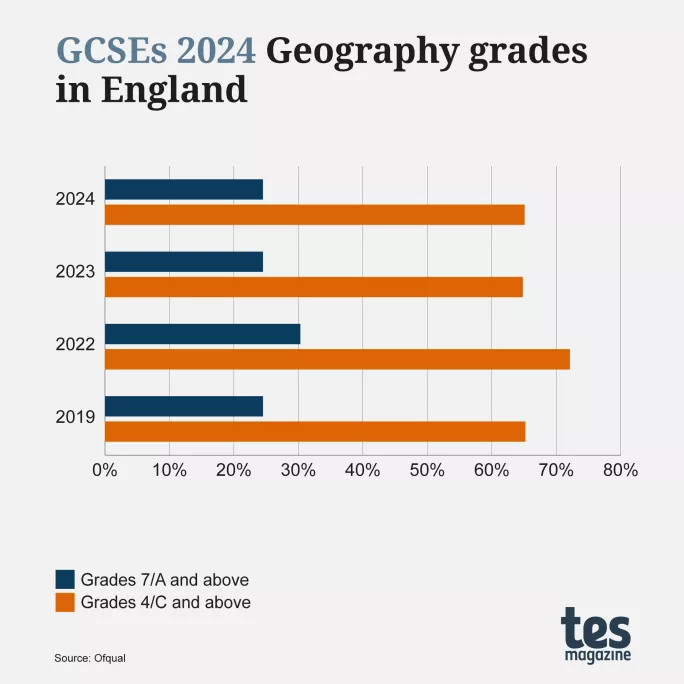
GCSE computing
Computing GCSE saw an increase in both the proportion of top grades and the pass rate for 2024.
This year, 28.3 per cent of entries were awarded a grade 7/A or above, and 68.3 per cent a grade 4/C or above.
This is compared with last year when 24.4 per cent of entries received a grade 7/A or higher in computing, and 64.6 per cent made grade 4/C or higher.
These were still slightly above 2019 levels when 21.6 per cent got at least a grade 7/A and 62.6 per cent achieved a grade 4/C or above.
After research into grading standards, Ofqual asked exam boards to award more generously at grades 9, 7 and 4 for computer science this year.
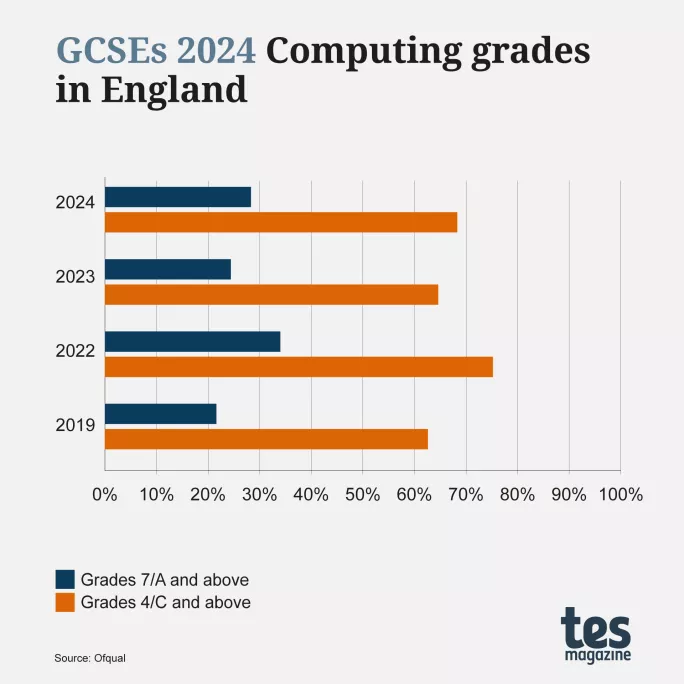
GCSE art and design, drama, music and design and technology
There was a mixed picture for the arts in terms of increases and decreases for 2024 compared with last year.
For art and design, 23.6 per cent got a grade 7/A or above and 76.3 per cent a grade 4/C or above. In 2023, 23.9 per cent of entries achieved a grade 7/A or above and 76.1 per cent got at least a grade 4/C.

Last year in design and technology, 64.8 per cent achieved a grade 4/C or higher, and 21 per cent got the top grades. This year saw some increases, with 22.4 per cent getting the top grades and 65.6 per cent achieving a pass of grade 4/C or better.
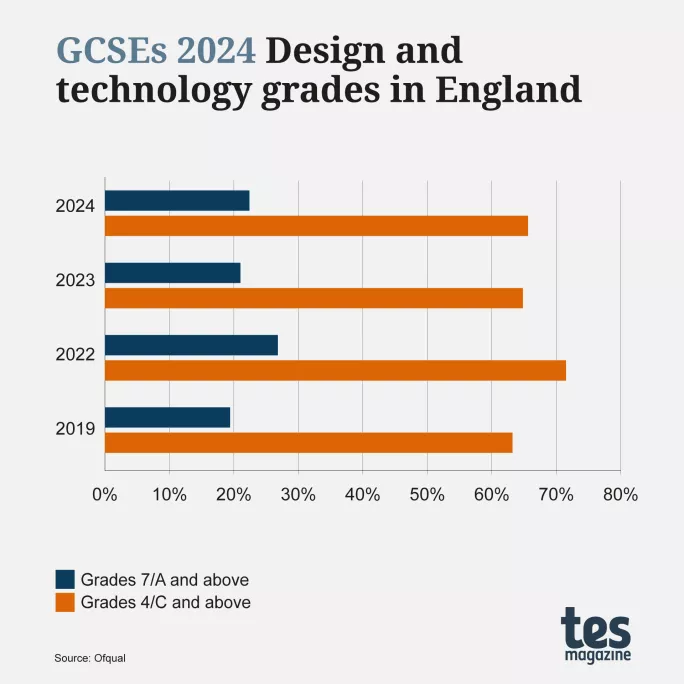
Meanwhile, music top grades decreased slightly from 33.3 per cent in 2023 to 32.9 per cent this year. Last year, 76.4 per cent of students received a grade 4/C or higher, and this only decreased slightly to 75.9 per cent this year.
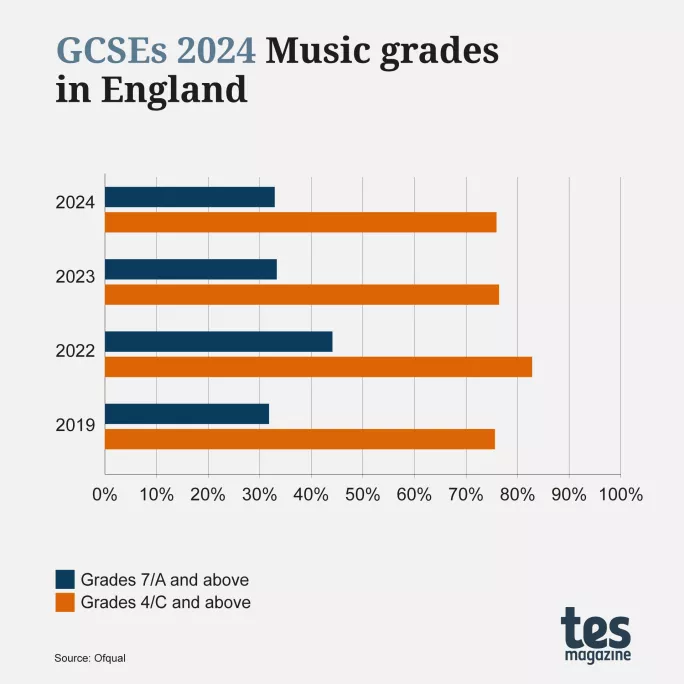
Similarly, in drama for 2024, 76.7 per cent achieved a passing grade. In 2023, 75.9 per cent achieved a grade 4/C and up.
In the top grades, 26.9 per cent of students got at least a grade 7/A this year, a small increase on 2023 when the figure was 25.8 per cent.
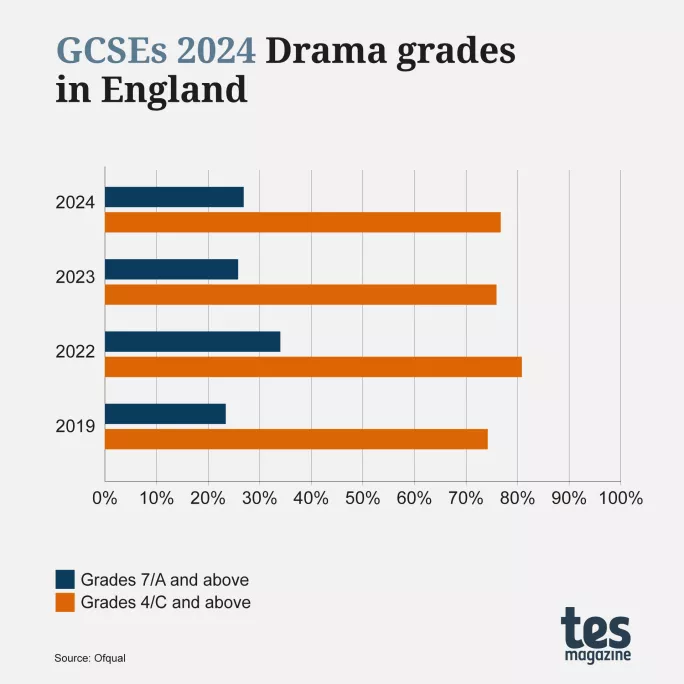
GCSE PE saw 23 per cent of entries awarded a grade 7/A or above and 72.1 per cent getting a grade 4/C or above.
This is relatively similar compared to 2023, when 22.7 per cent of entries received the top grades and 72.4 per cent achieved a grade 4/C or higher.
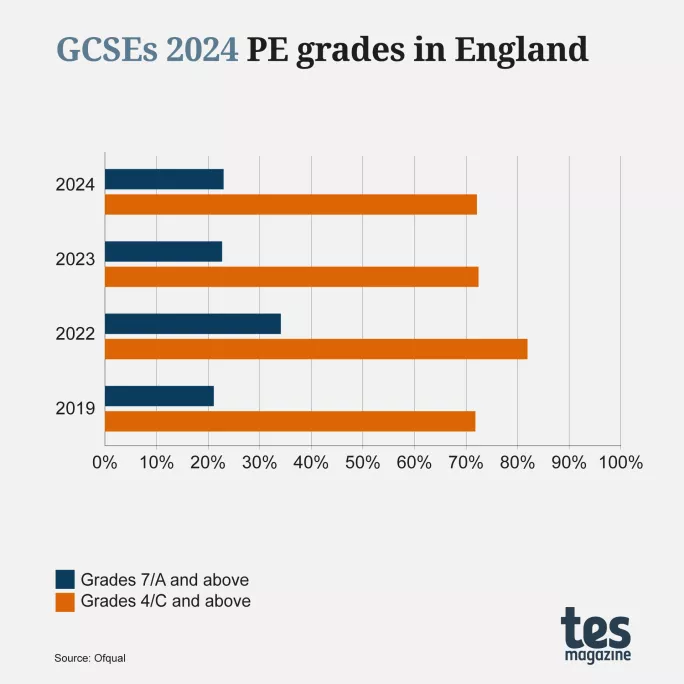
For the latest education news and analysis delivered every weekday morning, sign up for the Tes Daily newsletter
Want to keep reading for free?
Register with Tes and you can read two free articles every month plus you'll have access to our range of award-winning newsletters.
Keep reading for just £1 per month
You've reached your limit of free articles this month. Subscribe for £1 per month for three months and get:
- Unlimited access to all Tes magazine content
- Exclusive subscriber-only stories
- Award-winning email newsletters
topics in this article

Get the Reddit app
Got a question about going to uni in the UK? Want to find out more and speak to others about their course/uni? Not sure if you can eat something that's been loafing in your fridge for 3 weeks, and gone a dubious shade of purple-green? This is the place for you. If you want to post a survey for your dissertation, please make sure your post includes all information required by the rules linked in our wiki!
Can I write a 1500 word essay in 2 days?
I have an essay deadline in 2 days time and I've done a ton of research, but I feel like I still don't know enough to start writing it. Any tips/advice?
By continuing, you agree to our User Agreement and acknowledge that you understand the Privacy Policy .
Enter the 6-digit code from your authenticator app
You’ve set up two-factor authentication for this account.
Enter a 6-digit backup code
Create your username and password.
Reddit is anonymous, so your username is what you’ll go by here. Choose wisely—because once you get a name, you can’t change it.
Reset your password
Enter your email address or username and we’ll send you a link to reset your password
Check your inbox
An email with a link to reset your password was sent to the email address associated with your account
Choose a Reddit account to continue
Best Exercises for Health and Weight Loss
How to start exercising and stick to it, how to exercise with limited mobility, home workout and fitness tips: exercising without the gym, walking: an easy way to get fit, how to build an exercise plan, dog walking: the health benefits of walks with your dog, senior exercise and fitness tips.
- Online Therapy: Is it Right for You?
- Mental Health
- Health & Wellness
- Children & Family
- Relationships
Are you or someone you know in crisis?
- Bipolar Disorder
- Eating Disorders
- Grief & Loss
- Personality Disorders
- PTSD & Trauma
- Schizophrenia
- Therapy & Medication
- Exercise & Fitness
- Healthy Eating
- Well-being & Happiness
- Weight Loss
- Work & Career
- Illness & Disability
- Heart Health
- Learning Disabilities
- Family Caregiving
- Teen Issues
- Communication
- Emotional Intelligence
- Love & Friendship
- Domestic Abuse
- Healthy Aging
- Alzheimer’s Disease & Dementia
- End of Life
- Meet Our Team
What are the mental health benefits of exercise?
Other mental health benefits of exercise, reaping the mental health benefits of exercise is easier than you think, overcoming obstacles to exercise, getting started with exercise when you have a mental health issue.
- Easy ways to move more that don't involve the gym
The Mental Health Benefits of Exercise
You already know that exercise is good for your body. But did you know it can also boost your mood, improve your sleep, and help you deal with depression, anxiety, stress, and more?

Exercise is not just about aerobic capacity and muscle size. Sure, exercise can improve your physical health and your physique, trim your waistline, improve your sex life, and even add years to your life. But that’s not what motivates most people to stay active.
People who exercise regularly tend to do so because it gives them an enormous sense of well-being. They feel more energetic throughout the day, sleep better at night, have sharper memories, and feel more relaxed and positive about themselves and their lives. And it’s also a powerful medicine for many common mental health challenges.
Regular exercise can have a profoundly positive impact on depression, anxiety, and ADHD. It also relieves stress, improves memory, helps you sleep better, and boosts your overall mood. And you don’t have to be a fitness fanatic to reap the benefits. Research indicates that modest amounts of exercise can make a real difference. No matter your age or fitness level, you can learn to use exercise as a powerful tool to deal with mental health problems, improve your energy and outlook, and get more out of life.
Exercise and depression
Studies show that exercise can treat mild to moderate depression as effectively as antidepressant medication—but without the side-effects, of course. As one example, a recent study done by the Harvard T.H. Chan School of Public Health found that running for 15 minutes a day or walking for an hour reduces the risk of major depression by 26%. In addition to relieving depression symptoms , research also shows that maintaining an exercise schedule can prevent you from relapsing.
Exercise is a powerful depression fighter for several reasons. Most importantly, it promotes all kinds of changes in the brain, including neural growth, reduced inflammation, and new activity patterns that promote feelings of calm and well-being. It also releases endorphins, powerful chemicals in your brain that energize your spirits and make you feel good. Finally, exercise can also serve as a distraction, allowing you to find some quiet time to break out of the cycle of negative thoughts that feed depression.
Exercise and anxiety
Exercise is a natural and effective anti-anxiety treatment . It relieves tension and stress, boosts physical and mental energy, and enhances well-being through the release of endorphins. Anything that gets you moving can help, but you’ll get a bigger benefit if you pay attention instead of zoning out.
Try to notice the sensation of your feet hitting the ground, for example, or the rhythm of your breathing, or the feeling of the wind on your skin. By adding this mindfulness element—really focusing on your body and how it feels as you exercise—you’ll not only improve your physical condition faster, but you may also be able to interrupt the flow of constant worries running through your head.
Exercise and stress
Ever noticed how your body feels when you’re under stress ? Your muscles may be tense, especially in your face, neck, and shoulders, leaving you with back or neck pain, or painful headaches. You may feel a tightness in your chest, a pounding pulse, or muscle cramps. You may also experience problems such as insomnia, heartburn, stomachache, diarrhea, or frequent urination. The worry and discomfort of all these physical symptoms can in turn lead to even more stress, creating a vicious cycle between your mind and body.
Exercising is an effective way to break this cycle. As well as releasing endorphins in the brain, physical activity helps to relax the muscles and relieve tension in the body. Since the body and mind are so closely linked, when your body feels better so, too, will your mind.
Exercise and ADHD
Exercising regularly is one of the easiest and most effective ways to reduce the symptoms of ADHD and improve concentration, motivation, memory, and mood. Physical activity immediately boosts the brain’s dopamine, norepinephrine, and serotonin levels—all of which affect focus and attention. In this way, exercise works in much the same way as ADHD medications such as Ritalin and Adderall.
Exercise and PTSD and trauma
Evidence suggests that by really focusing on your body and how it feels as you exercise, you can actually help your nervous system become “unstuck” and begin to move out of the immobilization stress response that characterizes PTSD or trauma. Instead of allowing your mind to wander, pay close attention to the physical sensations in your joints and muscles, even your insides as your body moves. Exercises that involve cross movement and that engage both arms and legs—such as walking (especially in sand), running, swimming, weight training, or dancing—are some of your best choices.
Outdoor activities like hiking, sailing, mountain biking, rock climbing, whitewater rafting, and skiing (downhill and cross-country) have also been shown to reduce the symptoms of PTSD.
Speak to a Licensed Therapist
BetterHelp is an online therapy service that matches you to licensed, accredited therapists who can help with depression, anxiety, relationships, and more. Take the assessment and get matched with a therapist in as little as 48 hours.
Even if you’re not suffering from a mental health problem, regular physical activity can still offer a welcome boost to your mood, outlook, and mental well-being.
Exercise can help provide:
Sharper memory and thinking. The same endorphins that make you feel better also help you concentrate and feel mentally sharp for tasks at hand. Exercise also stimulates the growth of new brain cells and helps prevent age-related decline .
Higher self-esteem. Regular activity is an investment in your mind, body, and soul. When it becomes habit, it can foster your sense of self-worth and make you feel strong and powerful. You’ll feel better about your appearance and, by meeting even small exercise goals, you’ll feel a sense of achievement.
Better sleep. Even short bursts of exercise in the morning or afternoon can help regulate your sleep patterns . If you prefer to exercise at night, relaxing exercises such as yoga or gentle stretching can help promote sleep.
More energy. Increasing your heart rate several times a week will give you more get-up-and-go. Start off with just a few minutes of exercise per day, and increase your workout as you feel more energized.
Stronger resilience. When faced with mental or emotional challenges in life, exercise can help you build resilience and cope in a healthy way, instead of resorting to alcohol, drugs, or other negative behaviors that ultimately only make your symptoms worse. Regular exercise can also help boost your immune system and reduce the impact of stress.
You don’t need to devote hours out of your busy day to train at the gym, sweat buckets, or run mile after monotonous mile to reap all the physical and mental health benefits of exercise. Just 30-minutes of moderate exercise five times a week is enough. And even that can be broken down into two 15-minute or even three 10-minute exercise sessions if that’s easier.
Even a little bit of activity is better than nothing
If you don’t have time for 15 or 30 minutes of exercise, or if your body tells you to take a break after 5 or 10 minutes, for example, that’s okay, too. Start with 5- or 10-minute sessions and slowly increase your time. The more you exercise, the more energy you’ll have, so eventually you’ll feel ready for a little more. The key is to commit to some moderate physical activity—however little—on most days. As exercising becomes a habit, you can slowly add extra minutes or try different types of activities. If you keep at it, the benefits of exercise will begin to pay off.
You don’t have to suffer to get results
Research shows that moderate levels of exercise are best for most people . Moderate means:
- That you breathe a little heavier than normal, but are not out of breath. For example, you should be able to chat with your walking partner, but not easily sing a song.
- That your body feels warmer as you move, but not overheated or very sweaty.
Can’t find time to exercise during the week? Be a weekend warrior
A recent study in the United Kingdom found that people who squeeze their exercise routines into one or two sessions during the weekend experience almost as many health benefits as those who work out more often. So don’t let a busy schedule at work, home, or school be an excuse to avoid activity. Get moving whenever you can find the time—your mind and body will thank you!
Even when you know that exercise will help you feel better, taking that first step is still easier said than done. Obstacles to exercising are very real—particularly when you’re also struggling with a mental health issue.
Here are some common barriers and how you can get past them.
Feeling exhausted. When you’re tired, depressed, or stressed, it seems that working out will just make you feel worse. But the truth is that physical activity is a powerful energizer. Studies show that regular exercise can dramatically reduce fatigue and increase your energy levels. If you are really feeling tired, promise yourself a quick, 5-minute walk. Chances are, once you get moving you’ll have more energy and be able to walk for longer.
Feeling overwhelmed. When you’re stressed or depressed, the thought of adding another obligation to your busy daily schedule can seem overwhelming. Working out just doesn’t seem practical. If you have children, finding childcare while you exercise can also be a big hurdle. However, if you begin thinking of physical activity as a priority (a necessity for your mental well-being), you’ll soon find ways to fit small amounts of exercise into even the busiest schedule.
Feeling hopeless. Even if you’ve never exercised before, you can still find ways to comfortably get active. Start slow with easy, low-impact activities a few minutes each day, such as walking or dancing.
Feeling bad about yourself. Are you your own worst critic? It’s time to try a new way of thinking about your body. No matter your weight, age or fitness level, there are plenty of others in the same boat. Ask a friend to exercise with you. Accomplishing even the smallest fitness goals will help you gain body confidence and improve how you think about yourself.
Feeling pain. If you have a disability, severe weight problem, arthritis, or any injury or illness that limits your mobility, talk to your doctor about ways to safely exercise . You shouldn’t ignore pain, but rather do what you can, when you can. Divide your exercise into shorter, more frequent chunks of time if that helps, or try exercising in water to reduce joint or muscle discomfort.
Many of us find it hard enough to motivate ourselves to exercise at the best of times. But when you feel depressed, anxious, stressed or have another mental health problem, it can seem doubly difficult. This is especially true of depression and anxiety, which can leave you feeling trapped in a catch-22 situation. You know exercise will make you feel better, but depression has robbed you of the energy and motivation you need to work out, or your social anxiety means you can’t bear the thought of being seen at an exercise class or running through the park.
Start small. When you’re under the cloud of anxiety or depression and haven’t exercised for a long time, setting extravagant goals like completing a marathon or working out for an hour every morning will only leave you more despondent if you fall short. Better to set achievable goals and build up from there.
Schedule workouts when your energy is highest. Perhaps you have most energy first thing in the morning before work or school or at lunchtime before the mid-afternoon lull hits? Or maybe you do better exercising for longer at the weekends. If depression or anxiety has you feeling tired and unmotivated all day long, try dancing to some music or simply going for a walk. Even a short, 15-minute walk can help clear your mind, improve your mood, and boost your energy level. As you move and start to feel a little better, you’ll often boost your energy enough to exercise more vigorously—by walking further, breaking into a run, or adding a bike ride, for example.
Focus on activities you enjoy. Any activity that gets you moving counts. That could include throwing a Frisbee with a dog or friend, walking laps of a mall window shopping, or cycling to the grocery store. If you’ve never exercised before or don’t know what you might enjoy, try a few different things. Activities such as gardening or tackling a home improvement project can be great ways to start moving more when you have a mood disorder—as well as helping you become more active, they can also leave you with a sense of purpose and accomplishment.
Be comfortable. Wear clothing that’s comfortable and choose a setting that you find calming or energizing. That may be a quiet corner of your home, a scenic path, or your favorite city park.
Reward yourself. Part of the reward of completing an activity is how much better you’ll feel afterwards, but it always helps your motivation to promise yourself an extra treat for exercising. Reward yourself with a hot bubble bath after a workout, a delicious smoothie, or with an extra episode of your favorite TV show, for example.
Make exercise a social activity. Exercising with a friend or loved one, or even your kids, will not only make exercising more fun and enjoyable, it can also help motivate you to stick to a workout routine. You’ll also feel better than if you were exercising alone. In fact, when you’re suffering from a mood disorder such as depression, the companionship can be just as important as the exercise.
Easy ways to move more that don’t involve the gym
Don’t have a 30-minute block of time to dedicate to yoga or a bike ride? Don’t worry. Think about physical activity as a lifestyle rather than just a single task to check off your to-do list. Look at your daily routine and consider ways to sneak in activity here, there, and everywhere.
Move in and around your home. Clean the house, wash the car, tend to the yard and garden, mow the lawn with a push mower, sweep the sidewalk or patio with a broom.
Sneak activity in at work or on the go. Bike or walk to an appointment rather than drive, use stairs instead of elevators, briskly walk to the bus stop then get off one stop early, park at the back of the lot and walk into the store or office, or take a vigorous walk during your coffee break.
Get active with the family. Jog around the soccer field during your kid’s practice, make a neighborhood bike ride part of your weekend routine, play tag with your children in the yard, go canoeing at a lake, walk the dog in a new place.
Get creative with exercise ideas. Pick fruit at an orchard, boogie to music, go to the beach or take a hike, gently stretch while watching television, organize an office bowling team, take a class in martial arts, dance, or yoga.
Make exercise a fun part of your everyday life
You don’t have to spend hours in a gym or force yourself into long, monotonous workouts to experience the many benefits of exercise. These tips can help you find activities you enjoy and start to feel better, look better, and get more out of life.
More Information
- Greer, T. L., Trombello, J. M., Rethorst, C. D., Carmody, T. J., Jha, M. K., Liao, A., Grannemann, B. D., Chambliss, H. O., Church, T. S., & Trivedi, M. H. (2016). Improvements in psychosocial functioning and health-related quality of life following exercise augmentation in patients with treatment response but non-remitted major depressive disorder: Results from the TREAD study. Depression and Anxiety, 33(9), 870–881. Link
- Kandola, A., Vancampfort, D., Herring, M., Rebar, A., Hallgren, M., Firth, J., & Stubbs, B. (2018). Moving to Beat Anxiety: Epidemiology and Therapeutic Issues with Physical Activity for Anxiety. Current Psychiatry Reports, 20(8), 63. Link
- Aylett, E., Small, N., & Bower, P. (2018). Exercise in the treatment of clinical anxiety in general practice – a systematic review and meta-analysis. BMC Health Services Research, 18(1), 559. Link
- Stubbs, B., Vancampfort, D., Rosenbaum, S., Firth, J., Cosco, T., Veronese, N., Salum, G. A., & Schuch, F. B. (2017). An examination of the anxiolytic effects of exercise for people with anxiety and stress-related disorders: A meta-analysis. Psychiatry Research, 249, 102–108. Link
- Kandola, A. A., Osborn, D. P. J., Stubbs, B., Choi, K. W., & Hayes, J. F. (2020). Individual and combined associations between cardiorespiratory fitness and grip strength with common mental disorders: A prospective cohort study in the UK Biobank. BMC Medicine, 18(1), 303. Link
More in Exercise & Fitness
Tips for building a fitness plan, and finding the best exercises for you

How to make exercise a part of your everyday life

Chair exercises and fitness tips for people with injuries or disabilities

Even when your schedule changes, you can stay physically fit

How to reap the health benefits of walking

A guide to getting started and developing a balanced plan

Here’s how walking with your pooch can benefit you as well

No matter your age, it’s never too late to get started

Professional therapy, done online
BetterHelp makes starting therapy easy. Take the assessment and get matched with a professional, licensed therapist.
Help us help others
Millions of readers rely on HelpGuide.org for free, evidence-based resources to understand and navigate mental health challenges. Please donate today to help us save, support, and change lives.

COMMENTS
And the result was a coherent paper that was easy to revise. Meanwhile, this paper-a-week approach is my favorite. That's how I write my papers, and that's what I teach to students. In on-site courses young scientists draft a whole paper in 5 days, writing one major section per day. At the beginning of the week, many participants have doubts.
How to Write a 6-to-12-Page Essay in a Matter of Hours. Schedule your time. Compose your thesis and intro paragraph. Do your research. Write your body paragraphs. Create a conclusion. Take a troubleshooting break. Add your finishing touches.
First, form your thesis statement. It's something you will prove throughout the research paper. The preliminary research provided you with enough resources. Keep in mind that professors don't like broad thesis statement. If, for example, the prompt was related to World War 2, you'll have to narrow it down.
4. Write Your Thesis: A thesis statement is the gist of your entire paper. It is what you will spend your writing proving; therefore, it has to be strong and to the point. A thesis statement appears in the introduction of your research paper, following the strong hook statement that draws your readers in.
Writing an eight page paper in two days was surprisingly easy with a well-developed outline. Do yourself a favor and spend the bulk of your time in the "planning" stage of an essay: reading, summarizing, outlining, and discussing ideas with classmates and professors. The actual writing process will be a matter of a few hours spent at your ...
Step 1: Lay Out the Facts. You have worked long hours on a research project that has produced results and are no doubt curious to determine what they exactly mean. There is no better way to do this than by preparing figures, graphics and tables. This is what the first LEAP step is focused on - diving into the results.
Step 1: Find a topic and review the literature. As we mentioned earlier, in a research paper, you, as the researcher, will try to answer a question.More specifically, that's called a research question, and it sets the direction of your entire paper. What's important to understand though is that you'll need to answer that research question with the help of high-quality sources - for ...
How To Write a Research Paper QUICKLY | Advice from a PhD Student Current Subscriber Count: 20,442_____ TIM...
Few things strike more fear in academics than the accursed research paper, a term synonymous with long hours and hard work.Luckily there's a secret to help you get through them. As long as you know how to write a research paper properly, you'll find they're not so bad . . . or at least less painful.. In this guide we concisely explain how to write an academic research paper step by step.
Having a plan in place can help you feel better and write a stronger research paper. It's best to schedule two days for each step of the process. Getting your research paper done in a timely, efficient manner usually takes about two weeks, depending on the length of the essay. Step 3: Choose a Research Paper Topic
It's possible to actually DO a research paper in a day. I researched and wrote a 10 page (~2500 word) paper for an Anthropology course in 24 hours. The key is to be very thorough and meticulous on your research. Get each small bit on note cards and use them to create the paper.
1. Create a Schedule to Maximize Your Time. You've likely already spent time panicking. Once you calm yourself of the anxiety of having to finish a 10- or 20-page paper in one night, organize your plan of attack. First, you should designate an area free of distractions so that you can focus.
Choose a research paper topic. There are many ways to generate an idea for a research paper, from brainstorming with pen and paper to talking it through with a fellow student or professor.. You can try free writing, which involves taking a broad topic and writing continuously for two or three minutes to identify absolutely anything relevant that could be interesting.
Definition: Research Paper is a written document that presents the author's original research, analysis, and interpretation of a specific topic or issue. It is typically based on Empirical Evidence, and may involve qualitative or quantitative research methods, or a combination of both. The purpose of a research paper is to contribute new ...
Two days ago I wrote an 11 page paper, combined with an 11 page annotated bibliography, in about 10 hours, which was not particularly fun but certainly doable with leftover energy and motivation to spare. I tend to do my classwork in binges, writing 5-10 pages in a single sitting and finishing papers in 1-3 dedicated workdays.
1.45pm - 6pm: Write the body of the essay. 6pm - 6.45pm: Dinner break. 6.45pm - 10.30pm: Edit, improve and meet the word count. 10.30pm - 11pm: Print (if needed) and get everything ready for the morning. Remember to schedule a few short 10-minute breaks (one every 45-60 minutes should do the trick).
To write an informative abstract you have to provide the summary of the whole paper. Informative summary. In other words, you need to tell about the main points of your work, the methods used, the results and the conclusion of your research. To write a descriptive abstract you will not have to provide any summery.
Read on to read some basic tips on writing a good title for your research paper: 3 Basic tips on writing a good research paper title. I hope you found the tips useful. Writing a good title for a research paper comprises a few basic steps as well. ... Gone are the days when tough prose was the only way to express research work. With the coming ...
If you have to produce 10,000 words in ten days, you have to average 1,000 a day. If you have two days, then 5,000 per day and if you work on it for 12 hours each of those days, you need to turn out 417 words per hour. A tall order, but it can be done.
This interactive resource from Baylor University creates a suggested writing schedule based on how much time a student has to work on the assignment. "Research Paper Planner" (UCLA) UCLA's library offers this step-by-step guide to the research paper writing process, which also includes a suggested planning calendar.
I procrastinated 3 months away and did 90% of the research and writing in about one month for my 40 page minimum master's thesis. You can see a flurry of activity on my github in the 1-1.5 weeks of writing. I'm now doing a PhD straight out of my master's. You'll be okay.
MIT postdocs Shinya Imada and Saleh Khawaled are the lead authors of the paper, which appears today in Nature. Driving regeneration. ... The researchers followed three groups of mice — one that fasted for 24 hours, another one that fasted for 24 hours and then was allowed to eat whatever they wanted during a 24-hour refeeding period, and a ...
APA Style provides a foundation for effective scholarly communication because it helps writers present their ideas in a clear, concise, and inclusive manner. When style works best, ideas flow logically, sources are credited appropriately, and papers are organized predictably. People are described using language that affirms their worth and dignity.
Climate change is expected to influence urban living conditions, challenging cities to adopt mitigation and adaptation measures. This paper assesses climate change projections for different urban areas in Europe -Eindhoven (The Netherlands), Genova (Italy) and Tampere (Finland)—and discusses how nature-based solutions (NBS) can help climate change adaptation in these cities. The Weather ...
New research shows that rainwater could have helped create a meshy wall around protocells 3.8 billion years ago, a critical step in the transition from tiny beads of RNA to every bacterium, plant ...
take notes, build them up and organize them to make a detailed outline, and then fill it in with complete sentences. much better than trying to write start to finish. Reply reply. Rutabaga-Livid. •. Starting the paper more than 3 days in advance is normally the best way. Reply reply. Realistic_Ad2436. •.
All forecasts are initialized at 2020-08-22T12z, chosen to highlight Hurricane Laura, the most damaging Atlantic hurricane of 2020. a, Specific humidity at 700 hPa for 1-day, 5-day and 10-day ...
This year, 28.3 per cent of entries were awarded a grade 7/A or above, and 68.3 per cent a grade 4/C or above. This is compared with last year when 24.4 per cent of entries received a grade 7/A or higher in computing, and 64.6 per cent made grade 4/C or higher.
Yes. I'd never recommend someone try to do it in just 2 days, but 1500 words really isn't a huge amount. Especially if you've already done all the work. I knocked out 3 mini-essays all 1000 words each + all relevant research in about 7 hours over Christmas. Again, wouldn't recommend.
As one example, a recent study done by the Harvard T.H. Chan School of Public Health found that running for 15 minutes a day or walking for an hour reduces the risk of major depression by 26%. In addition to relieving depression symptoms, research also shows that maintaining an exercise schedule can prevent you from relapsing.